




Your new environment is unique. We understand what you need to know to be successful in PNG, and how to manage and enjoy both your business and private lives.
That's why we've provided the "Welcome Guide to Port Moresby" - the most comprehensive and up-to-date source of information you'll need. It's another reason why BSP is the number one choice for banking in Papua New Guinea and the South Pacific.
Contact us to obtain your copy today - bringing your bank closer, with hundreds of ATMs and more branches in more locations throughout PNG.
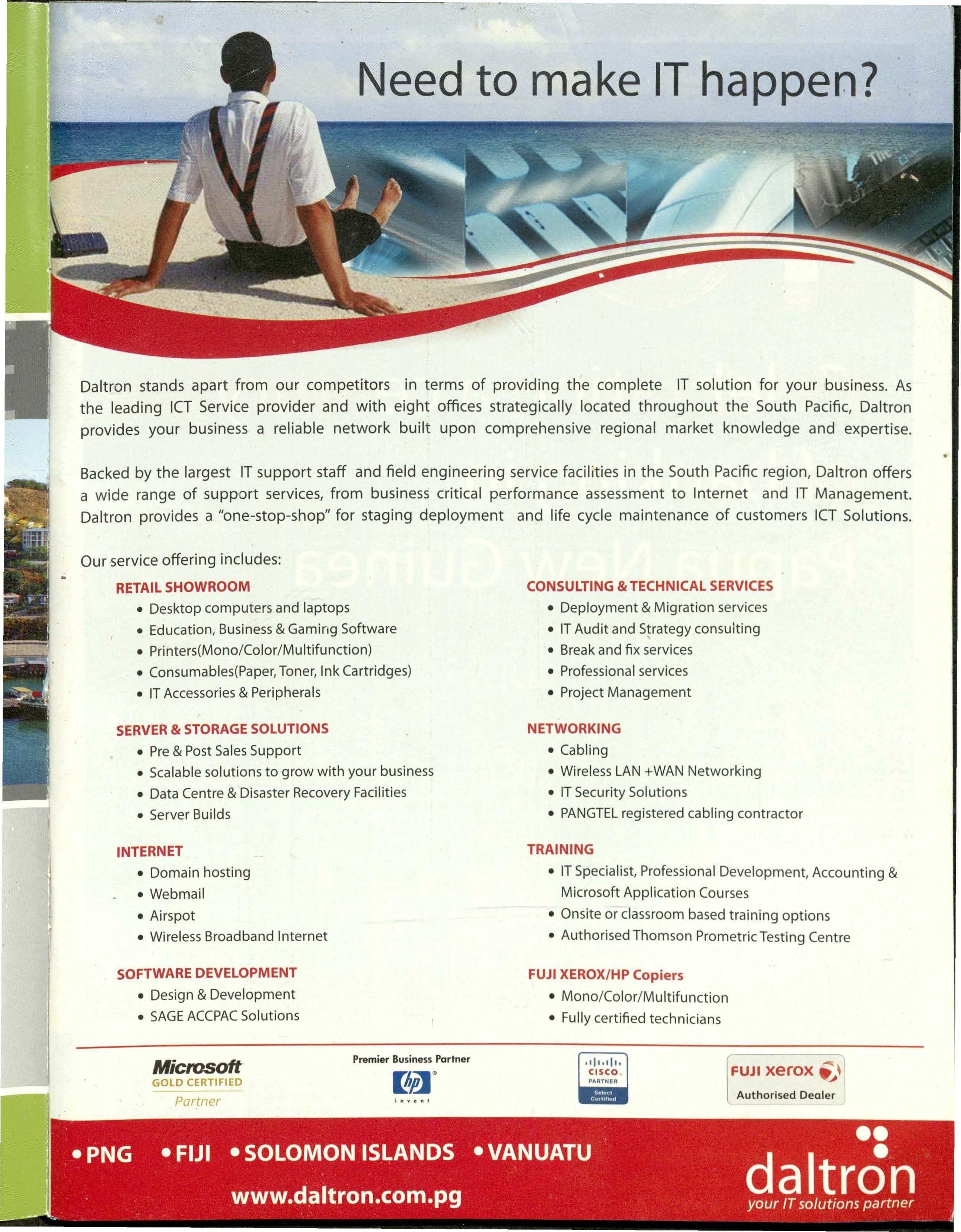
Daltron stands apart from our competitors in terms of providing the complete IT solution for your business. As the leading ICT Service provider and with eight offices strategically located throughout the South Pacific, Daltron provides your business a reliable network built upon comprehensive regional market knowledge and expertise.
Backed by the largest IT support staff and field engineering service facilities in the South Pacific region, Daltron offers a wide range of support services, from business critical performance assessment to Internet and IT Management. Daltron provides a "one-stop-shop" for staging deployment and life cycle maintenance of customers ICT Solutions.
Our service offering includes:
RETAIL SHOWROOM
• Desktop computers and laptops
• Education, Business& Gaming Software
• Printers(Mono/Color/Multifunction)
• Consumables(Paper,Toner, Ink Cartridges)
• IT Accessories& Peripherals
SERVER & STORAGE SOLUTIONS
• Pre & Post SalesSupport
• Scalable solutions to grow with your business
• Data Centre & Disaster Recovery Facilities
• Server Builds
INTERNET
• Domain hosting
• Webmail
• Airspot
• Wireless Broadband Internet
SOFTWARE DEVELOPMENT
• Design & Development
• SAGEACCPACSolutions
CERTIFIED
CONSULTING & TECHNICAL SERVICES
• Deployment & Migration services
• IT Audit and Strategy consulting
• Breakand fix services
• Professionalservices
• Project Management
NETWORKING
• Cabling
• Wireless LAN +WAN Networking
• IT Security Solutions
• PANGTELregistered cabling contractor
TRAINING
• IT Specialist, Professional Development, Accounting & Microsoft Application Courses
• Onsite or classroom based training options
• Authorised Thomson Prometric Testing Centre
FUJI XEROX/HP Copiers
• Mono/Colar/Multifunction
• Fully certified technicians

Steamshipshave been shipping in PapuaNew Guineafor over 90 years.We operate a fleet of coastal vessels and specialise in estuarine and river trades in the Gulf and Western Provinces.Steamships provides short and long term vessel charters, and reliable cargo liner services using geared, multipurpose vessels.The company can also develop, implement and support inter-modal logistics shipping solutions, linked to land based servicessuch as road transport, cargo handling and storage.
In addition to owning vesselsand providingdomesticcoastalshippingservices,Steamshipsis a shareholder and manager of stevedoring companiesat seven of the country's ports, where it also operates the largest shipping agencybusiness. As Swire Shipping'sin-countryrepresentative,Steamshipscan offer a range of international shipping servicesto and from North and South EastAsia,Australia, New Zealand and the Pacific Islands with the network extending to Europeand the west coast of North America. All services are provided by flexible, multipurpose ships offering hold configurations and cranes designedspecificallyto carry a range of commodities,containerised,break bulk and project cargoes.
Steamships - our experience,capabilityand capacitymakeus the ideal shippingpartner.
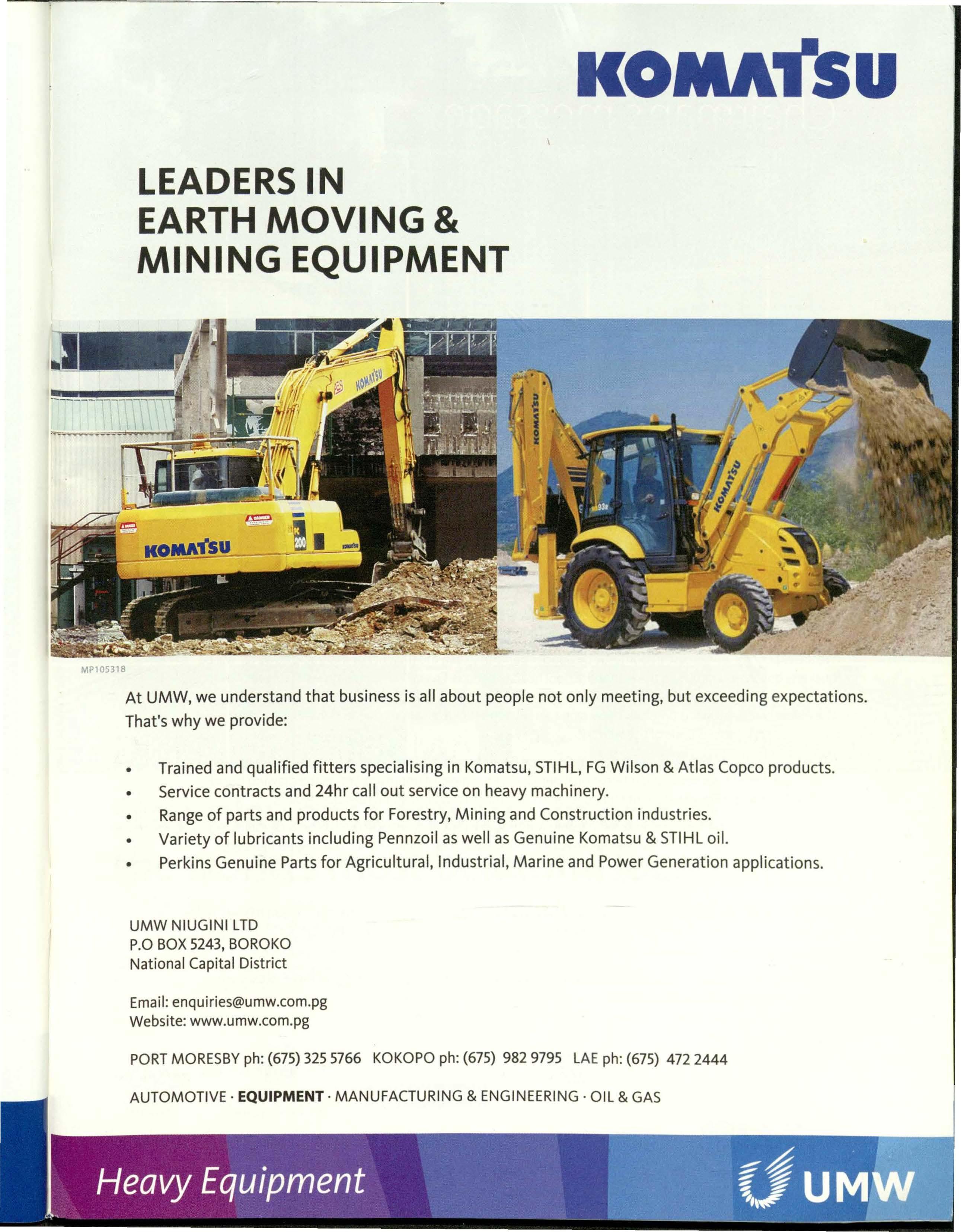
At UMW, we understand that business is all about people not only meeting, but exceeding expectations. That's why we provide:
• Trained and qualified fitters specialising in Komatsu, STIHL, FG Wilson & Atlas Copco products.
• Service contracts and 24hr call out service on heavy machinery.
• Range of parts and products for Forestry, Mining and Construction industries.
• Variety of lubricants including Pennzoil as well as Genuine Komatsu & STIHL oil.
• Perkins Genuine Parts for Agricultural, Industrial, Marine and Power Generation applications.
UMW NIUGINI LTD P.O BOX 5243, BOROKO National Capital District
Email:enquiries@umw.com.pg Website: www.umw.com.pg
PORTMORESBYph: (675) 325 5766 KOKOPO ph: (675) 982 9795 LAE ph: (675) 472 2444
By now it's back to businessfor the private and government sectorsand the academicyear hascommenced for all schoolsand tertiary institutions throughout the country.
Air Niugini is poised for another challenging year of growth on the back of the country's strong economic position stemming from the mineral sector and the enormous flow - on businessand employment opportunities presented by the multi-billion dollar LNGproject.
The anticipated workforce required for this project is enormous;many will be moving in and out of the country on a rotational basis.No doubt the massiveresourcedevelopment will influence traffic growth from Asiaand markets beyond such as mainland China,the United Statesand Europeinto PapuaNew Guinea.
As a commercial entity, the airline is keen to take full advantageof the opportunities and plansto expand its services to the Asiaregion.Subjectto regulatory approvalsfrom the relevantGovernment authorities,it is likelyflights to Manila and Singaporewill increaseby mid year.The Australianroutesare also performing well with the current scheduleoffering a record 25 flights between Port Moresbyand Brisbane.
We are expecting an increasein domestic passengertraffic this year;the majority of this traffic however will be businessdriven except during the planned school holiday periods.Overallpassengergrowth last yearwas most pleasingand we anticipate the current buoyant economy will generatefurther opportunities for growth. The airline is also exploring potential expansionto new domestic destinationsdue to increasingbusiness opportunities in various parts of the country.
With this businesspotential we are looking to increasefleet capacity and ensuring resourcefuluse of suitable aircraftto meet our domestic and international demand. Other areasof improvement on the drawing board include providing the most efficient and up to date customer salesystemand passengerservices.
On a lighter note, Port Moresby hosted the recent MissSouth PacificPageant2010with eleven beautiful and confident young women from the South Pacificshowcasingtheir unique Pacificculture and heritage. The cover of this Paradiseissuefeaturesthe lovely JoyanaMeyer (MissCook Islands)who won the much coveted title of MissSouth Pacific2010.
With an arrayof interesting storiesabout PapuaNew Guineaand our overseasdestinationsfor you to read in this Paradiseissueand the inflight serviceby our friendly cabin crew who I might add look delightful in their new uniform, I wish you a pleasantjourney with our Bird of Paradiseservice.
For updated information on Air Niugini and its activitiesincluding booking online for your travel,pleasevisit our website at www.airniugini.com.pg.
Enjoyyour flight.
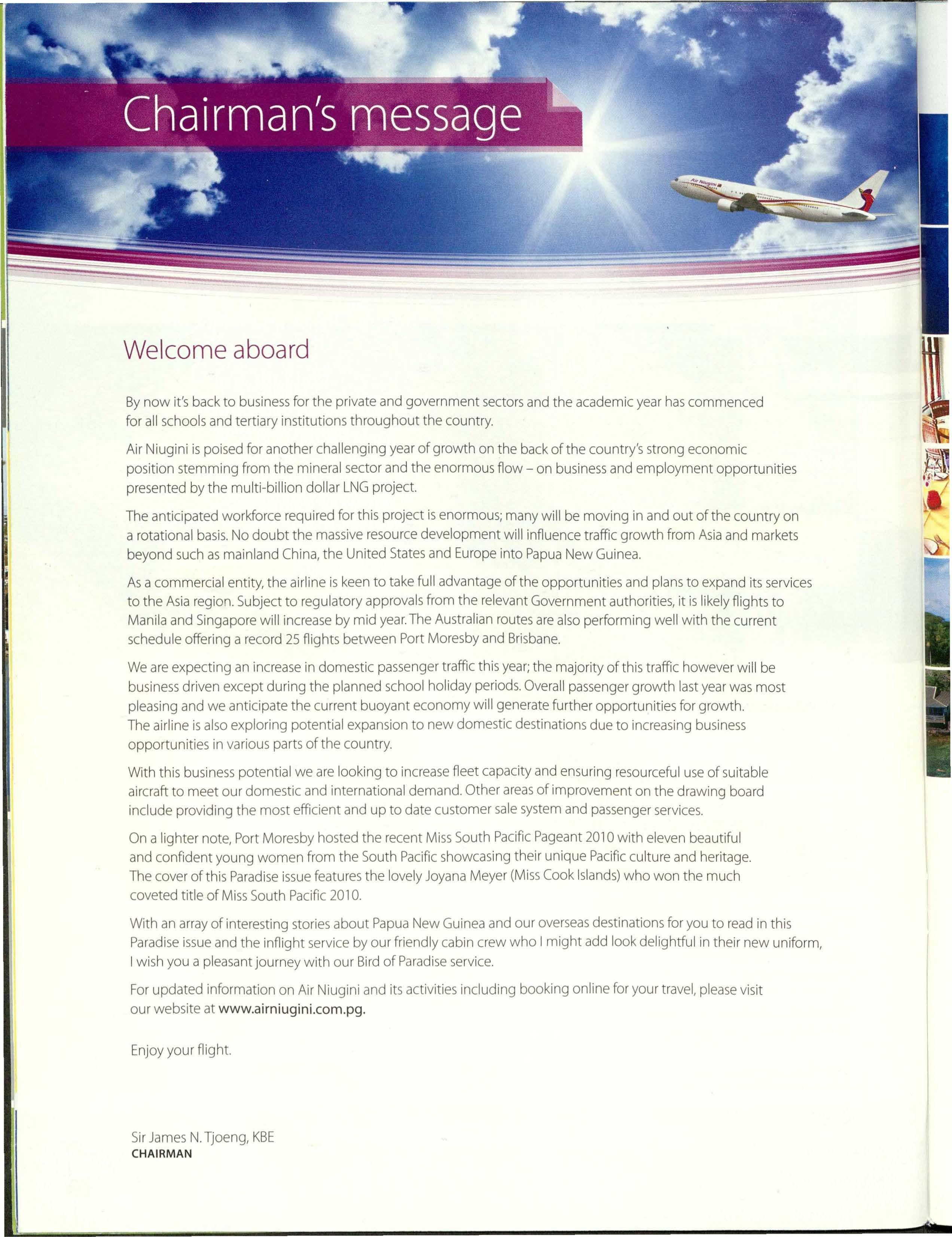
SirJamesN.Tjoeng, KBE CHAIRMAN
Experience a world of luxury in beautiful Madang with MTS. We offer diving, snorkelling, kayaks, sailing catamaran, tennis, marina, shopping, three restaurants, four pools, PADI dive shop, a marina, landscaped gardens, aviaries and a zoo, with two lagoons and an unsurpassed absolute waterfront location.
There are five conference rooms and a convention centre catering for 5 - 400 delegates with wi-fi available throughout. PNG's most stunning location for business, or pleasure with two hundred rooms,

bungalows, cottages and townhouses all tastefully furnished with everything you would expect of a five star resort for short, or longer term accommodation.
For those who crave a little adventure, Kalibobo Spirit is available for expeditionary charter as well as scheduled cruises to the mighty w w River and the islands and is fully equipped for diving.
Call us now, or book through your local travel agent, and be sure to ask about a package to suit your holiday or business needs.
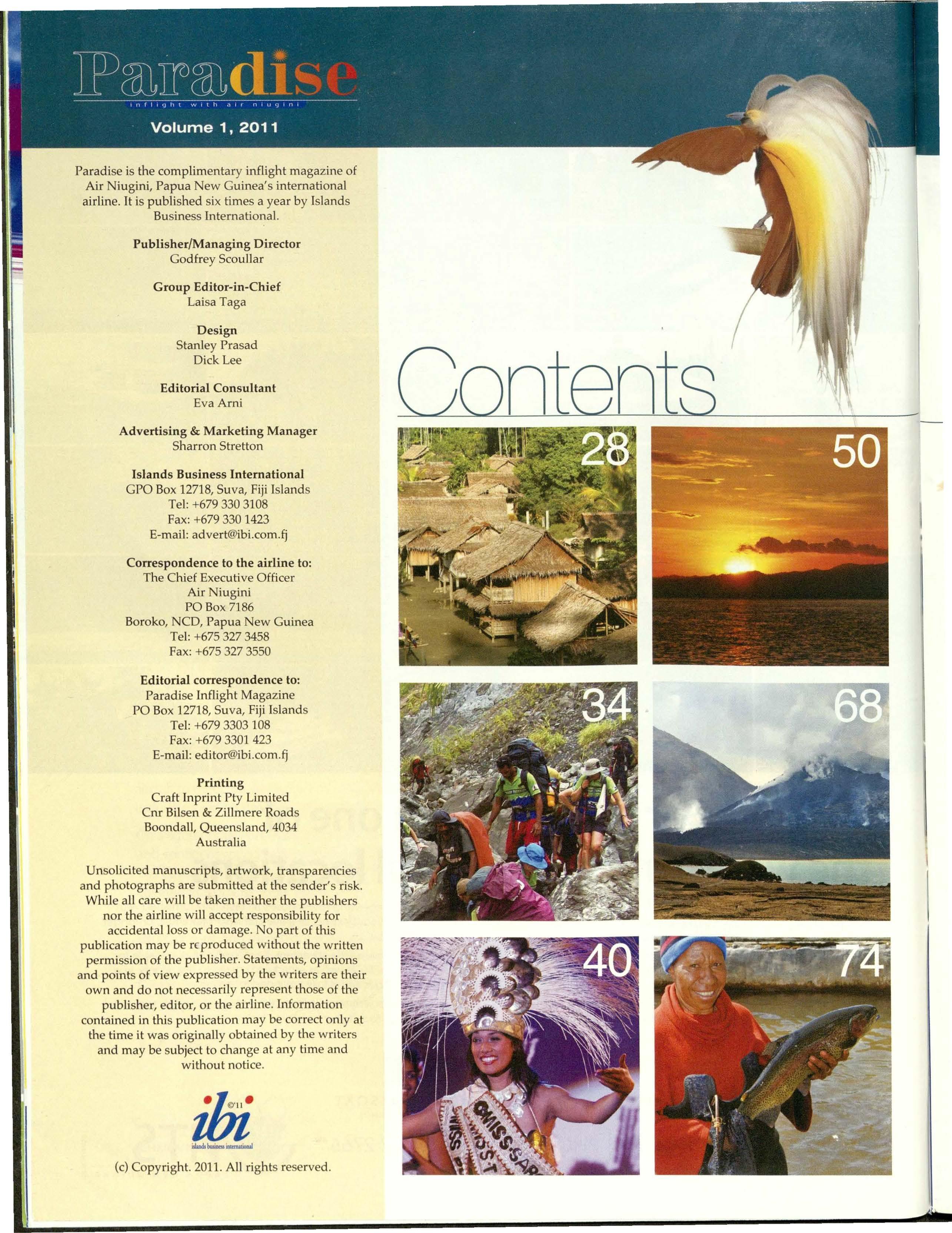
Paradise is the complimentary inflight magazine of Air Niugini, Papua New Guinea's international airline. It is published six times a year by Islands Business International.
Publisher/Managing Director
Godfrey ScouUar
Group Editor-in-Chief Laisa Taga
Design Stanley Prasad
Dick Lee
Editorial Consultant Eva Ami
Advertising & Marketing Manager
Sharron Stretton
Islands Business International
GPO Box 12718, Suva, Fiji Islands
Tel: +679 330 3108
Fax: +679 330 1423
E-mail: advert@ibi.com.fj
Correspondence to the airline to: The Chief Executive Officer
AirNiugini PO Box 7186
Boroko, NCD, Papua New Guinea
Tel: +675 327 3458
Fax: +675 327 3550
Editorial correspondence to:
Paradise Inflight Magazine
PO Box 12718, Suva, Fiji Islands
Tel: +679 3303 108
Fax: +679 3301 423
E-mail: editor@ibi.com.fj
Printing
Craft Inprint Pty Limited
Cnr Bilsen & Zill mere Roads Boondall, Queensland, 4034 Australia
Unsolicited manuscripts, artwork, transparencies and photographs are submitted at the sender's risk. While all care will be taken neither the publishers nor the airline will accept responsibility for accidental loss or damage. No part of this publication may be reproduced without the written permission of the publisher. Statements, opinions and points of view expressed by the writers are their own and do not necessarily represent those of the publisher, editor, or the airline. Information contained in this publication may be correct only at the time it was originally obtained by the writers and may be subject to change at any time and without notice.

The Waria Way
Loggers OUT, alternative development IN
Trekking Mountain & Musa Valley
Stunning scenery, wonderful sunsets, magnificent culture
So Much More than a Beauty Pageant
PNG hosts Miss South Pacific
From the Treetops to Ocean Depths
Stunning Milne Bay
Home of the Insect Cult
Travelling up the Sepik River to Swagup village
Destination Rabaul
Popular with tourists, divers, history buffs ....
Woman Versus Wild
The journey of a Papua New Guinean woman
Mars Bars
The PNG Connection
Nirvana on Nuakata Island
Perfect for a South Pacific escape-away
The Parkinson Legacy Lives On Life in the new colonial frontier
Orpheus Island
The ultimate escape
Port Pleasures
A guide to Yokohama
Where Cultures Meet Singapore's extraordinary precincts
Chasing the National Park Ku-ring-gai ...a pristine wilderness

Brian Bell & Company Ltd is Papua New Guinea's premier retailer, wholesaler & distributor of quality brand products. Through our extensive branch & distribution network we offer a wide range of products & services to businesses, aid agencies, mining companies, government departments and individuals throughout Papua New Guinea.
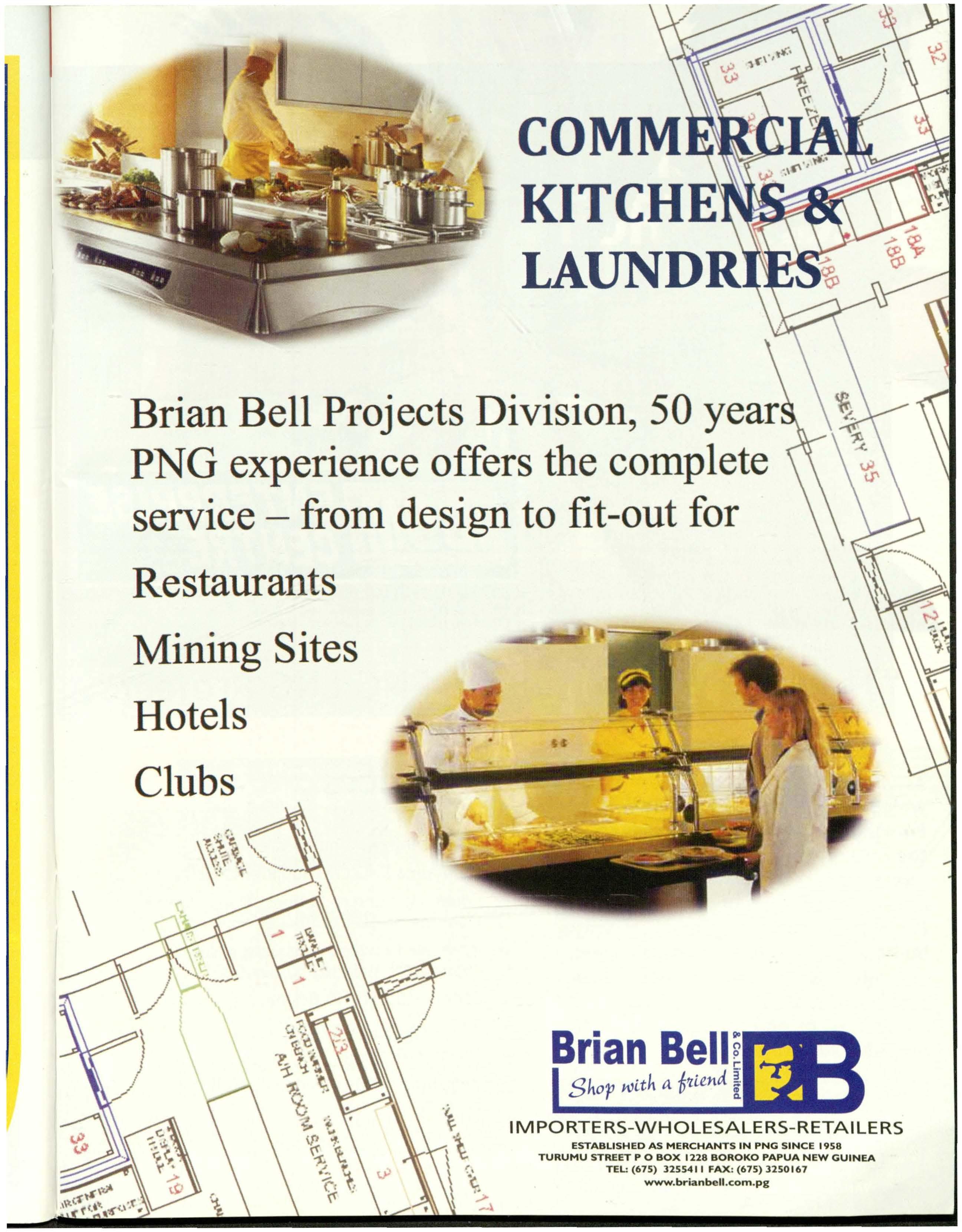
Brian Bell Projects Division, 50 year
PNG experience offers the complete service - from design to fit-out for
Restaurants
Mining Sites
Hotels
Clubs

As an independent business unit, which is a part of PNG Institute of Banking and Business Management, the Enterprise Centre offers a unique mix of services for the local supplier development arm of the PNG LNG Project. It works to assist capacity building of local PNGbusiness,manages an information centre, facilitates business opportunities and maintains a database of potential suppliers for the PNG LNG Project
Project Information Centre
Maintain a PNG LNG Supplier database
Communication of Business Opportunities from the project to PNG Businesses
Interface between contractors, sub contractors and PNG businesses
Capacity build PNG Businesses
PNG BusinessAssessments
Business Training
Mentoring, Advisory and Counseling Services

Fax
Fax
Fax
Fax
If there is anything our cabin crew can assistyou with during your flight, pleasedo not hesitate to askthem.
Pleaseensure that your carry on luggage is placed in the overhead locker or under the seat in front of you.
Ensurethat your seat is in the upright position during takeoff and landing. Folding tables must be returned to their original position in the seat back or the armrest.
Your seat belt must be securelyfastened during take off and landing or whenever the seat belt sign is on. When the seat belt sign is off you may move about the cabin as necessary. However while seated,keep your seat belt fastenedsecurely in caseof unexpected turbulence.
Cellulartelephones,TV receiversor radio controlled devices are not to be used at any time on board an aircraft.Electronic devices such as portable computers, compact discsor cassetteplayersand video games can be used only when the seat belt sign is switched off.
The cabin crew will also be pleasedto assistin preparing your baby'sfood and bottle. Babyfood and diapers are also available. Pleasedo not hesitateto askour friendly cabin crew.
Smoking is not permitted on any Air Niugini flight.

A selection of movies and music including classical, modern, country and local are availableon international services.Programmescan be found in the in-flight entertainment section of this magazine.
On Internationalflights,pillowsand blanketsareavailable on requestfromour cabincrew.
Our in-flight* meals have been speciallyprepared for your enjoyment. If you require a vegetarian meal or you are on a specialdiet, child or baby food, pleaseinform us when making your reservation.
During the flight take some time to look through our In-flight Duty Freebrochure located in your seat pocket. Duty free purchasescan be made after Meal Service. All major credit cardsare accepted.
During your flight, our cabin crew will distribute Immigration and Custom forms before each landing point. Ensurethat you carefully read and complete these documents and have them readyfor inspection with your passportat the Immigration and Customs arrivalcounters.
Pleasecheck your seat pocket and overhead lockers before you disembarkto ensureyou have not left any items of value.We look forward to seeing you when you next fly with us on our Bird of ParadiseService.
Length: 59.94m
Wing span: 47.57m
Range: 8100km
Cruising speed: 857kph
Length: 47.3m
Wing span:41.lm
Range: 4700km
Cruising speed: 857kph
Length: 35.528m
Wing span: 28.076m
Range: 3000km
Cruising speed: 780kph
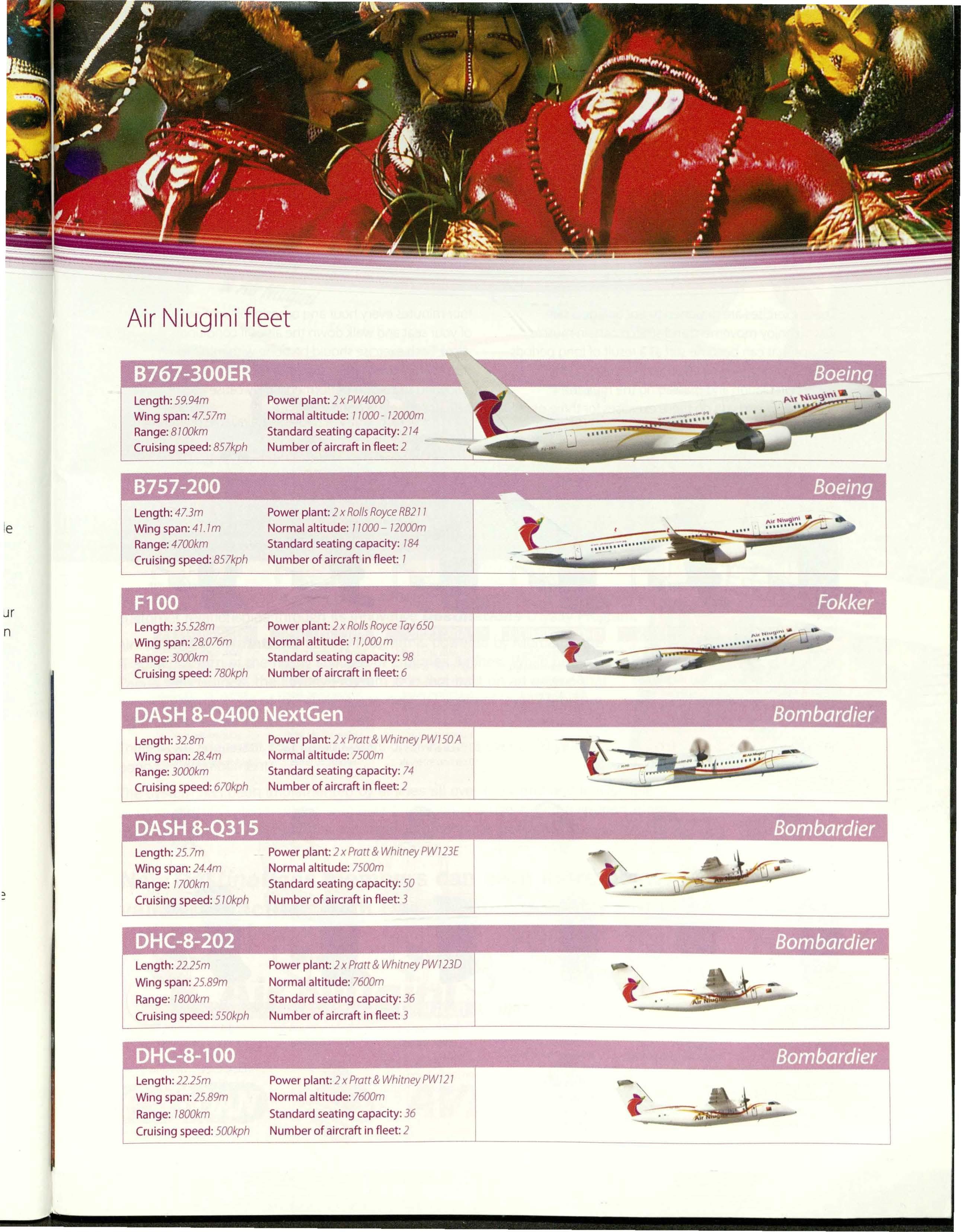
Standard seating capacity: 214
Number of aircraft in fleet: 2
Power plant: 2 x RollsRoyceR8211
Normal altitude: I 1000-12000m
Standard seating capacity: 184
Number of aircraft in fleet: I
Power plant 2 x RollsRoyceTay650
Normal altitude: 11,000m
Standard seating capacity: 98
Number of aircraft in fleet: 6
Length: 32.Bm
Wing span: 28.4m
Range: 3000km
Cruising speed: 670kph
Length: 25.lm
Wing span: 24.4m
Range: 1700km
Cruising speed: 5/0kph
DHC-8-202
Length: 22.25m
Wing span: 25.89m
Range: 1800km
Cruising speed: 550kph
DHC-8-100
Length: 22.25m
Wing span: 25.89m
Range: 1800km
Cruising speed: 500kph
Power plant: 2 x Pratt& WhitneyPW/50A
Normal altitude: 7500m
Standard seating capacity: 74
Number of aircraft in fleet 2
Power plant: 2 x Pratt& WhitneyPWI23E
Normal altitude: 7500m
Standard seating capacity: 50
Number of aircraft in fleet: 3
Power plant: 2 x Pratt& WhitneyPWI230
Normal altitude: 7600m
Standard seating capacity: 36
Number of aircraft in fleet: 3
Power plant: 2 x Pratt& WhitneyPWI21
Normal altitude: 7600m
Standard seating capacity: 36
Number of aircraft in fleet: 2
These exercises are designed to encourage a safe way to enjoy movement and stretch certain muscle groups that can become stiff as a result of long periods of sitting. They may be effective in increasing the body's circulation and massaging the muscles. We recommend you do these exercises for three or
four minutes every hour and_occasionally get out of your seat and walk down the aisles if conditions allow. Each exercise should be done with minimal disturbance to other passengers. None of the following should be performed if they cause pain or cannot be done with ease.
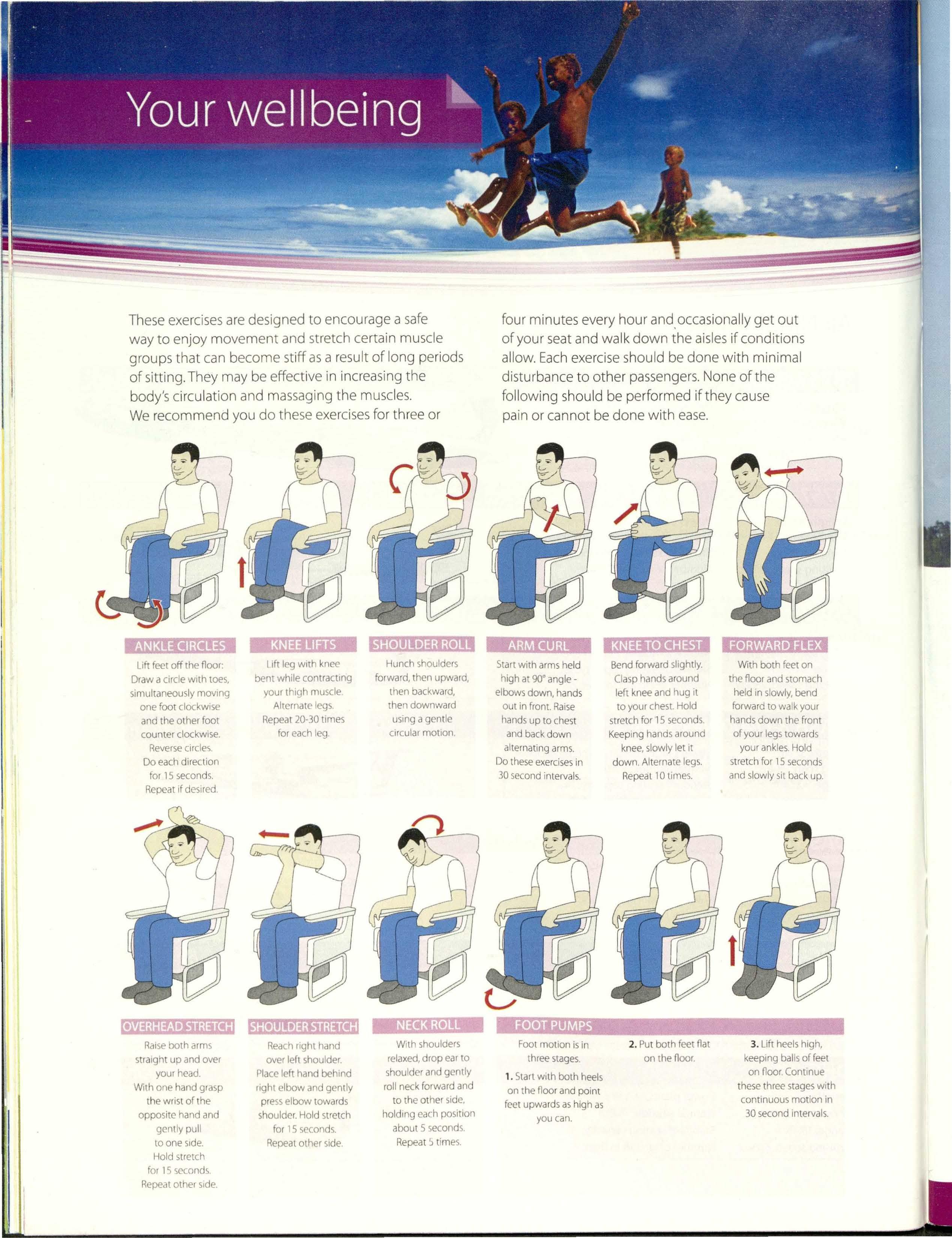
Lift feet off the noor:
Draw a circle wah toes, simultaneouslymoving one foot clockwise and the other foot counter clockwise.
Reversecircles
Do each direction for 15 seconds. Repeatif desired.
L1ftleg With knee Hunch shoulders bent while contracting forward,then upward, your thigh muscle then backward, Alternate legs. then downward Repeat20-30times using a gentle for each leg circularmotion.
Startwith arms held Bendforward slightly. With both feet on high at 90• angle - Clasphandsaround the noor and stomach elbowsdown, hands left knee and hug it held in slowly,bend out in front. Raise to your chest.Hold forward to walk your handsup to chest stretch for 15 seconds. handsdown the front and backdown Keepinghandsaround of your legs towards alternatingarms. knee,slowly let It your ankles.Hold Do theseexercisesin down. Alternate legs. stretchfor 15seconds 30 secondintervals. Repeat10 times. and slowly sit backup.
Raiseboth arms straight up and over your head.
With one hand grasp the wrist of the opposite hand and gently pull to one side. Hold stretch for 15seconds
Repeatother side.
Reachright hand With shoulders over left shoulder. relaxed,drop ear to Placeleft hand behind shoulderand gently right elbow and gently roll neck forward and presselbow towards to the other side. shoulder.Hold stretch holding each position for 15seconds. about 5 seconds. Repeatother side Repeat5 times.
Foot motion is in 2. Put both feet fiat 3. Lift heelshigh, three stages. on the noor. keeping ballsof feet
1. Startwith both heels on noor Continue on the noor and point thesethree stageswith feet upwardsas high as continuous motion in you can. 30 secondintervals.
Air Niugini has invested in state of the art information technology to enhance customer relationships through its innovative Destinations Loyalty Program.
Air Niugini's Destinations Loyalty Program is powered by Mercator, the IT solutions arm of the highly successful Emirates Airlines. While new to Papua New Guinea, the Loyalty Program is in fact built on an engine that has 40 person years of investment and over 10 years of loyalty program experience.
There is an additional 150 person years of investment over an 8 year period of development.
The system has been implemented by airlines all over the world and is available at more than 90 global offices with over 2,000 on-line users, and a support team of 50 highly skilled loyalty systems business and technical professionals.
Now Destinations members can earn more points when they make valid transactions with Destinations Loyalty Program partners.

Air Niugini
At Air Niuginiwe careaboutyourcomfortand safety. We haveincludedthe followinginformationaboutyour health in-flightthat we hope you willfind helpfuland useful.
When you are flying you can be seatedand be inactive for long periods of time. The environment can be low in humidity and pressurisedup to an altitude of 2240 metres above sealevel.Unlike other forms of transportation, air travel allows for rapid movement acrossmany time zones,causing a disruption to the body's"biological clock''. Although these unique factors do not pose a health or safety threat to most passengers,there are guidelinesyou can follow that will improve your comfort level,during and after a flight. We hope the following recommendationswill help you have a more pleasantflight today and in the future.
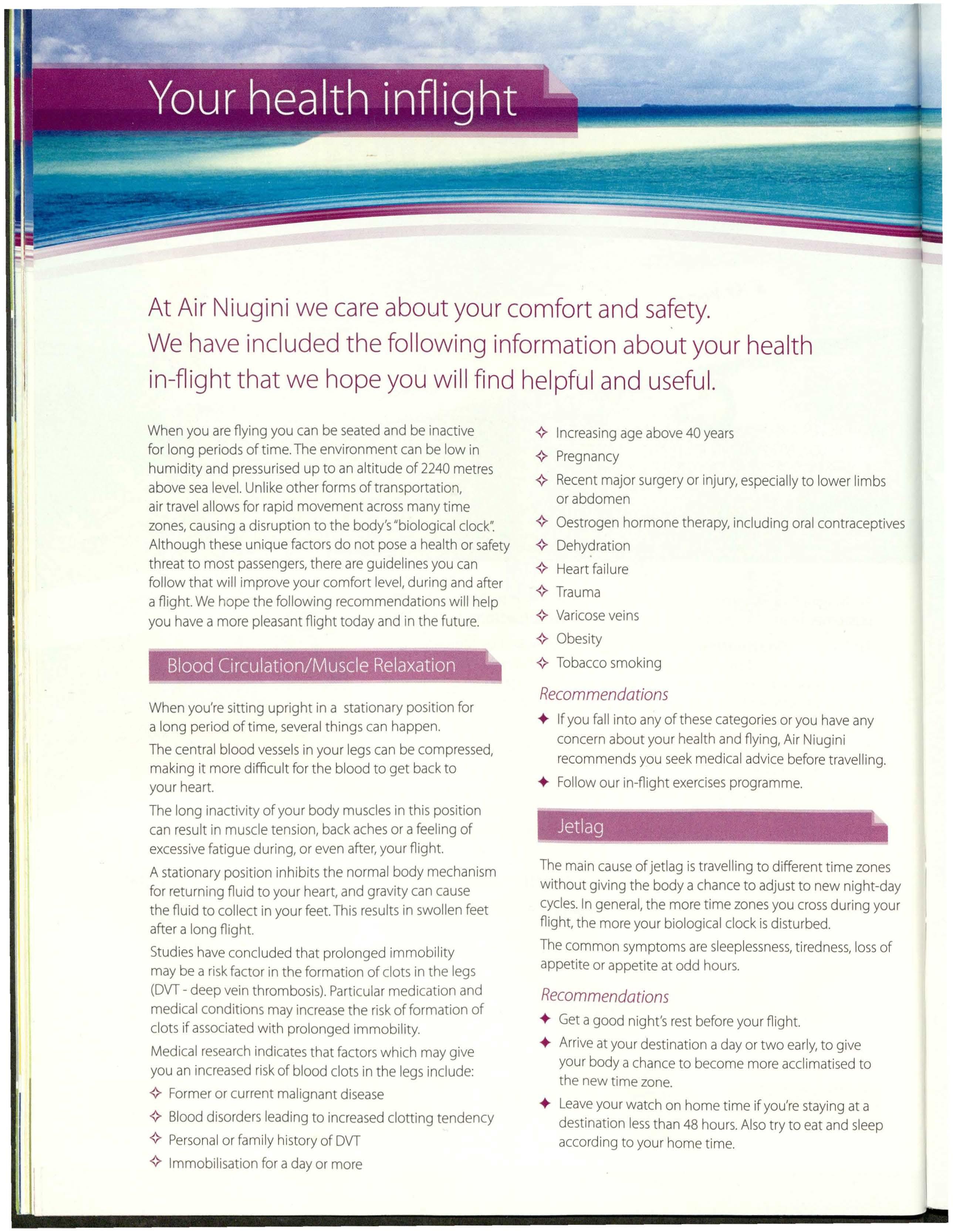
When you're sitting upright in a stationary position for a long period of time, severalthings can happen.
The central blood vesselsin your legs can be compressed, making it more difficult for the blood to get backto your heart.
The long inactivity of your body musclesin this position can result in muscletension, back achesor a feeling of excessivefatigue during, or even after,your flight.
A stationary position inhibits the normal body mechanism for returning fluid to your heart, and gravity can cause the fluid to collect in your feet.This resultsin swollen feet after a long flight.
Studieshaveconcluded that prolonged immobility may be a riskfactor in the formation of clots in the legs (DVT- deep vein thrombosis).Particularmedication and medical conditions may increasethe riskof formation of clots if associatedwith prolonged immobility.
Medical researchindicatesthat factorswhich may give you an increasedriskof blood clots in the legs include:
Formeror current malignant disease
Blood disordersleading to increasedclotting tendency
Personalor family history of DVT
Immobilisation for a day or more
Increasingage above 40 years
Pregnancy
Recentmajor surgeryor injury,especiallyto lower limbs or abdomen
Oestrogenhormone therapy,including oral contraceptives
Dehydration
Heartfailure
Trauma
Varicoseveins
Obesity
Tobaccosmoking
Recommendations
If you fall into any of these categoriesor you haveany concern about your health and flying, Air Niugini recommendsyou seekmedical advice before travelling. Follow our in-flight exercisesprogramme.
The main causeof jetlag is travelling to different time zones without giving the body a chanceto adjust to new night-day cycles.In general,the more time zonesyou crossduring your flight, the more your biological clock is disturbed.
The common symptoms are sleeplessness,tiredness,lossof appetite or appetite at odd hours.
Recommendations
Get a good night's rest before your flight. Arriveat your destination a day or two early,to give your body a chanceto become more acclimatisedto the new time zone.
Leaveyour watch on home time if you're stayingat a destination lessthan 48 hours.Also try to eat and sleep according to your home time.
Changeyour watch to the localtime if your stay is longer than 48 hours,and try to eat and sleepin accordancewith the local time.
On longer stays,try to preparein advance, adjust your meal and resttimes to be closerto those of your destination.
Try some light exercise- go for a briskwalk,or do some readingif you can't sleepafter arrivalat your destination. It generallytakesthe body's biological clock approximatelyone day to adjust per time zone crossed. Flydirect to minimiseflight time.Thisallowsyou to relaxmore upon arrival.
Humidity levelsof lessthan 25 percentare common in the cabin.This is due to the extremelylow humidity levels of outside air suppliedto the cabin.The low humidity can causedrying of the nose,throat, eyesand it can irritate contact lenswearers.
Recommendations
Drinkwater or juices frequently during the flight
Drinkcoffee,tea and alcohol in moderation.Thesedrinks acts asdiuretics,increasingthe body'sdehydration. Removecontact lensesand wear glassesif your eyesare irritated.
Usea skin moisturiserto refreshthe skin.
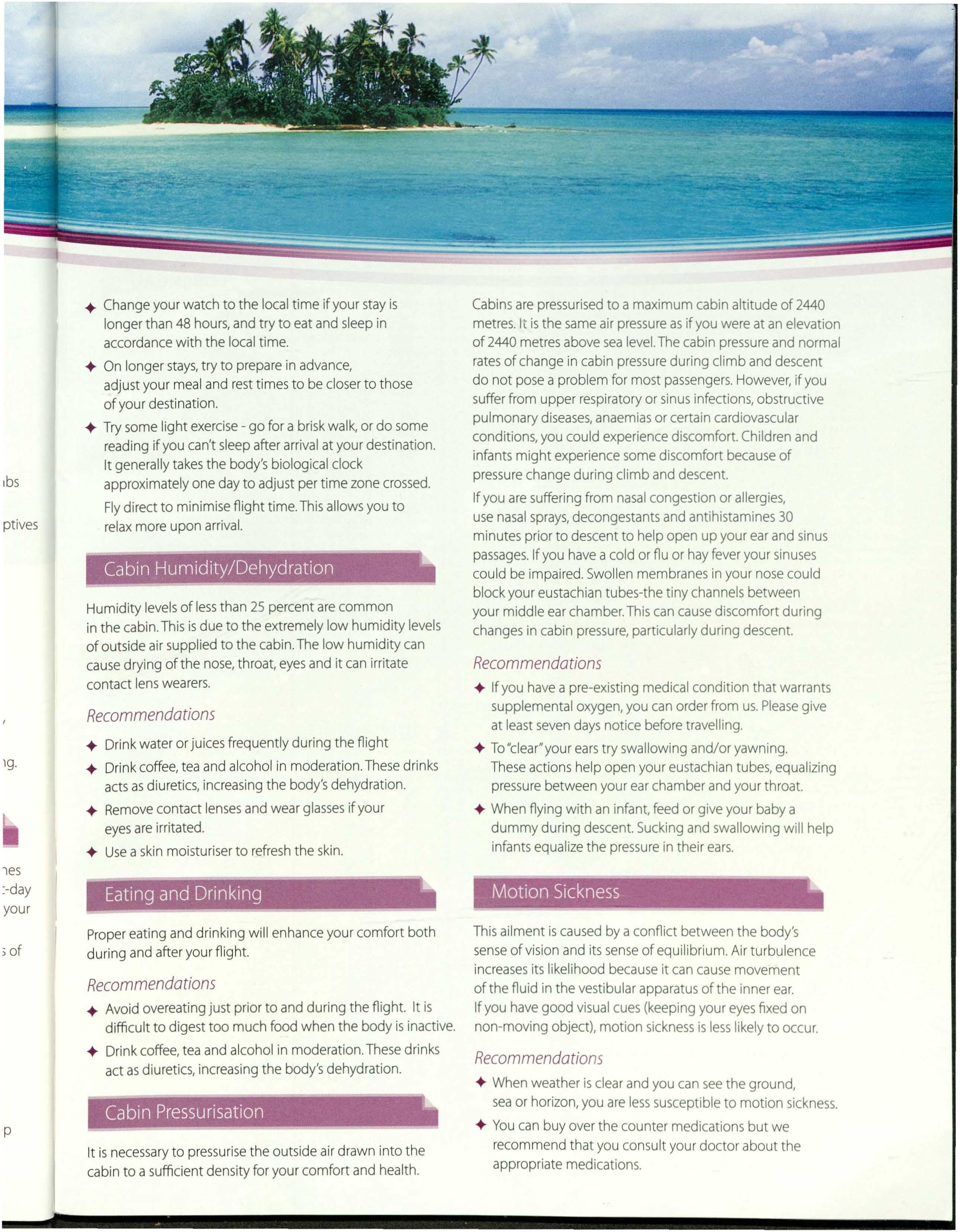
Propereating and drinking will enhanceyour comfort both during and after your flight.
Recommendations
Avoid overeatingjust prior to and during the flight. It is difficult to digest too much food when the body is inactive.
Drink coffee,tea and alcohol in moderation.Thesedrinks act as diuretics,increasingthe body'sdehydration.
It is necessaryto pressurisethe outside air drawn into the cabin to a sufficient density for your comfort and health.
Cabinsare pressurisedto a maximum cabin altitude of 2440 metres.It is the sameair pressureas if you were at an elevation of 2440 metresabove sealevel.The cabin pressureand normal ratesof change in cabin pressureduring climb and descent do not posea problem for most passengers.However,if you sufferfrom upper respiratoryor sinusinfections,obstructive pulmonary diseases,anaemiasor certain cardiovascular conditions,you could experiencediscomfort.Childrenand infants might experiencesome discomfort becauseof pressurechange during climb and descent.
If you are sufferingfrom nasalcongestionor allergies, use nasalsprays,decongestantsand antihistamines30 minutes prior to descentto help open up your ear and sinus passages.If you havea cold or flu or hayfeveryour sinuses could be impaired.Swollenmembranesin your nose could block your eustachiantubes-the tiny channelsbetween your middle ear chamber.Thiscan causediscomfort during changesin cabin pressure,particularlyduring descent.
Recommendations
If you havea pre-existingmedicalcondition that warrants supplementaloxygen,you can order from us.Pleasegive at leastsevendaysnotice beforetravelling.
To"clear"yourearstry swallowingand/or yawning. Theseactions help open your eustachiantubes,equalizing pressurebetween your ear chamber and your throat. When flying with an infant,feed or give your baby a dummy during descent.Suckingand swallowing will help infants equalizethe pressurein their ears.
Thisailment is causedby a conflict between the body's senseof vision and its senseof equilibrium. Air turbulence increasesits likelihood becauseit can causemovement of the fluid in the vestibularapparatusof the inner ear. If you havegood visualcues (keepingyour eyesfixed on non-moving object), motion sicknessis lesslikely to occur.
Recommendations
When weather is clearand you can seethe ground, seaor horizon,you are lesssusceptibleto motion sickness. You can buy over the counter medicationsbut we recommend that you consult your doctor about the appropriate medications.
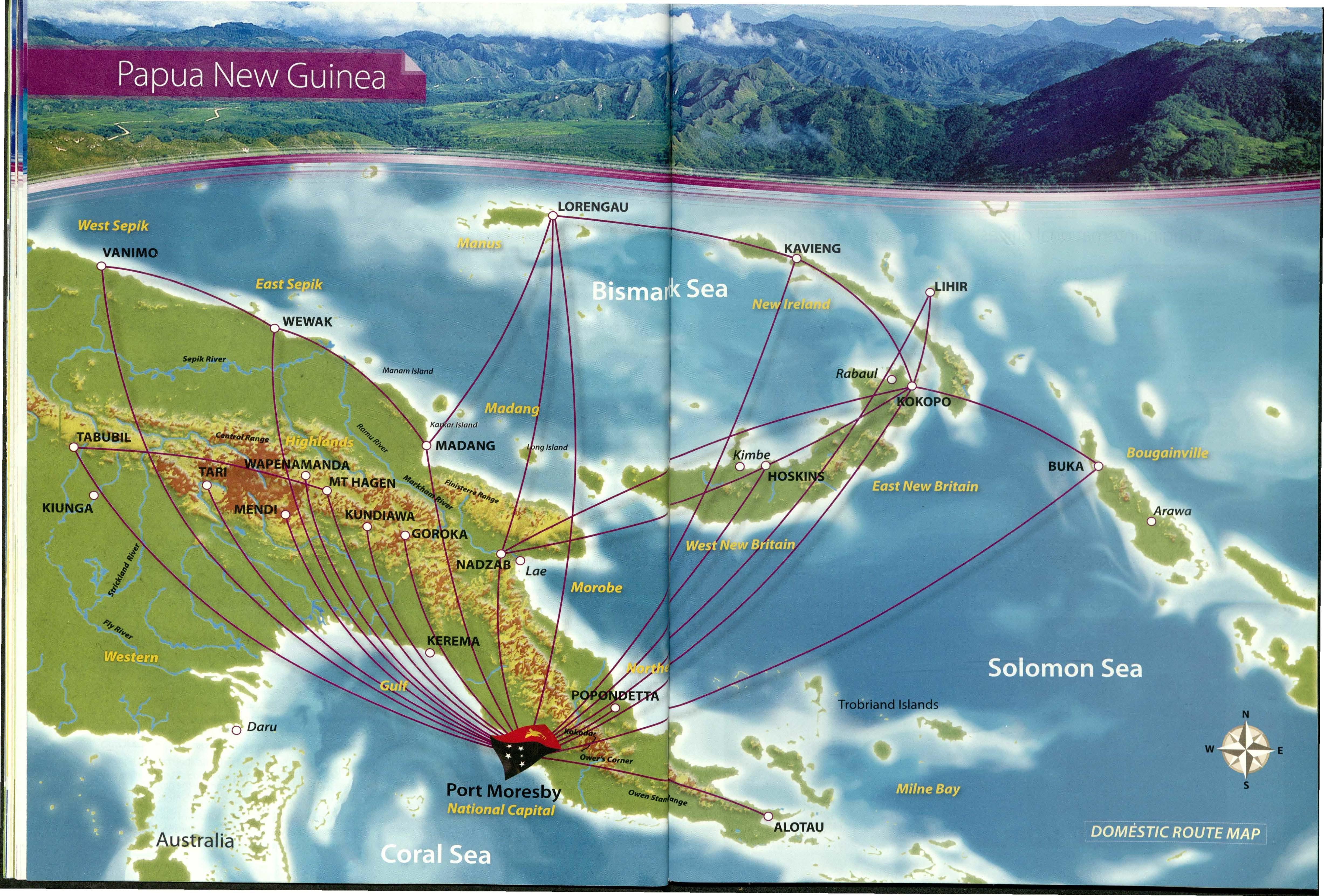
AustraliaWide
LocalCall:1300361 380
Sydney
SomareHouse 100ClarenceStreet PO Box 5293 SydneyNSW2001
AustraliaTel:(61 2) 9290 1544
Fax:(61 2) 9290 2026
Email:sales.sydney@airniugini.com.pg
Brisbane Level3, 97 CreekStreet GPOBox2216 BrisbaneQLD4001
AustraliaTel:(61 7) 3221 1544
Fax:(61 7) 3220 0040
Email:sales.brisbane@airniugini.com.pg
Cairns
CairnsCorporateTower,Ground Floor 15 LakeStreetCairnsQLD4870Australia
Tel:(61 7) 4031 1611
Fax:(61 7) 4031 3402
Email:sales.cairns@airniugini.com.pg
Manila
3rd Floor
Fortune Office Building 160 LegaspiStreet,LegaspiVillage, Makati City,Philippines
Tel:(63 2) 891 3339/40/41
Fax:(63 2) 891 3393
Email:sales.manila@airniugini.com.pg
Tokyo
6th Floor Chiyoda Kaikan
1-6-17Kudan Minami
Chiyoda-KuTokyo 102-0074Japan
Tel:(81) 3 5216 3555
Fax:(81) 3 5216 3556
Email:info@air-niugini.co.jp
Website:www.air-niugini.co.jp
Auckland/Cook Islands
WalshesWorld
Tel:(64) 9379 3708
Fax:(64)9302 2420
Fiji
Discount Flight Centre
Tel:(679)331 7870
Fax:(679)331 7873
Frankfurt
PacificDream
Tel:(49)6963 4095
Fax:(49)6963 1332
Email:info@pngtourism.de
Hong Kong
TamWing Kun Holdings Ltd
Tel:(852)2527 7098
Fax:(852)2527 7026
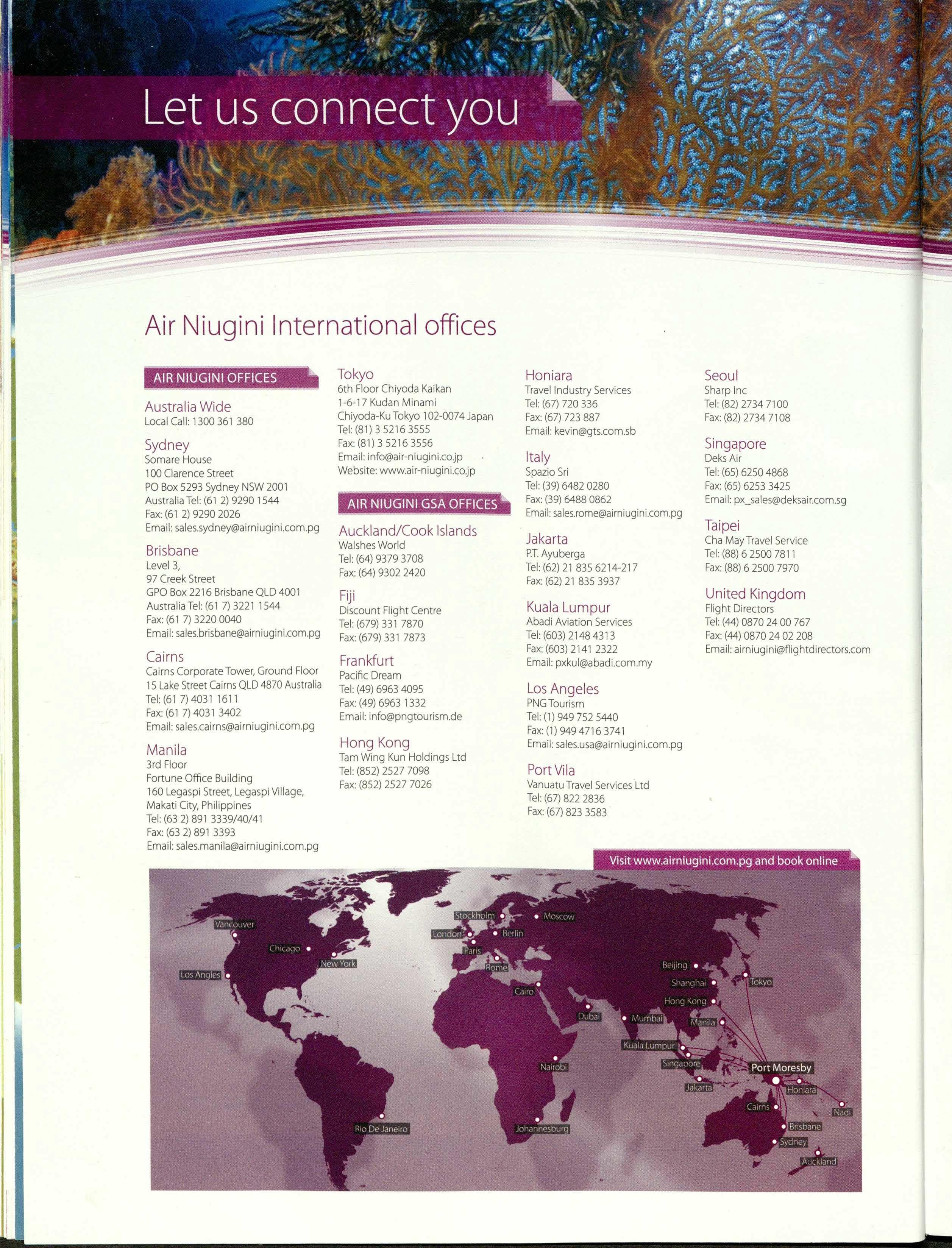
Honiara
TravelIndustry Services
Tel:(67) 720 336
Fax:(67) 723 887
Email:kevin@gts.com.sb
Italy
SpazioSri
Tel:(39)6482 0280
Fax:(39)6488 0862
Email:sales.rome@airniugini.com.pg
Jakarta
f'T.Ayuberga
Tel:(62)218356214-217
Fax:(62)21 835 3937
KualaLumpur
Abadi Aviation Services
Tel:(603)21484313
Fax:(603)2141 2322
Email:pxkul@abadi.com.my
LosAngeles
PNGTourism
Tel:(1)949 752 5440
Fax:(1)949 4716 3741
Email:sales.usa@airniugini.com.pg
PortVila
VanuatuTravelServicesLtd
Tel:(67)822 2836
Fax:(67)823 3583
Seoul
SharpInc
Tel:(82) 2734 7100
Fax:(82)2734 7108
Singapore
DeksAir
Tel:(65)62504868
Fax:(65)6253 3425
Email:px_sales@deksair.com.sg
Taipei
Cha MayTravelService
Tel:(88)6 2500 7811
Fax:(88)6 2500 7970
United Kingdom
Flight Directors
Tel:(44)0870 24 00 767
Fax:(44)0870 24 02 208
Email:airniugini@flightdirectors.com
Port Moresby Kavieng
POBox7186Boroko
SalesDomestic& International
Tel:327 3444 Fax:327 3308

Madang Tabubil
Administration, POBox 140Madang
Reservations& Cargo
Tel:984 2135
ReconfirmationDomestic& Airport:
International Tel:984 2105 Fax:984 2337
Tel:327 3444
Arrival& DepartureInformation Kimbe-Hoskins
Tel:327 3300 POBox 181Kimbe
CargoEnquiries
Tel:327 3245
POBox545Tabubil
Administration& Reservations DomesticReservations
Tel:852 2255 Fax:852 2079
Mendi
POBox210 Mendi
Tel:548 3244 Fax:548 9189
InternationalReservations
Tel:548 3325
Administration& Reservations TariAgent
Tel:549 1233 Fax:549 1250
Administration,Reservations& Cargo Airport Traffic
Tel:983 5077 Fax:983 5669
CargoCharterEnquiries Arrival& DepartureInformation
Cargo:327 3226 Pass:327 3370 Tel:985 0012
HeadOffice Kundiawa
Airport & Administration
JacksonsAirport 5araga
Tel:327 3200/3259000
Alotau
POBox3 Alotau GurneyAirport
Tel:641 0158
Administration& Reservations
Tel:641 1031 Fax:641 1636
Tel:549 1320
Mt Hagen
POBox847 Kundiawa
Tel:735 1273
Tel:5408023
Vanimo
POBox239Vanimo
Tel:857 1014 Fax:857 1473
POBox3 Mt Hagen Airport
ReservationsDomestic
Tel:542 1183/5421122
Tel:857 7166
ReservationsInternational Wabag& Wapenamanda
Tel:542 1039
POBox213Wabag Lae
Administration,Domestic,
Enquiries Administration
Tel:547 1274
Tel:545 1444 Fax:542 2361
Reservations& Cargo Arrival& DepartureInformation
Tel:472 3111 Fax:472 4758
InternationalReservations
Popondetta
POBox 145Popondena Tel:472 4744
Buka Lihir
Tel:547 1286
Reservations Waigani
Tel:329 7022 Fax:329 7227
POBox 169 Airport
BukaSales Reservations
Tel:973 9655 Fax:973 9656
Tel:986 5151 Fax:986 5134
POBox7186 Boroko
Tel:325 1055 Fax:325 3683
Tel:329 7191
Rabaul
Wewak Airport Lorengau/Manus
Tel:973 9082
POBox61 Wewak
POBox3120Rabaul Sales POBox 170 Lorengau
Goroka Administration,
Tel:856 2433
Reservations& Sales
Tel:983 9325 Fax:982 9034 International& Domestic
POBox683 Goroka Reservations& Cargo TokuaAirport Arrival& Departure
Reservations
Tel:732 1444 Fax:732 1439
Tel:856 2367 Fax:856 2203
Tel:470 9092 Fax:470 9382 Information Airport
Tel:856 2367
Tel:983 9821
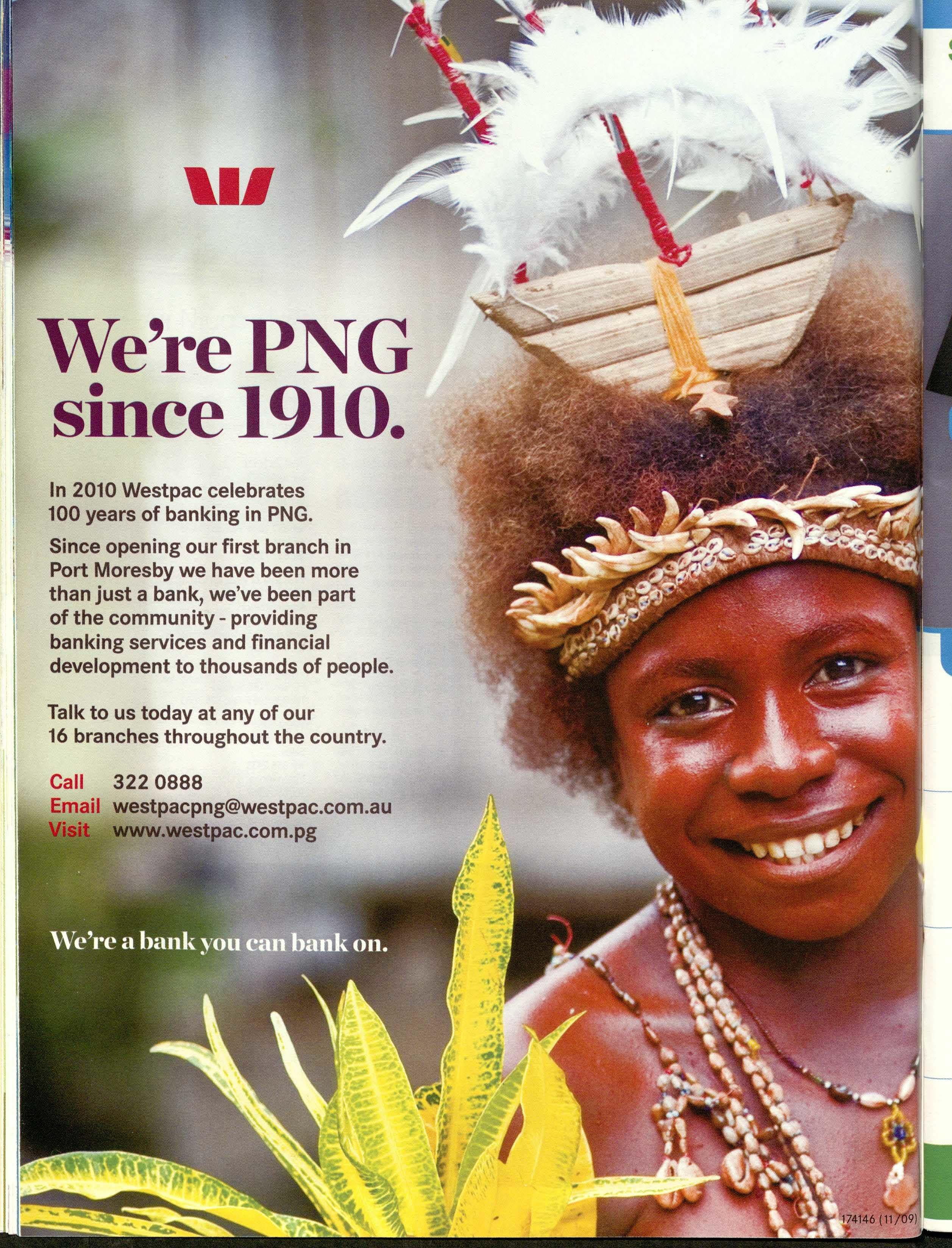
In 2010 Westpac celebrates 100 years of banking in PNG. Since opening our first branch in Port Moresby we have been more than just a bank, we've been part of the community - providing banking services and financial development to thousands of people. Talk to us today at any
The X'cess product is very user friendly. Telikom's wireless communication technology gives customers voice telephony and fast internet (1x) access from anywhere within the network coverage area.
The wireline telephone retail product covers Citizen lkonomi, Citizen Residential and standard business line service. These diverse range of products can help you manage your lifestyle and reduce business costs
The Aristel DV-38 product is an inteligent key telephone system. It comes as a basic unit with 4 PSTN lines and 8 extentions and is expandable to 12 PSTN lines and 26 extentions. It is most suitable for small and medium enterprises, schools, churches, government offices, institutions and NGO groups.
Benefits of Voice products
• Low call rates
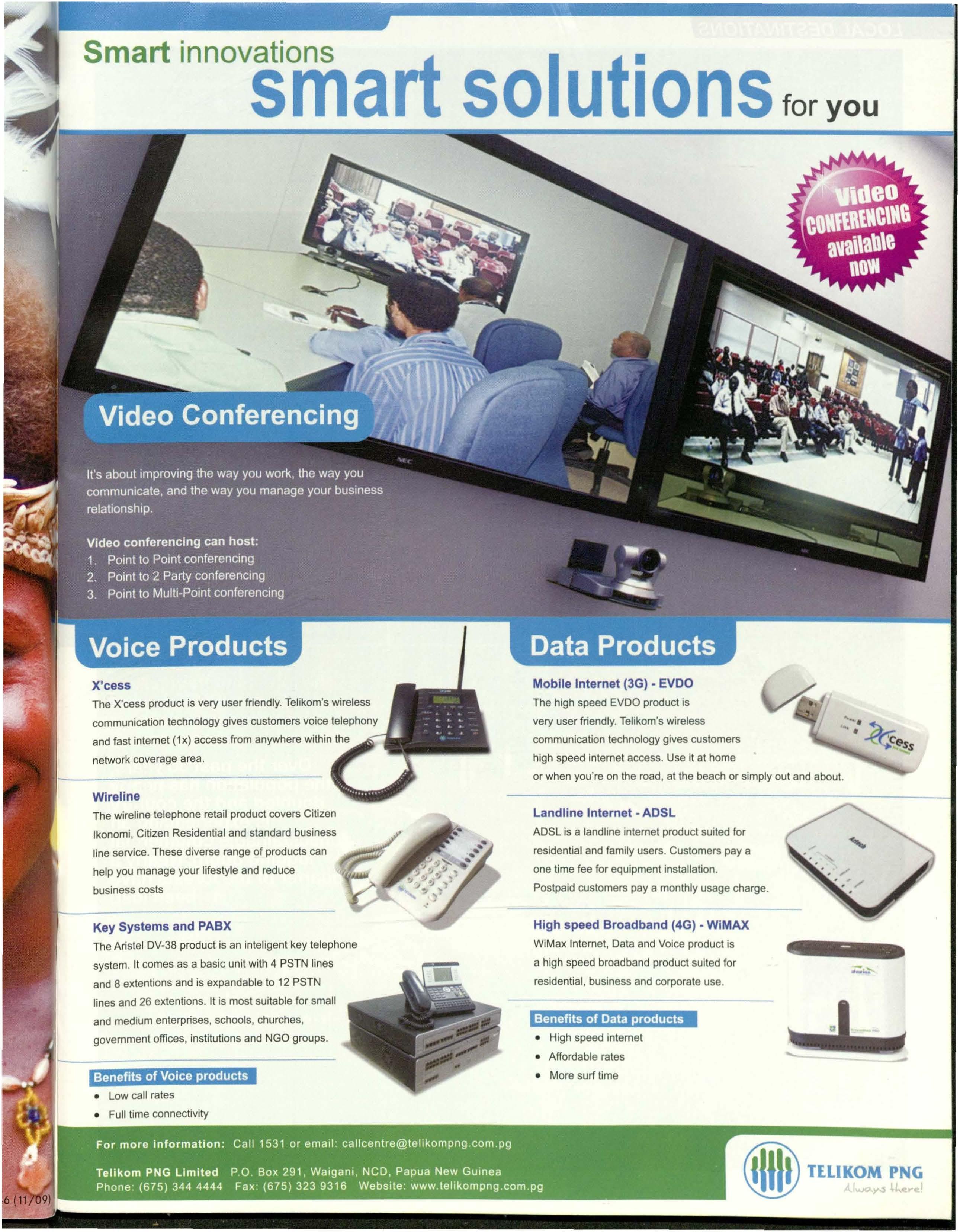
The high speed EVDO product is very user friendly. Telikom's wireless communication technology gives customers high speed internet access. Use it at home or when you're on the road, at the beach or simply out and about.
ADSL is a landline internet product suited for residential and family users. Customers pay a one time fee for equipment installation.
Postpaid customers pay a monthly usage charge.
High speed Broadband (4G) • WiMAX
WiMax Internet, Data and Voice product is a high speed broadband product suited for residential, business and corporate use.
Benefits of Data products
• High speed internet
• Affordable rates
• More surf time
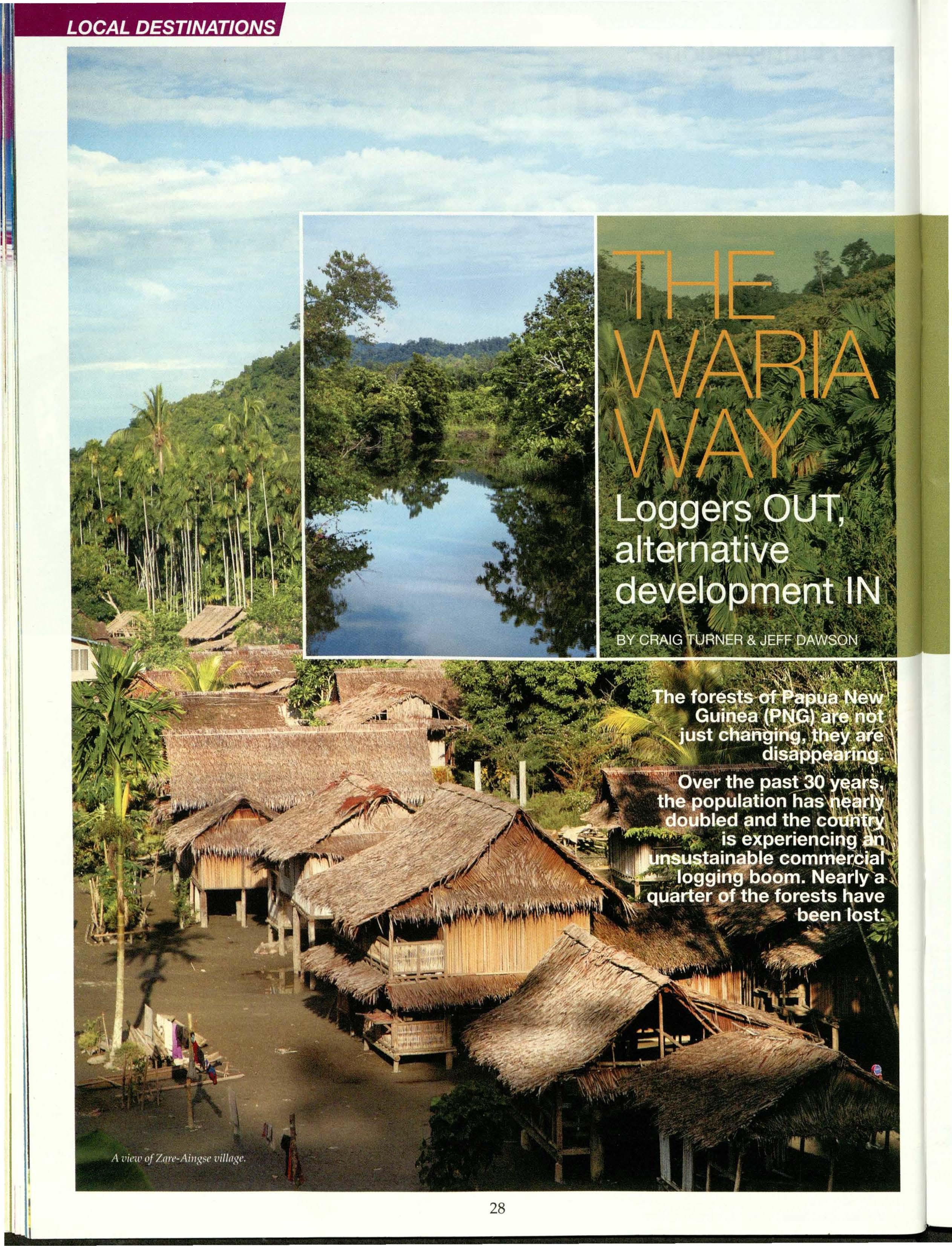
et despite this doom and gloom, communities in one forested valley are rejecting the loggers for an alternative means of development.
The rainforests of PNG are one of the last remaining wilderness areas on the planet, covering over 60% of the country, from the coast to the mountains.
With West Papua, they form the third largest intact forest wilderness on the planet. Not only do they support 6% of the world's biodiversity, they are also extremely important to the people of PNG.
These forests are vital to the livelihoods of the mostly rural population, providing them with their food, shelter, medicine and their spiritual and cultural identity.
However, a country-wide proliferation of unsustainable commercial logging (and mining) activity is undermining the environmental fabric on which the cultural, social and economic well-being of the country's rural population depends.
Yet there is a glimmer of hope. In the Waria Valley, located on the north coast of the southeast peninsular in Morobe Province, communities responded to and learnt from recent history.
Ensuring that through their strong attachment to the land and as customary land tenure system dictates, they do indeed have the final say regarding the fate of their forests and biodiversity.
The people of the lower Waria Valley have received little benefits where large-scale conventional logging has taken place. The communities voiced their concerns - and while they were keen to retain control over their resources, they also wanted benefits that these resources could bring.
Local man Cossey Yosi took on the gauntlet of making this aspiration a reality. While studying in the United Kingdom, he approached a British NGO (Coral Cay Conservation) with a
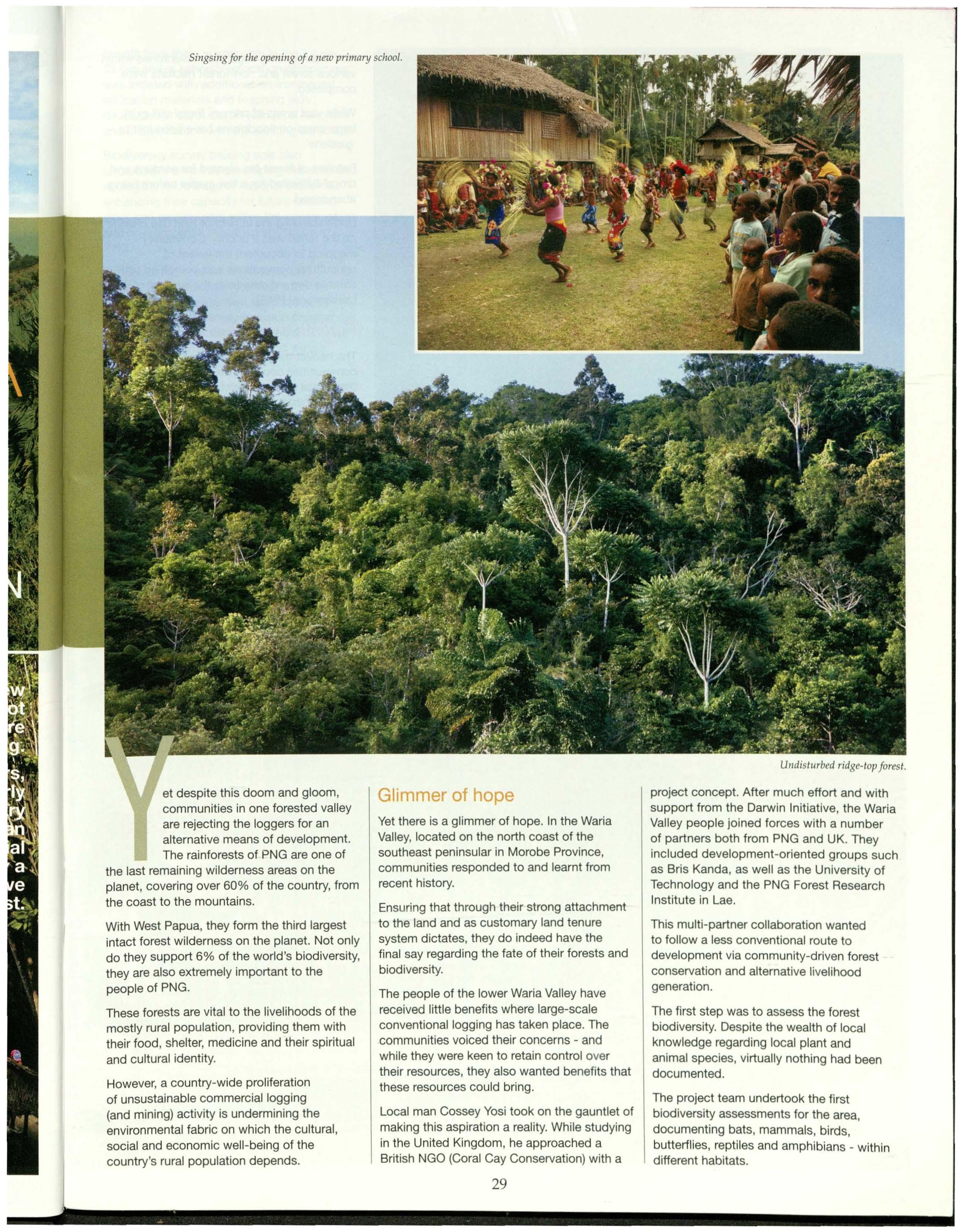
project concept. After much effort and with support from the Darwin Initiative, the Waria Valley people joined forces with a number of partners both from PNG and UK. They included development-oriented groups such as Bris Kanda, as well as the University of Technology and the PNG Forest Research Institute in Lae.
This multi-partner collaboration wanted to follow a less conventional route to development via community-driven forest conservation and alternative livelihood generation.
The first step was to assess the forest biodiversity. Despite the wealth of local knowledge regarding local plant and animal species, virtually nothing had been documented.
The project team undertook the first biodiversity assessments for the area, documenting bats, mammals, birds, butterflies, reptiles and amphibians - within different habitats.
Thehabitat mapsgeneratedmeant localcommunltie couldfor the first time visualisethe spatialvalueof their forestsand see the resultsof their own impacts at a broadscale.
At the same time, vegetation inventories within various forest and non-forest habitats were completed.
While vast areas of primary forest still exist, large areas on floodplains have been lost to 'gardens'.
Patches of forest are cleared for gardens anc crops cultivated for a few cycles before being abandoned.
Understanding the impact of land use change on the forest was a priority. Community mapping to document the extent of agricultural conversions was combined with satellite derived data (with the support of the University of PNG).
The habitat maps generated meant local communities could for the first time visualise the spatial value of their forests and see the results of their own impacts at a broader scale.
In addition to better understan'ding the forests (and local impacts), communities were keen to improve environmental awareness so that younger generations would not only appreciate the true value of the forests but also have the skills necessary to manage and
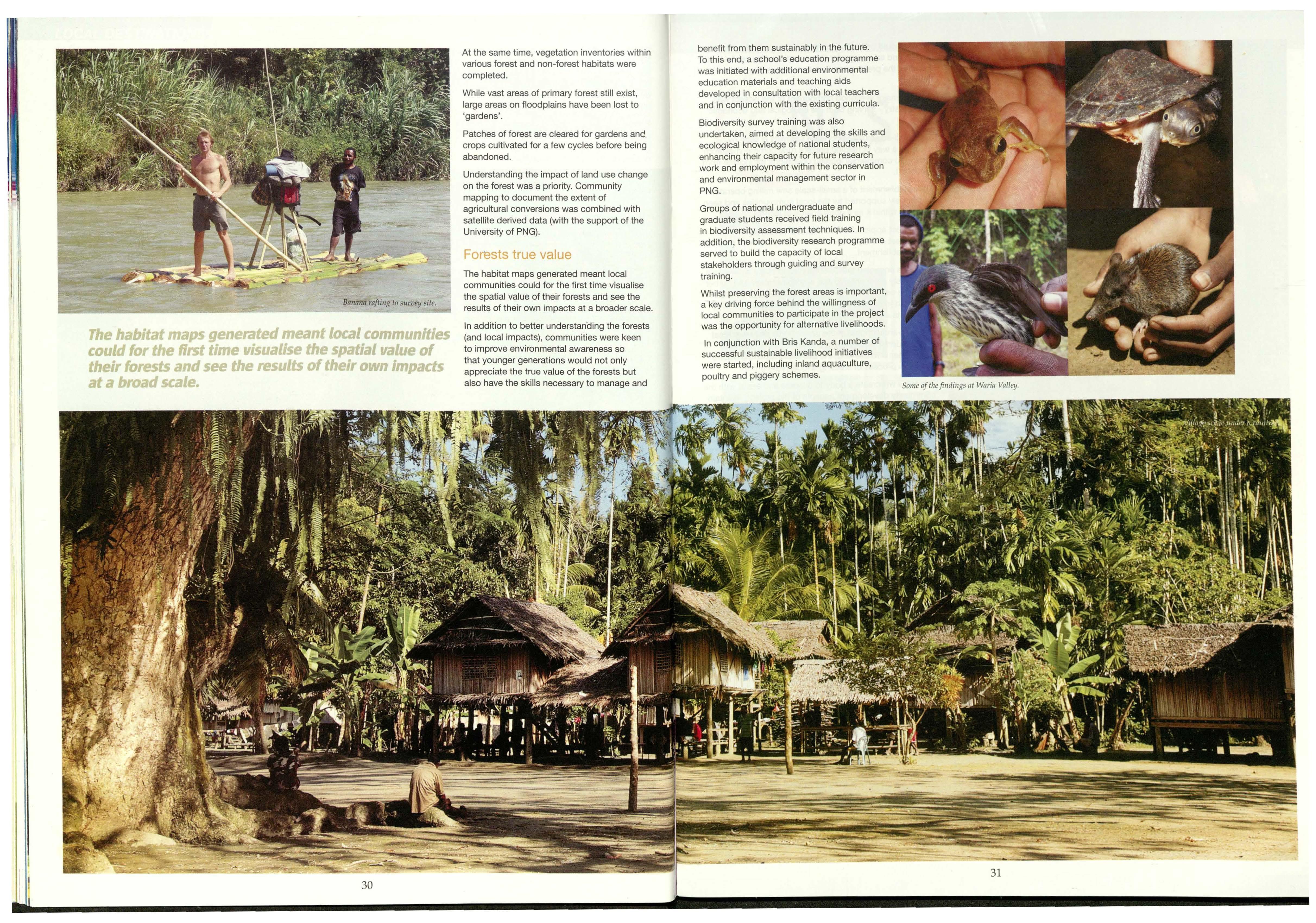
benefit from them sustainably in the future.
To this end, a school's education programme was initiated with additional environmental education materials and teaching aids developed in consultation with local teachers and in conjunction with the existing curricula.
Biodiversity survey training was also undertaken, aimed at developing the skills and ecological knowledge of national students, enhancing their capacity for future research work and employment within the conservation and environmental management sector in PNG.
Groups of national undergraduate and graduate students received field training in biodiversity assessment techniques. In addition, the biodiversity research programme served to build the capacity of local stakeholders through guiding and survey training.
Whilst preserving the forest areas is important, a key driving force behind the willingness of local communities to participate in the project was the opportunity for alternative livelihoods.
In conjunction with Bris Kanda, a number of successful sustainable livelihood initiatives were started, including inland aquaculture, poultry and piggery schemes.
Theover-archinggoal of the projectis to empower stakeholdersto sustainablybenefit from their forestenvironment.Tothis end, the communitiesand partnersare in the processof creatinga local NGOgroup.
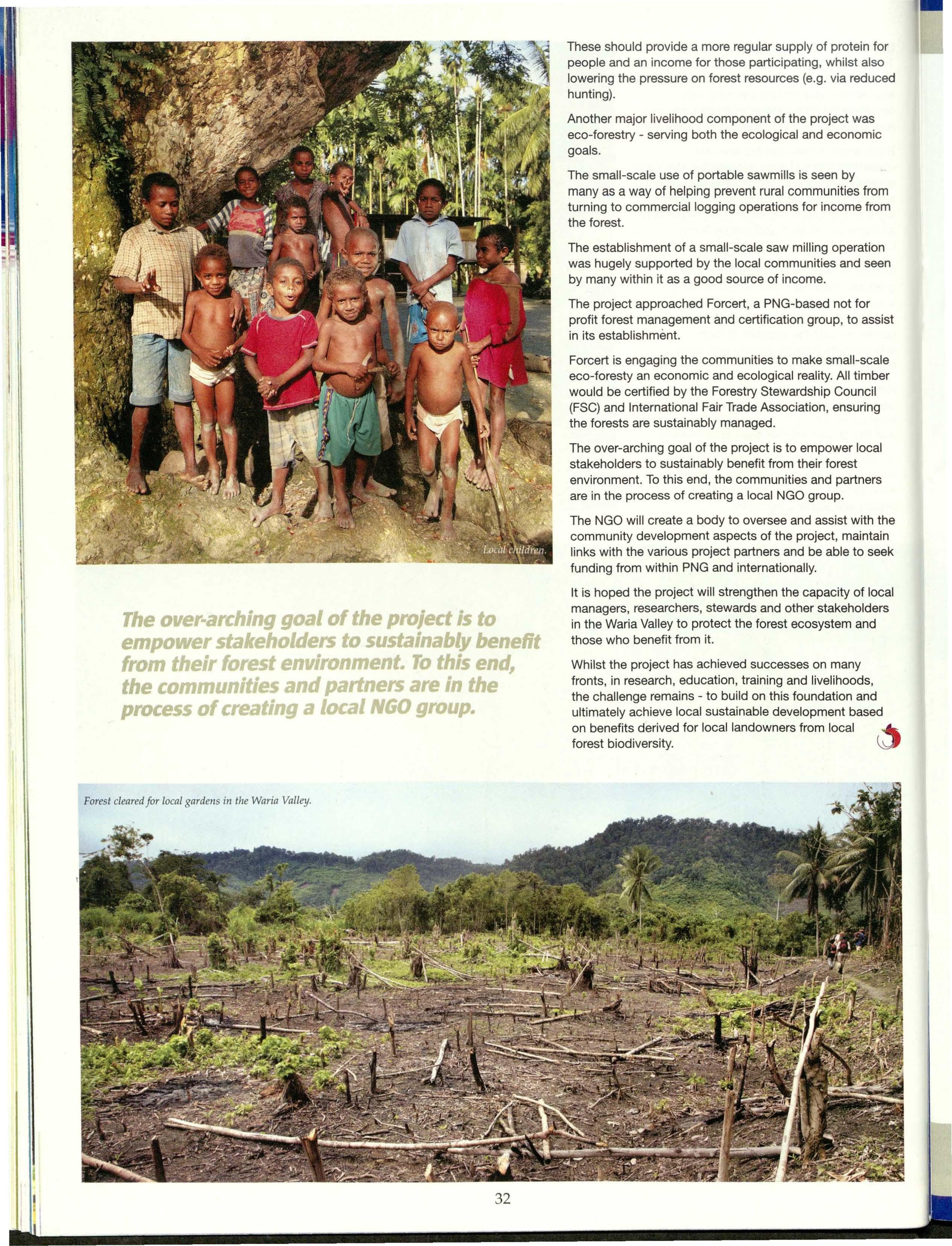
These should provide a more regular supply of protein for people and an income for those participating, whilst also lowering the pressure on forest resources (e.g. via reduced hunting).
Another major livelihood component of the project was eco-forestry - serving both the ecological and economic goals.
The small-scale use of portable sawmills is seen by many as a way of helping prevent rural communities from turning to commercial logging operations for income from the forest.
The establishment of a small-scale saw milling operation was hugely supported by the local communities and seen by many within it as a good source of income.
The project approached Forcert, a PNG-based not for profit forest management and certification group, to assist in its establishment.
Forcert is engaging the communities to make small-scale eco-foresty an economic and ecological reality. All timber would be certified by the Forestry Stewardship Council (FSC) and International Fair Trade Association, ensuring the forests are sustainably managed.
The over-arching goal of the project is to empower local stakeholders to sustainably benefit from their forest environment. To this end, the communities and partners are in the process of creating a local NGO group.
The NGO will create a body to oversee and assist with the community development aspects of the project, maintain links with the various project partners and be able to seek funding from within PNG and internationally.
It is hoped the project will strengthen the capacity of local managers, researchers, stewards and other stakeholders in the Waria Valley to protect the forest ecosystem and those who benefit from it.
Whilst the project has achieved successes on many fronts, in research, education, training and livelihoods, the challenge remains - to build on this foundation and ultimately achieve local sustainable development based on benefits derived for local landowners from local forest biodiversity.
1nfor also ::Juced as mic from from .tion seen ,r :1ssist ;cale nber cil ing ,cal ers :h the 1tain seek local ::Jers 1d 5, 1d ;ed
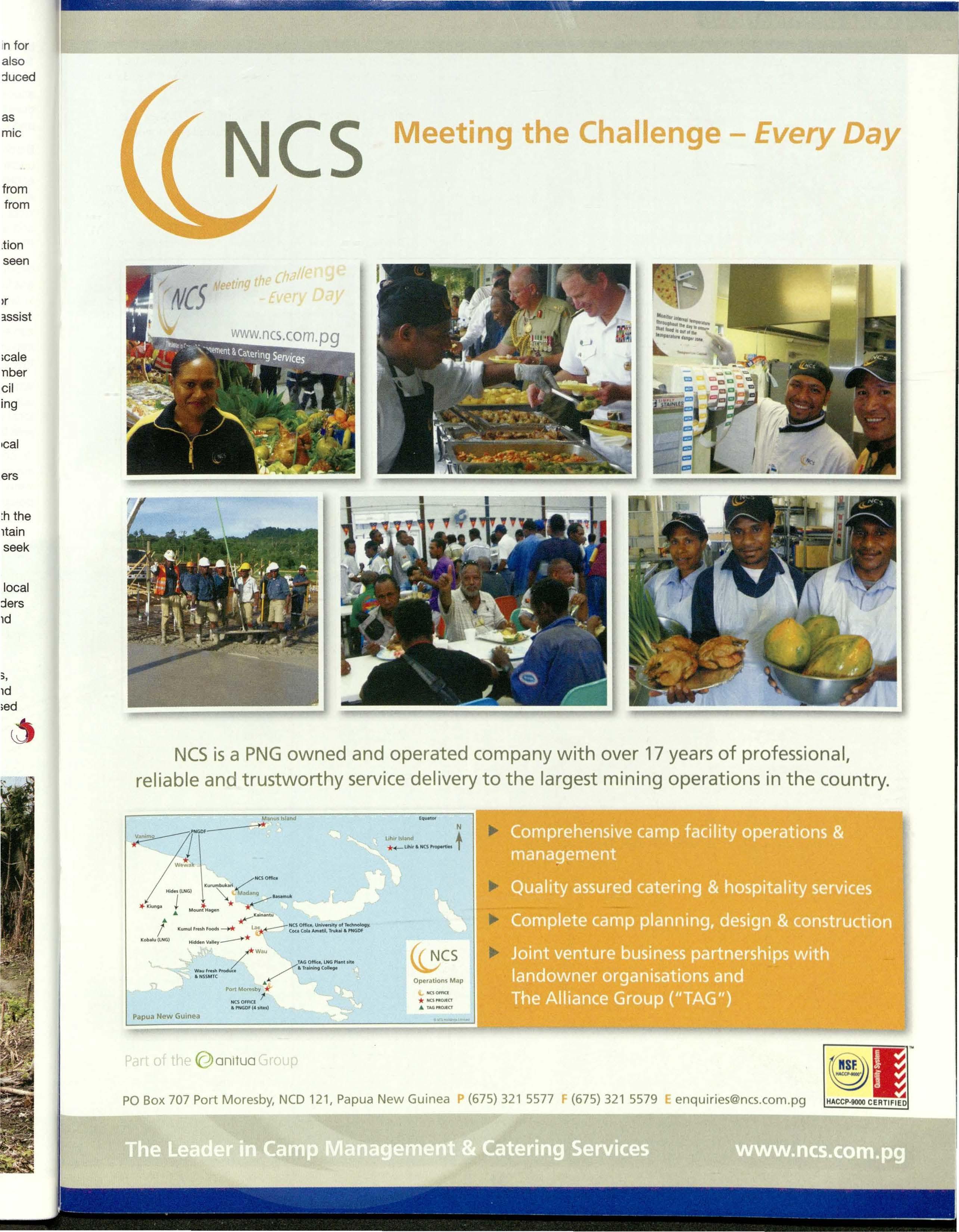
NCSis a PNG owned and operated company with over 17 years of professional, reliable and trustworthy service delivery to the largest mining operations in the country. ,........,/"c",.,.. /fLNGJ M1>1h1ng Jf-1tlun9- + • * *~ & MounlH.-, A rll.alna,m, MCSOffQ,Unlwnityofl~ 1(,-IF<Wlfoodt~ <CouCola"""tUl,ln.kala,NGOf Kobalu (LN6) HldciionValley___.* Wa"/TAGO~,lNGPIM1lhe w..,,...,.~ arrMN<19ColleiJt' aNSSMTC . PortMO<'ffly 1(" NCSOHICI,. al'tlGOfl•.it.,J Papua New Guinea

BY SUE FITCHER
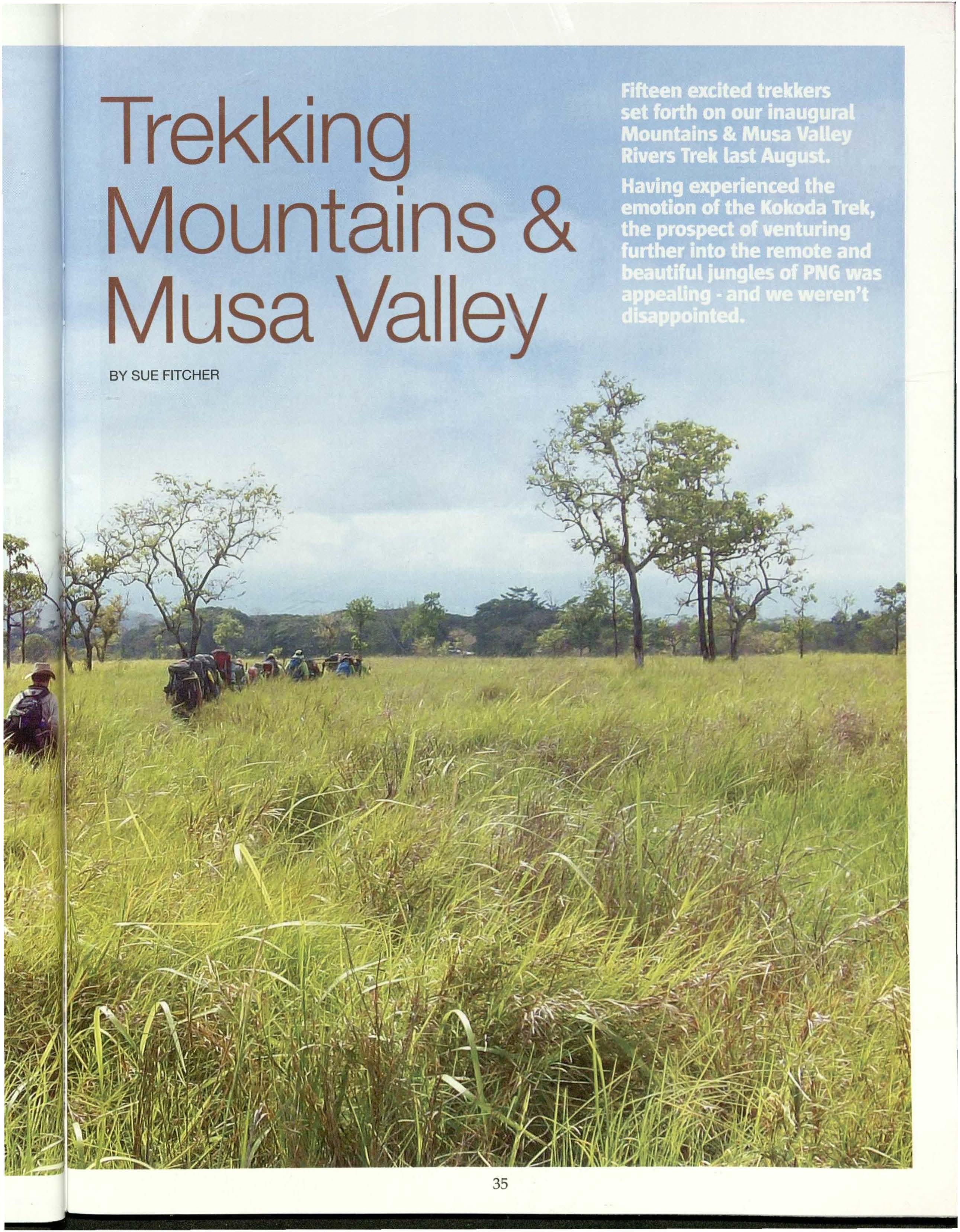
fter an overnight stay at Loloata Island Resort, we set off by road to Moreguina, a trip that took approximately six hours.
On arrival at Yanu Station (Moreguina), we experienced some teething problems with landowners in regard to track access. As developing good relationships with landowners is extremely important to us, the group returned to Moreguina to stay overnight, to allow our two leaders to hold meetings with the village elders the next day.
Moreguina Primary School offered us some amazing hospitality and we spent the night in the Class 7 classroom. The following morning, we were humbled by some beautiful greetings from the kids as they arrived at school. Although this delay was unexpected and initially unwelcomed, it did provide us with a wonderful experience we would not otherwise have had.
Nonetheless, by the time we started trekking, we were now running one full day behind

schedule. We had, however, sorted out some challenging clan and cultural issues and were given a warm send-off by the villagers at Moreguina.
This trek is quite unique and covered some varied terrain. We walked up and alongside many rivers before we climbed the main range - the Owen Stanley.
Mountains & Musa Valley is literally a rivers' trek as a good deal of time is spent in or beside the six rivers in the area. Rivers on the south side of the range are the More, Uma, Aisa and Nicosia. On the north side, we tackled the Ukuma, crossing this river more than 60 times in one day! Finally, we came to know that the Musa River is the ninth largest in PNG. But more on that later
Before we would conclude the trekking component of our trip, we had much more to experience. We climbed mountain ranges, waged war on the leech community, sang songs and encouraged each other when we
some were t ,me ;ide 1 range
ers' le, we 1ore Tie to rgest in xe 1ges, ,g , we
got tired. We walked through beautiful savannah grasslands, unsheltered in the hot sun.
Some days we set off in darkness to watch the sun rise and witness the beauty of the jungle unfolding with the emerging light. We became accustomed to changing our boots several times a day as we switched between mountain climbing and river walking.
We crossed rivers - did I mention that we crossed a few rivers? Some we waded ankle deep, others were waist high, and many threw up a fast flowing current as an additional challenge (as if we needed one).
Athough the rivers were varied, one thing was constant. Each time we were ready to cross the rivers, there beside us was the same thing - an outstretched hand. Our beautiful carriers stood strong and tall by our sides at every point.
For many of our carriers, this trek was new to them as well. Although a good deal of the Mountains and Musa Valley trek covers the Oro Province, which is home to many of our boys, they had not experienced this
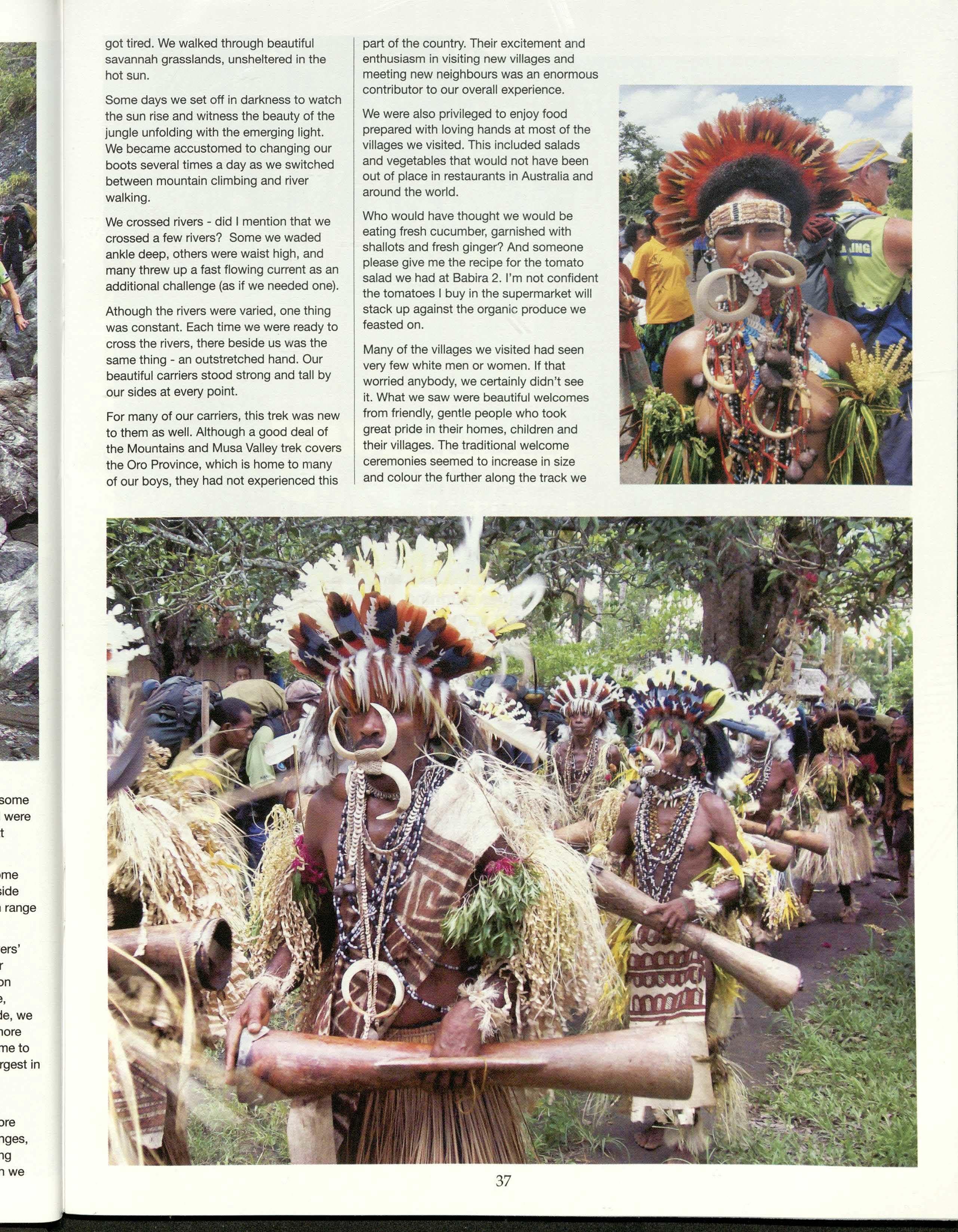
part of the country. Their excitement and enthusiasm in visiting new villages and meeting new neighbours was an enormous contributor to our overall experience. We were also privileged to enjoy food prepared with loving hands at most of the villages we visited. This included salads and vegetables that would not have been out of place in restaurants in Australia and around the world.
Who would have thought we would be eating fresh cucumber, garnished with shallots and fresh ginger? And someone please give me the recipe for the tomato salad we had at Babira 2. I'm not confident the tomatoes I buy in the supermarket will stack up against the organic produce we feasted on.
Many of the villages we visited had seen very few white men or women. If that worried anybody, we certainly didn't see it. What we saw were beautiful welcomes from friendly, gentle people who took great pride in their homes, children and their villages. The traditional welcome ceremonies seemed to increase in size and colour the further along the track we
...get out intothe ruralareasof PNG andseewhatthis countryis really about.
TheMountainsand MusaValleyTrek combinesstunning scenery,wonderful sunsetsand magnificentculture for a trulyauthentic experience.

got - the bush telegraph is alive and well it seems, and no-one wanted to be outdone! The ceremony at Embessa, our last village, included 29 national dancers in full cultural dress and continued for over two hours.
During the ceremony, one of our leaders was given the honour of becoming a Chief of Ra Ra Tu - the 3 combined villages of Embessa - and presented with the chief pig tusk necklace.
Trekking over, we set forth the following morning in our banana boat down the Musa River to Foru Island for an overnight stay. Crossing some of its tributaries earlier may have been our introduction, but it was during our full-day boat trip, covering the 113km distance from Embessa to Foru Island, that we were really able to appreciate the magnificence of Musa and its surrounds.
I can happily report that the crocodiles with whom we shared this river chose to view us from the relative comfort of the river banks. I also happily report that while the guesthouse
on Foru Island was only 3-4 metres away from the water's edge, it was raised one metre off the ground, allowing all trekkers to sleep peacefully!
So, here we were at the final day of our adventure. Pre-dawn, we climbed back into our boat to travel from the mouth of the Musa River across to Oro Bay. If you have never been on the water to watch the sun rise, I have one thing to say to you. You must. We race, we rush and we never have enough time.
But here in your banana boat in the Solomon Sea, you can stop and bear witness as nature reveals itself slowly, in its own time. The water begins to sparkle in response to the flicker of the sun's rays and the sky shakes off its slumber with a changing palette of colours.
After approximately 175km over two days in our boat, we arrived at Oro Bay, where we were again greeted in magnificent fashion by the locals in traditional costume, dancing and singing their welcome to us.
Papua New Guinea often makes the headlines in the Australian press for all the wrong reasons. But like any other countries, one need take a more careful approach.
In fact, I would suggest cities in many first world nations require an even more careful approach! (Think King St, Melbourne and Kings Cross, Sydney.)
But get out into the rural areas of PNG and see what this country is really about. The Mountains and Musa Valley Trek combines stunning scenery, wonderful sunsets and magnificent culture for a truly authentic experience.
There are treks in PNG and around the world that have become very popular - and justifiably so. But if you're after the road less travelled, where you know you will be the only group on the trek, where the scenery is pristine and the people totally excited to meet you, then perhaps this is the one for you. The jungles of PNG - it doesn't get much
better.
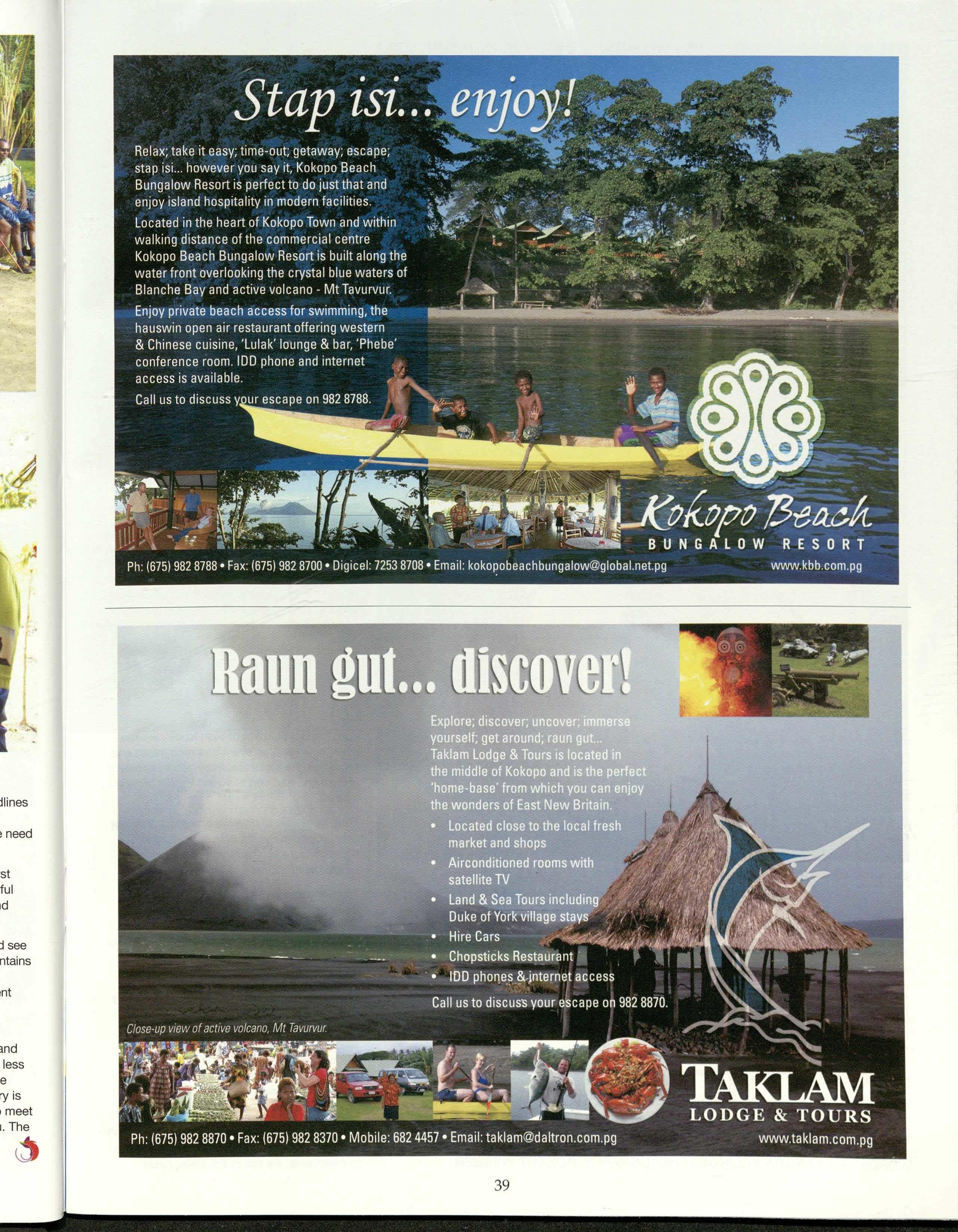
So much more than a
Elegant,graceful, confident,lntelUgentbeautiful Theseare just someof the wordsused to describethe J.J. women who participatedin the MissSouthPacificPageant (MSPP)201.0, held In Port Moresby,PapuaNew Guinea.

owever, unlike most pageants, the Miss South Pacific Pageant places an emphasis on the cultural awareness of each contestant. There are certainly no bikinis. Instead, audiences are treated to a sarong category, a pre-pageant interview and research topic presentation, a traditionally inspired costume category, a talent category and a stage interview.
The pageant has always been about finding a cultural ambassador for the South Pacific region - quite a task when one considers the various ethnic groups that make up the region - Melanesians, Micronesians and Polynesians.
It could never be a beauty contest because ideas of beauty in the region differ from one ethnic group to the next. It was always going to be much more than a beauty pageant.
During the inaugural MSPP over 20 years ago, the Government of Samoa defined the event as a regional event that recognises and promotes the attributes, intelligence, talents, culture and tradition of young Pacific Islands women.
They were able to develop a pageant that not only promotes Pacific islands' culture and heritage, but also the region and its many tourist destinations.
The pageant has been hosted by American Samoa, Tonga, Cook Islands, New Zealand, Fiji, and now, Papua New Guinea. Port Moresby and Alotau played host to our guests for the week-long event that stretched from November 21 to 27, 2010.
The most telling sign that this was not merely a beauty pageant was the speech given by the Deputy Prime Minister of Samoa, Misa Telefoni, Chairman of the MSPP Board, on Wednesday, November 24, 2010, during a dinner at the State Function Room at Parliament House, hosted by NCO Governor Powes Parkop.
He spoke of mana and fa'a, words that I didn't quite understand, but through context, came to mean what we call in Tok Pisin, pasin.
t , en ant rt
an , of 1 no :edto ·iew tionally ~gory ding cific ·s the region esians. 1use one going 1t. .rs I the lS and lents, lands 1atnot nd ny can and, guests 'rom nerely 1 by lisa on ;J ernor I didn't came ).

We have been providing engineering and project management solutions for PNG and the South Pacific for more than 30 years.
In Goroka in the Eastern Highlands Province of PNG we built a state-of-the-art lecture theatre for the University of Goroka, one of the fastest growing learning institutions in the region. With a 500 person capacity, the theatre is proving
a welcomed facility for both the university and wider Goroka community.
While at the Australia-Pacific Technical College in Samoa, we designed and developed training workshops and facilities to support quality vocational training for people across the South Pacific.
With offices in Papua New Guinea, Australia, Samoa,
Tonga, Solomon Islands, Fiji and Vanuatu we have the team to engineer solutions for our next generation right here in PNG and the South Pacific.
Trying to explain this term to a Westerner is near impossible, there is no one word in English that encapsulates the essence of this term. How do you explain an allencompassing traditional system of behaviour and responsibilities that spell out each person's relationship to one another, and to persons holding positions of authority, to someone from a culture that would view anything like this as authoritarian? Good etiquette simply wasn't a good enough description.
Women in PNG are valued for this quality. It seemed to be the very quality that women in the region were also valued for. Cultural awareness, pasin and an ability to share eloquently and elegantly these qualities with any and all, appeared to be important attributes of any Miss South Pacific as the region's cultural ambassador.
The theme for the 2010 pageant was 'Empowering Women'. Educational backgrounds of contestants included students and tertiary graduates. Intellectually, this was a strong group of women. I was interested to see how they found that balance between their modern lives living as empowered women with access to an education, and keeping their cultural traditions alive.
My Western influenced grasp of these two concepts would only allow me to see these types of women as at odds, and never able to co-exist in the same individual.
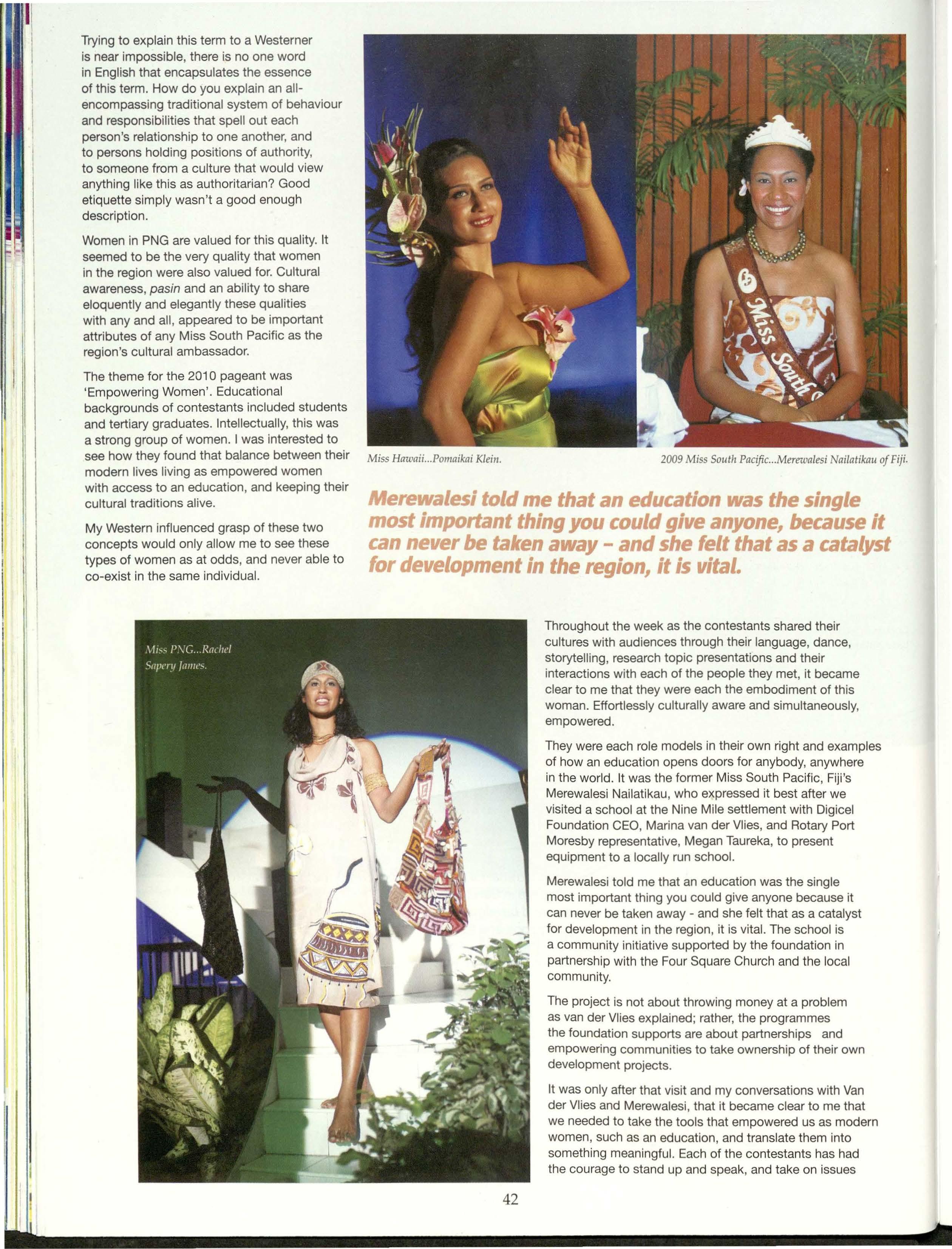
Merewalesitold me that an educationwas the single most importantthingyou couldgive anyone,becauseit can never be takenaway - and she felt that as a catalyst for developmentin the region, it is vital.
Throughout the week as the contestants shared their cultures with audiences through their language, dance, storytelling, research topic presentations and their interactions with each of the people they met, it became clear to me that they were each the embodiment of this woman. Effortlessly culturally aware and simultaneously, empowered.
They were each role models in their own right and examples of how an education opens doors for anybody, anywhere in the world. It was the former Miss South Pacific, Fiji's Merewalesi Nailatikau, who expressed it best after we visited a school at the Nine Mile settlement with Digicel Foundation CEO, Marina van der Vlies, and Rotary Port Moresby representative, Megan Taureka, to present equipment to a locally run school.
Merewalesi told me that an education was the single most important thing you could give anyone because it can never be taken away - and she felt that as a catalyst for development in the region, it is vital. The school is a community initiative supported by the foundation in partnership with the Four Square Church and the local community.
The project is not about throwing money at a problem as van der Vlies explained; rather, the programmes the foundation supports are about partnerships and empowering communities to take ownership of their own development projects.
It was only after that visit and my conversations with Van der Vlies and Merewalesi, that it became clear to me that we needed to take the tools that empowered us as modern women, such as an education, and translate them into something meaningful. Each of the contestants has had the courage to stand up and speak, and take on issues
The contestantsat the crow11ingnight. of importance in their own countries, championing causes in their own communities.
Perhaps the most significant experience of the pageant for me, occurred at the research topic presentation when Miss Aotearoa, Angela Cudd, began her presentation by saying that 'a very brave lady asked her if she was at all Maori'.
Angela is more Caucasian looking. She said culture should not be defined by skin colour, or a particular ethnic look. Culture is something that we each carry within. She spoke Maori fluently and effortlessly for the thirty seconds of her presentation. Throughout the pageant, she told Maori myths and legends, and carried herself in a way that spoke volumes of her own identity as a proud Maori woman.
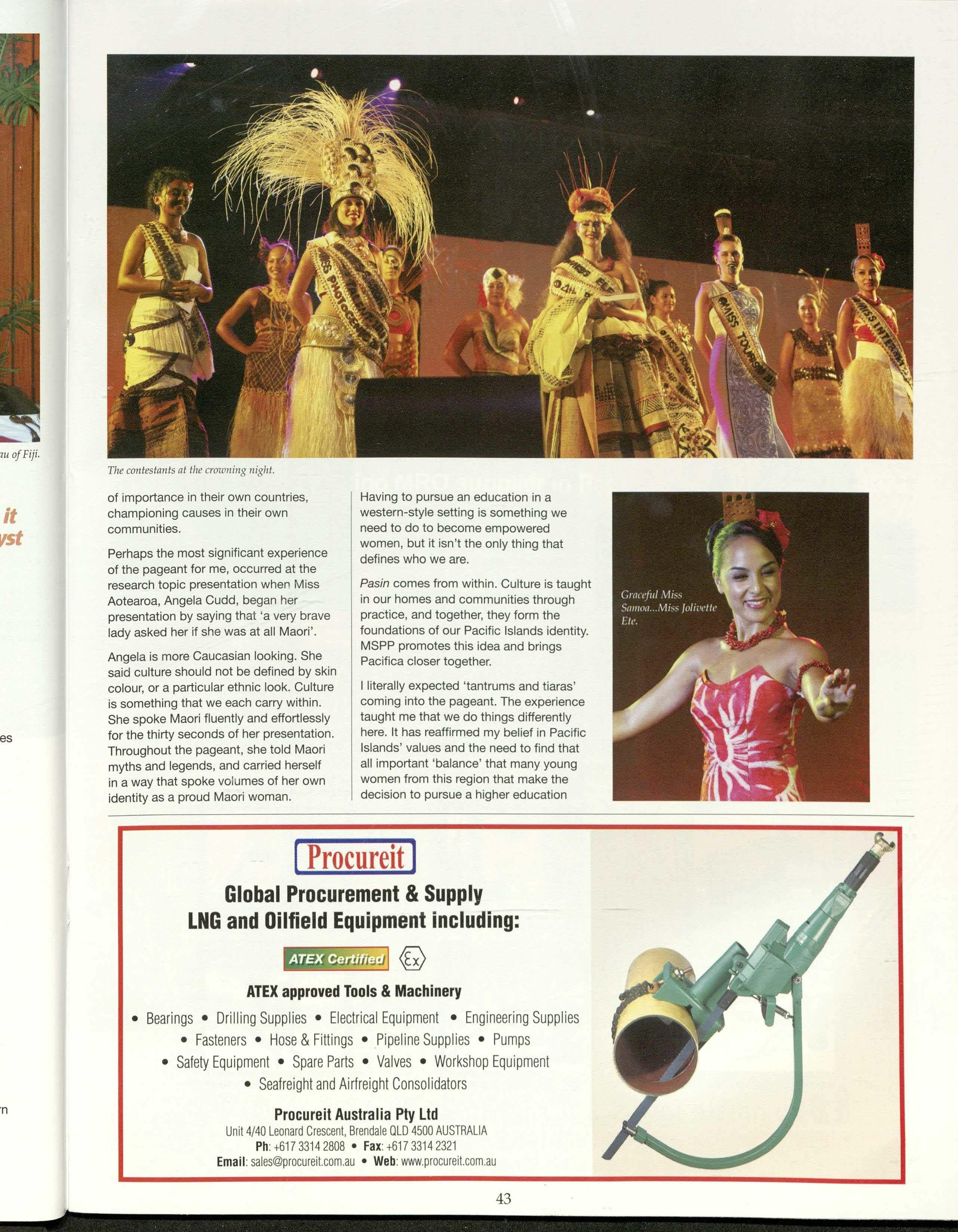
Having to pursue an education in a western-style setting is something we need to do to become empowered women, but it isn't the only thing that defines who we are.
Pasin comes from within. Culture is taught in our homes and communities through practice, and together, they form the foundations of our Pacific Islands identity. MSPP promotes this idea and brings Pacifica closer together.
I literally expected 'tantrums and tiaras' coming into the pageant. The experience taught me that we do things differently here. It has reaffirmed my belief in Pacific Islands' values and the need to find that all important 'balance' that many young women from this region that make the decision to pursue a higher education

In PNG,the land of a thousandjourneys,Miss JoyanaMeyer,representingthe CookIslands, beganher ownjourneyas our region'snewest culturalambassador,when she was crownedMiss SouthPacific2010.
keep referring to. Referring to each other as sisters, the contestants were, from my behind the scenes observations, a kind and supportive group of young women.
In her final speech, the outgoing Miss South Pacific, Merewalesi thanked the Samoan Government for the initiative and foresight displayed in developing this pageant that is essentially - so much more.
In PNG, the land of a thousand journeys, Miss Joyana Meyer, representing the Cook Islands, began her own journey as our region's newest cultural ambassador when she was crowned Miss South Pacific 2010.
During the 201 0 pageant, Samoa was chosen by the Board of MSPP as the host nation for this year's pageant, which will take place in December in Apia. U
• Alexandra Kalinoe is the Media Coordinator for MSPP PNG 2010


Every day, millions of employees are exposed to insects that can carry malaria, lyme disease, dengue fever and other dangerous diseases. Insect Shield work wear can be as essential to workplace safety as high-visibility and fire-resistant garments. The Insect Shield Workplace Safety & Health Program makes protective clothing and gear items available to workers in at-risk locations across the globe. The assortment consists of work wear, professional apparel and accessories - including clothing that al.so offers sun rotection, flame resistance and high visibility- as well as additional protective items such as mosquito nets.
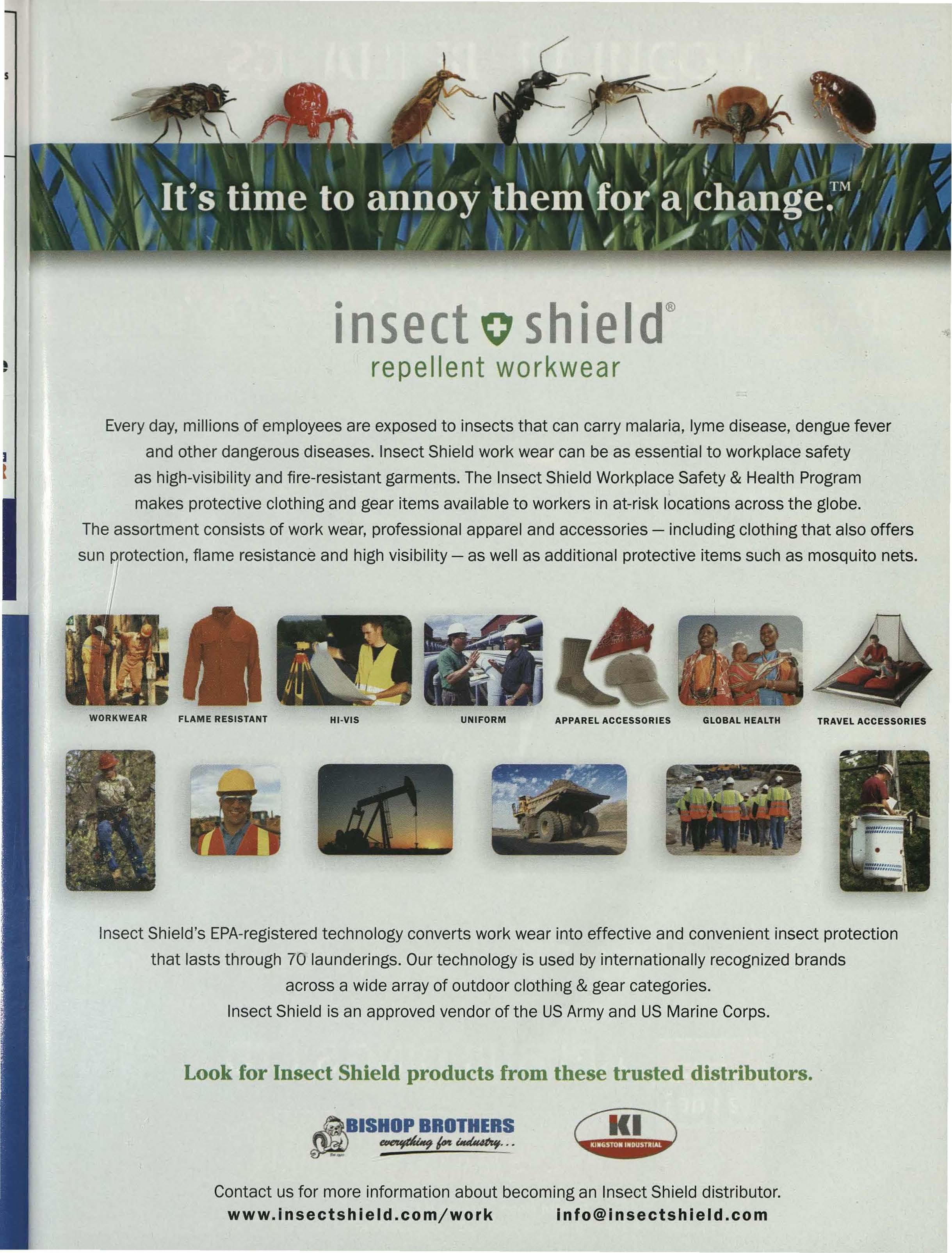
Insect Shield's EPA-registered technology converts work wear into effective and convenient insect protection that lasts through 70 launderings. Our technology is used by internationally recognized brands across a wide array of outdoor clothing & gear categories. Insect Shield is an approved vendor of the US Army and US Marine Corps.
Look
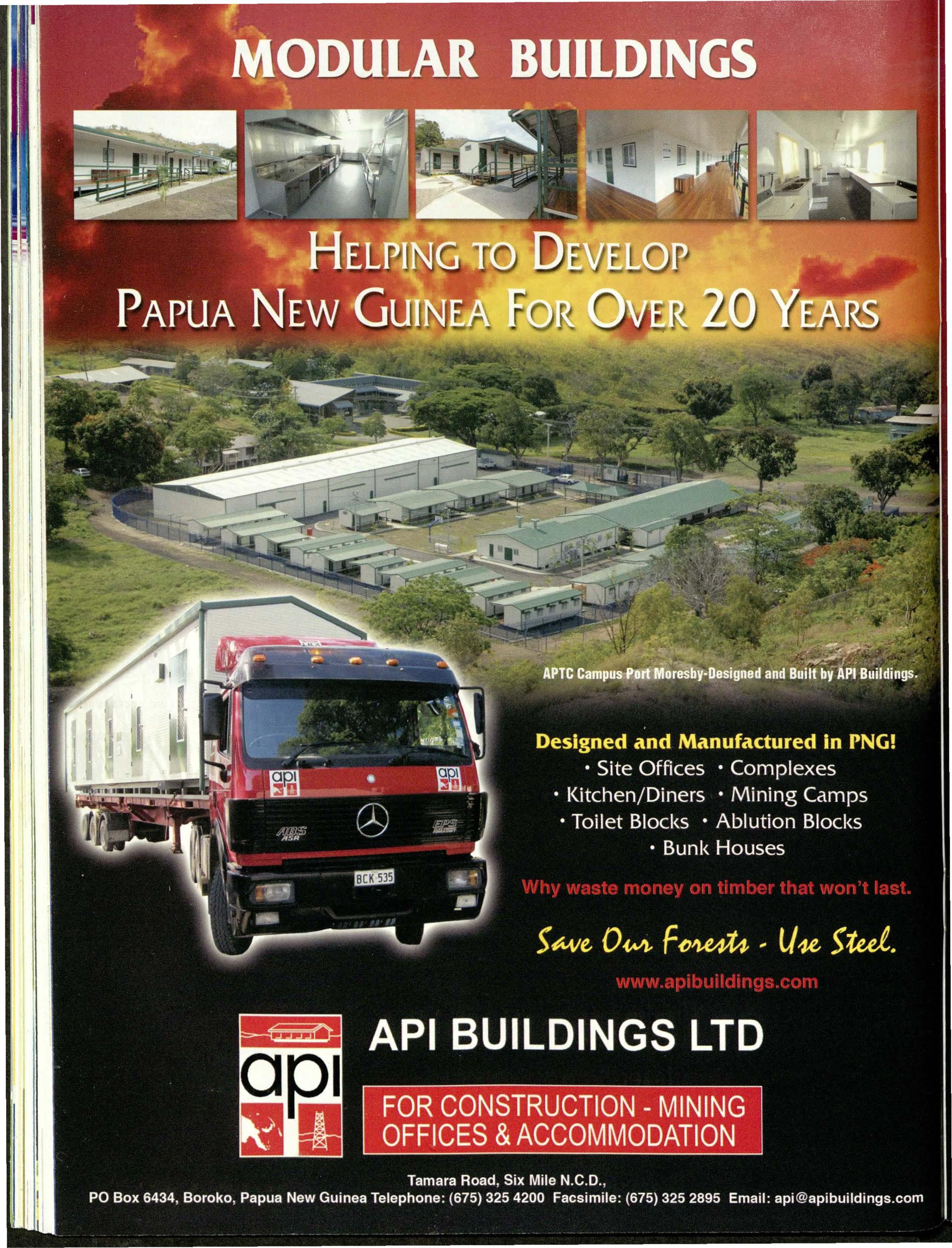
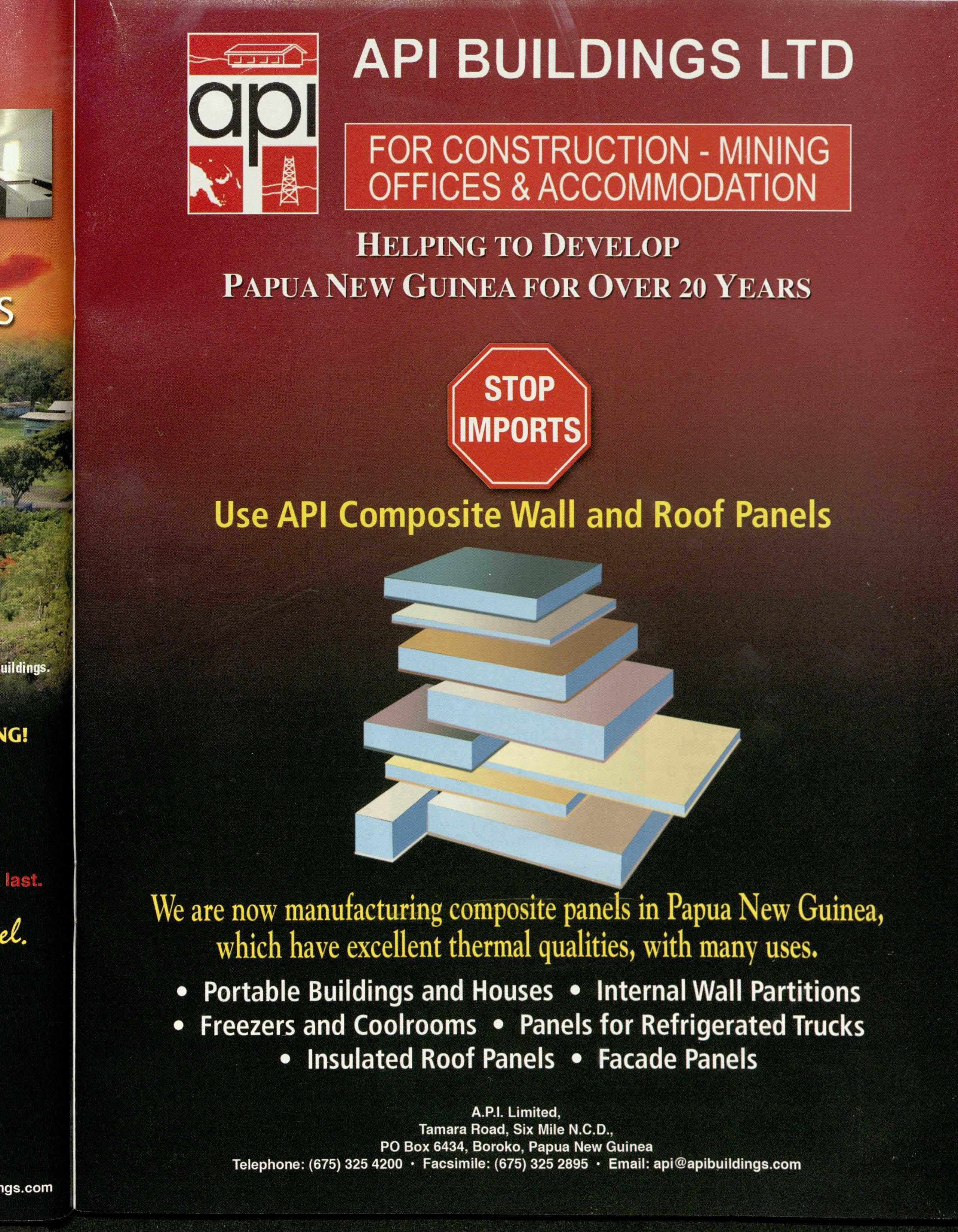
Motoring from Alotau acrossMilne Bay as the sun set was a cliched way to arrive. But with calm seas, it made for a very pleasantjourney.
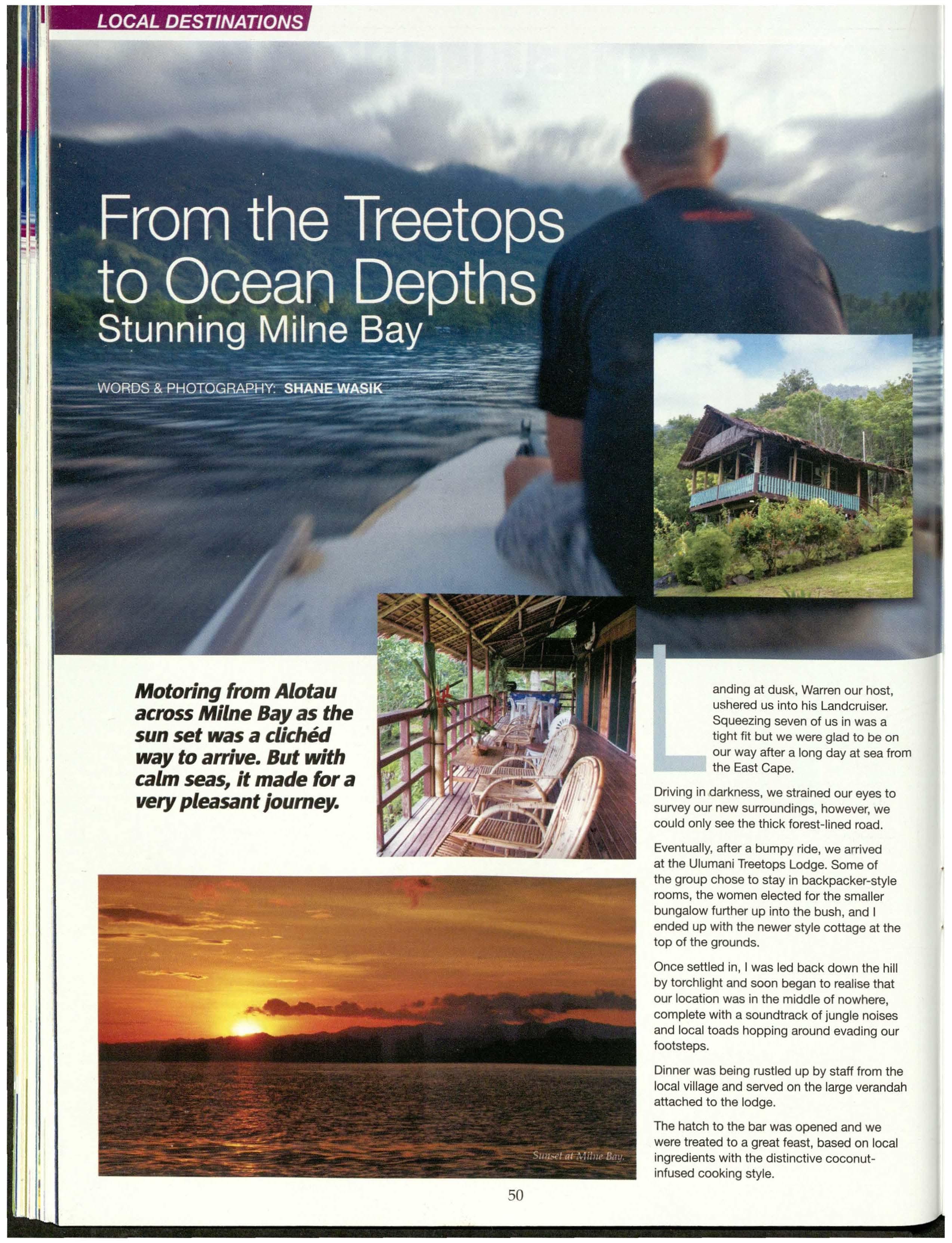
anding at dusk, Warren our host, ushered us into his Landcruiser. Squeezing seven of us in was a tight fit but we were glad to be on our way after a long day at sea from the East Cape.
Driving in darkness, we strained our eyes to survey our new surroundings, however, we could only see the thick forest-lined road.
Eventually, after a bumpy ride, we arrived at the Ulumani Treetops Lodge. Some of the group chose to stay in backpacker-style rooms, the women elected for the smaller bungalow further up into the bush, and I ended up with the newer style cottage at the top of the grounds.
Once settled in, I was led back down the hill by torchlight and soon began to realise that our location was in the middle of nowhere, complete with a soundtrack of jungle noises and local toads hopping around evading our footsteps.
Dinner was being rustled up by staff from the local village and served on the large verandah attached to the lodge.
The hatch to the bar was opened and we were treated to a great feast, based on local ingredients with the distinctive coconutinfused cooking style.
host, 1iser. as a beon sea from yes to r, we 1ad. ,ed of r-style 3ller jl 1 at the :he hill e that ,ere, 1oises ng our ·om the 3randah we 1 local Jt-
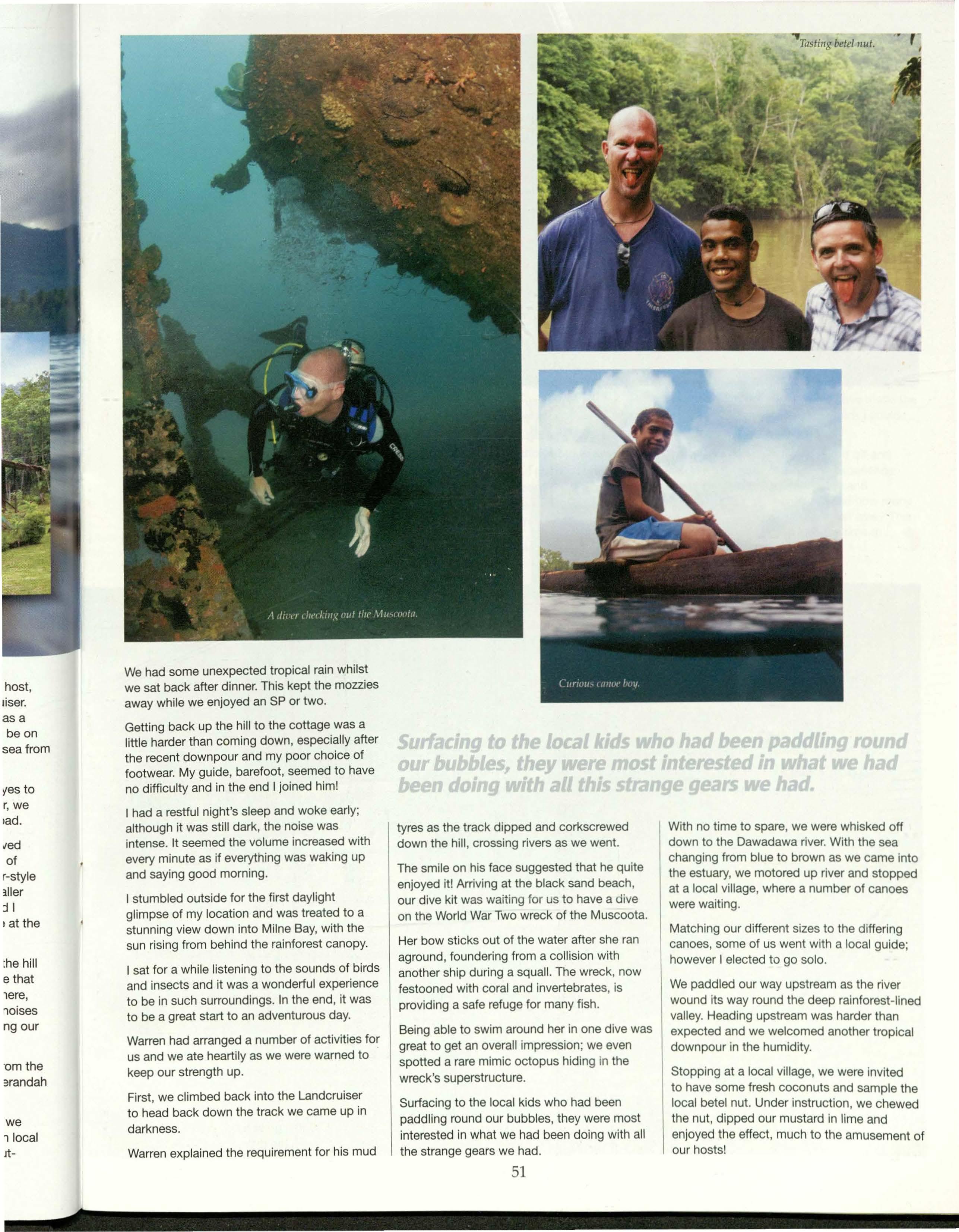
We had some unexpected tropical rain whilst we sat back after dinner. This kept the mozzies away while we enjoyed an SP or two.
Getting back up the hill to the cottage was a little harder than coming down, especially after the recent downpour and my poor choice of footwear. My guide, barefoot, seemed to have no difficulty and in the end I joined him!
I had a restful night's sleep and woke early; although it was still dark, the noise was intense. It seemed the volume increased with every minute as if everything was waking up and saying good morning.
I stumbled outside for the first daylight glimpse of my location and was treated to a stunning view down into Milne Bay, with the sun rising from behind the rainforest canopy.
I sat for a while listening to the sounds of birds and insects and it was a wonderful experience to be in such surroundings. In the end, it was to be a great start to an adventurous day.
Warren had arranged a number of activities for us and we ate heartily as we were warned to keep our strength up.
First, we climbed back into the Landcruiser to head back down the track we came up in darkness.
Warren explained the requirement for his mud
urfacingto the localkidswho had been paddlinground ur bubbles,they were mostinterest din what w had been doingwith all thisstrangegearswe had.
tyres as the track dipped and corkscrewed down the hill, crossing rivers as we went.
The smile on his face suggested that he quite enjoyed it! Arriving at the black sand beach, our dive kit was waiting for us to have a dive on the World War Two wreck of the Muscoota.
Her bow sticks out of the water after she ran aground, foundering from a collision with another ship during a squall. The wreck, now festooned with coral and invertebrates, is providing a safe refuge for many fish.
Being able to swim around her in one dive was great to get an overall impression; we even spotted a rare mimic octopus hiding in the wreck's superstructure.
Surfacing to the local kids who had been paddling round our bubbles, they were most interested in what we had been doing with all the strange gears we had.
With no time to spare, we were whisked off down to the Dawadawa river. With the sea changing from blue to brown as we came into the estuary, we motored up river and stopped at a local village, where a number of canoes were waiting.
Matching our different sizes to the differing canoes, some of us went with a local guide; however I elected to go solo.
We paddled our way upstream as the river wound its way round the deep rainforest-lined valley. Heading upstream was harder than expected and we welcomed another tropical downpour in the humidity.
Stopping at a local village, we were invited to have some fresh coconuts and sample the local betel nut. Under instruction, we chewed the nut, dipped our mustard in lime and enjoyed the effect, much to the amusement of our hosts!
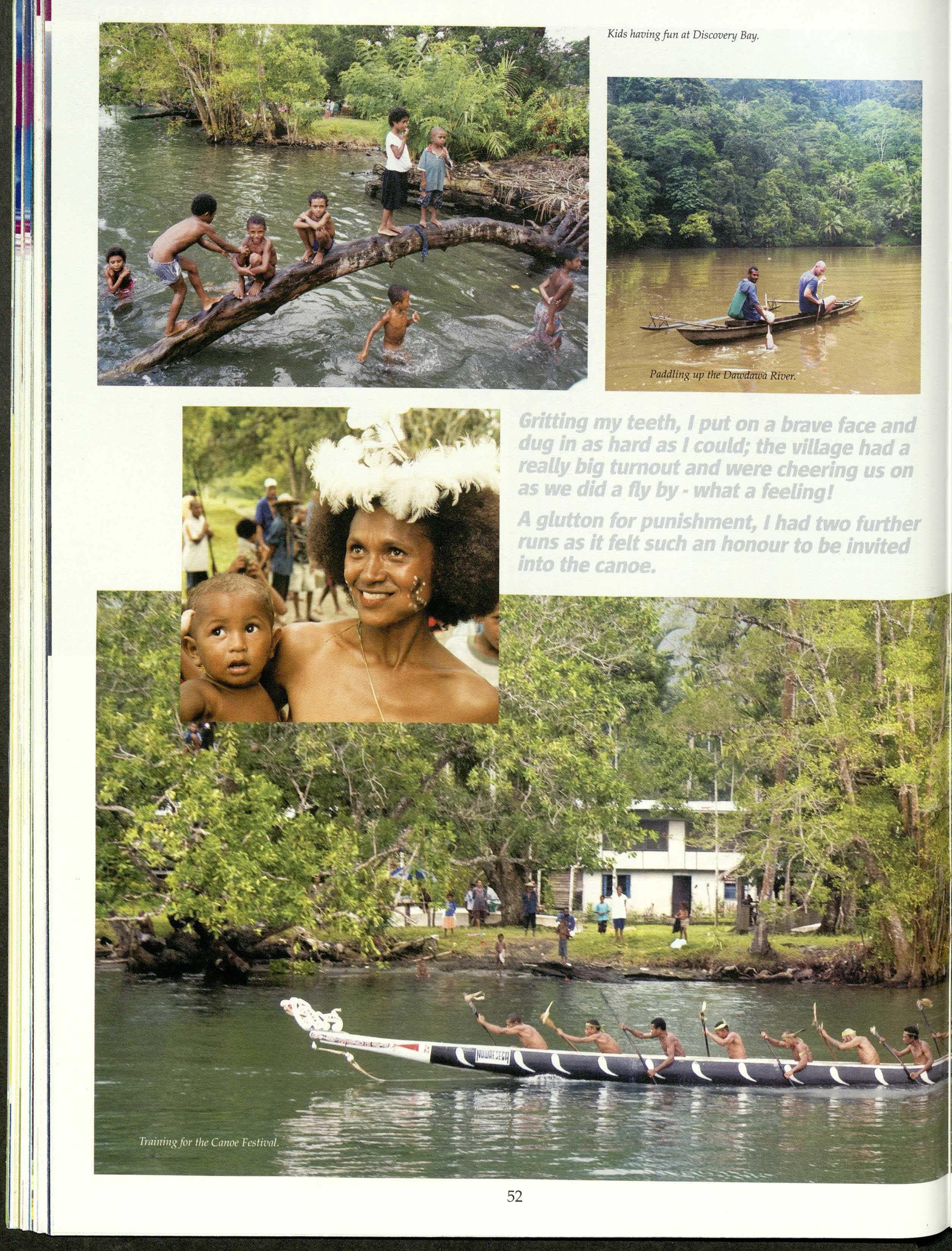
G ·ttingmy teeth, I put on a bravefaceand dug in as hard as I could;the uillagehad a re, lly big turnoutand were cheeringus on as Wi did a fly by- what a feeling!
glutton for punishment, I had two further runsas it felt suchan honourto be invited into the canoe.
Paddlingbacktowardsthe village.
Our next stop was back at Waga Waga and with the Alotau Canoe Festival approaching, the men were training for the race. It was a great sight to see the canoe at full tilt, 50 men digging in at full pace, chanting as they paddled! Surely PNG champions!
On land, the three men in our party were invited to test our skills and join them in a few training runs. Stripped down to our shorts, we sat in the canoe along with some attentive coaches.
We were encouraged to keep in time with the others and it didn't take us long to get the rhythm. Initially, I thought we may go a short distance but halfway up the bay, my arms were burning. I had no choice but to keep going. Gritting my teeth, I put on a brave face and dug in as hard as I could; the village had a really big turnout and were cheering us on as we did a fly by - what a feeling!
A glutton for punishment, I had two further
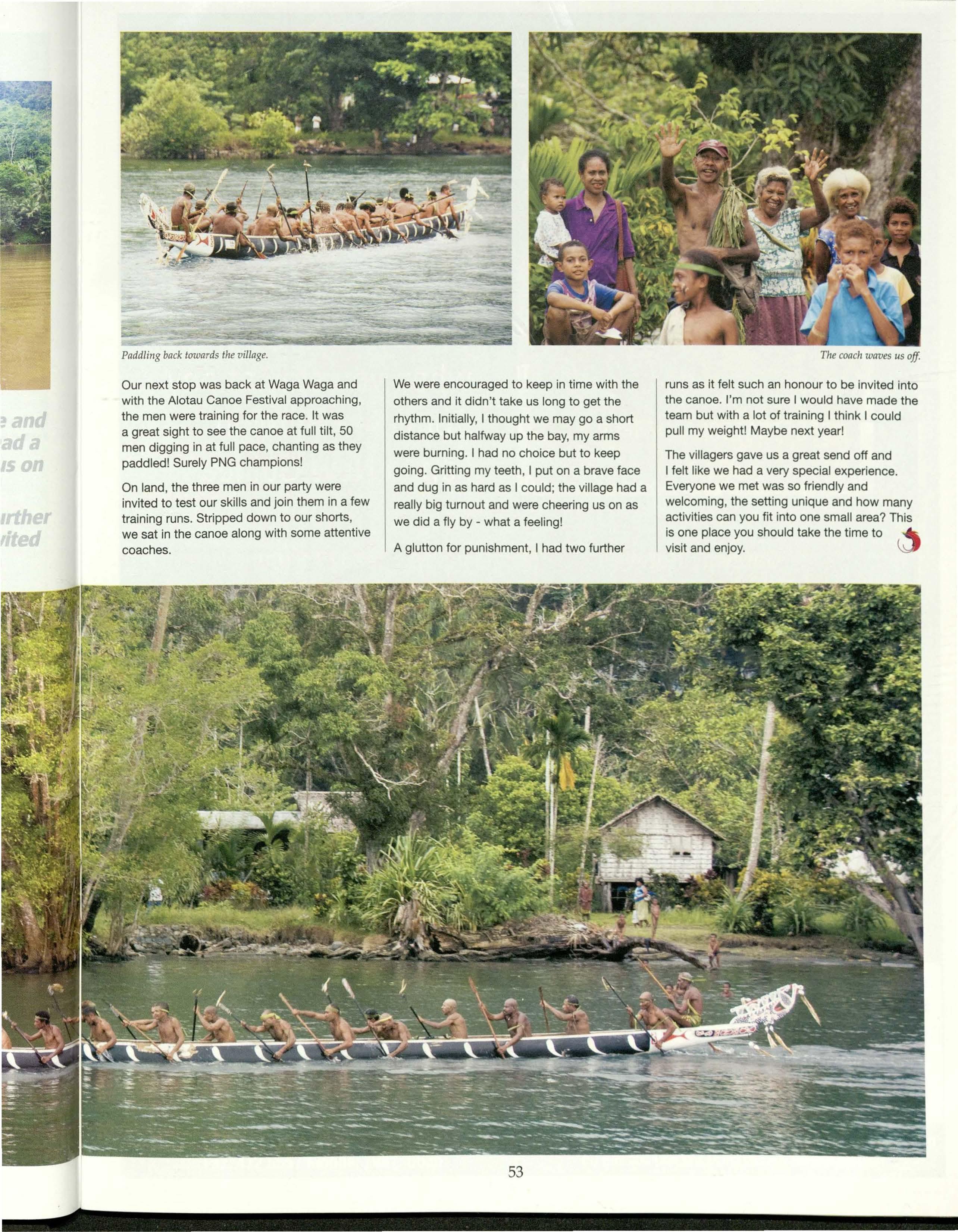
The coachwaves us off
runs as it felt such an honour to be invited into the canoe. I'm not sure I would have made the team but with a lot of training I think I could pull my weight! Maybe next year!
The villagers gave us a great send off and I felt like we had a very special experience. Everyone we met was so friendly and welcoming, the setting unique and how many activities can you fit into one small area? This is one place you should take the time to ._ visit and enjoy.
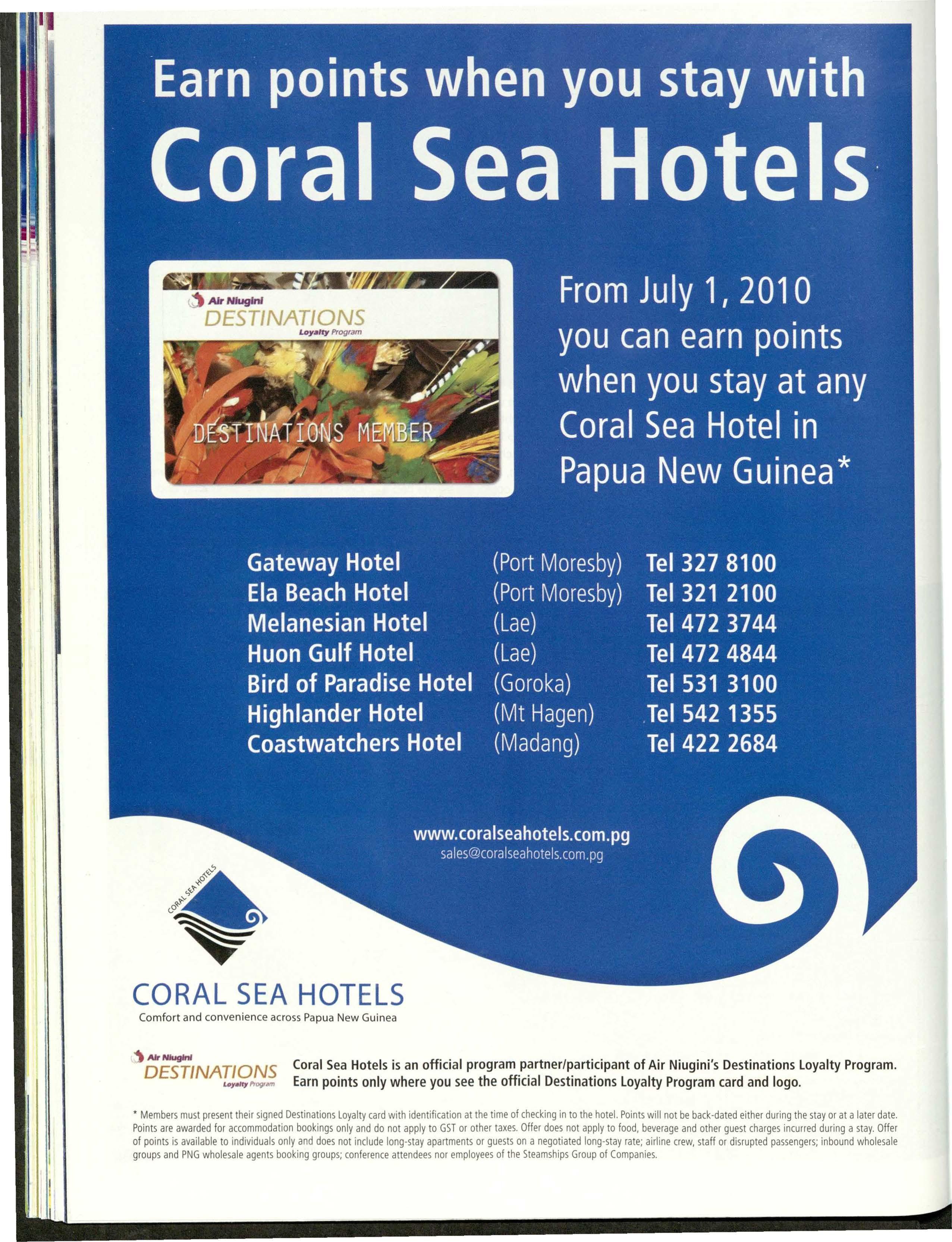
Comfort and convenience across Papua New Guinea ,_Nluglnl DESTINATIONS Loy•Hy Progtdm
CoralSeaHotelsis an officialprogrampartner/participantof Air Niugini'sDestinationsLoyaltyProgram. Earnpointsonlywhereyou seethe officialDestinationsLoyaltyProgramcardand logo.
• MembersmustpresenttheirsignedDestinationsLoyaltycardwith identificationat the timeof checkingin to thehotel.Pointswill not beback-datedeitherduringthestayor at a laterdate. Pointsareawardedfor accommodationbookingsonlyanddo not applyto GSTor othertaxes.Offerdoesnot applyto food,beverageandotherguestchargesincurredduringa stay.Offer of pointsis availableto individualsonlyanddoesnot includelong-stayapartmentsor guestson a negotiatedlong-stayrate;airlinecrew,staff or disruptedpassengers;inboundwholesale groupsandPNGwholesaleagentsbookinggroups;conferenceattendeesnor employeesof the SteamshipsGroupof Companies.

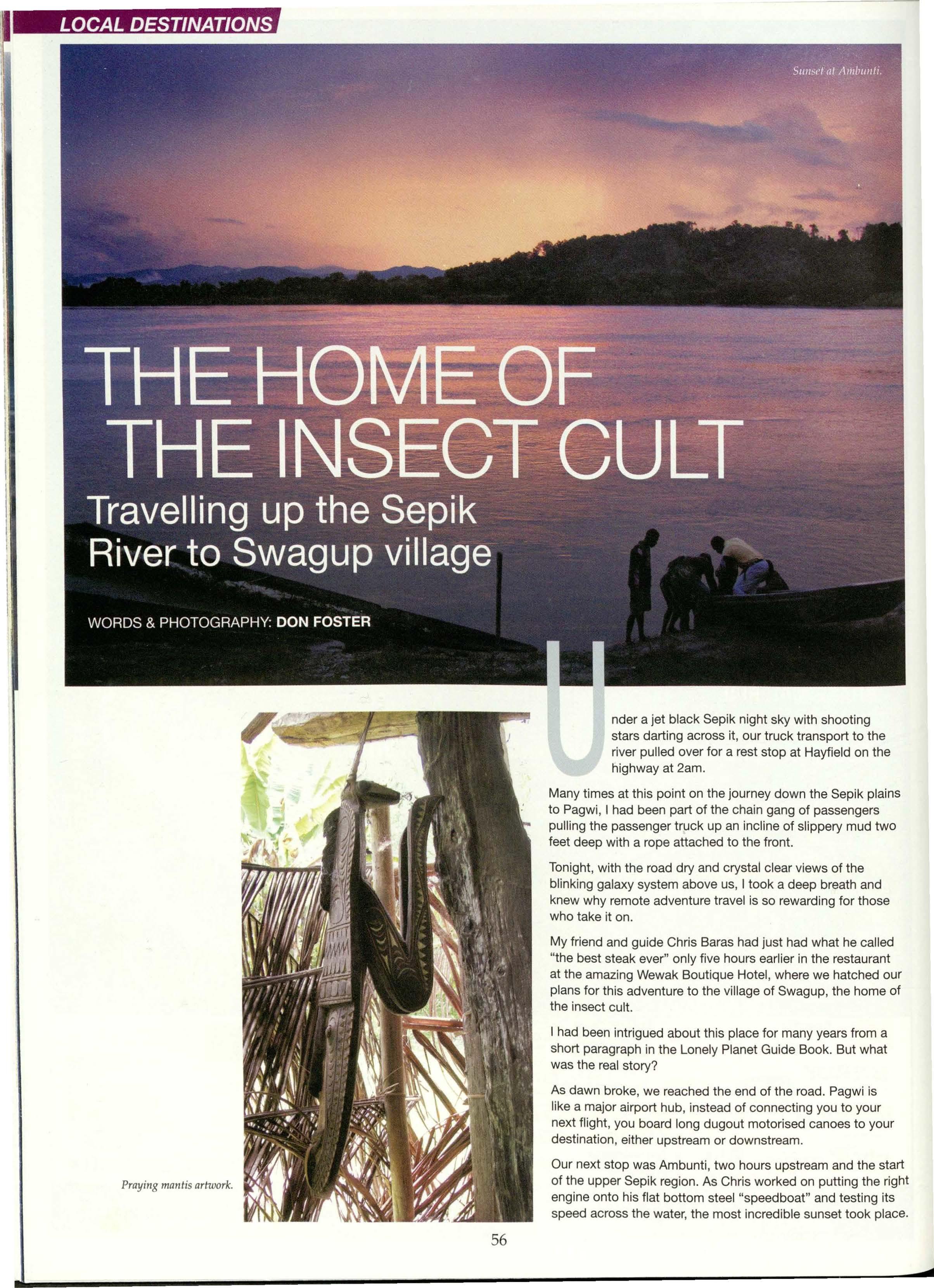
nder a jet black Sepik night sky with shooting stars darting across it, our truck transport to the river pulled over for a rest stop at Hayfield on the highway at 2am.
Many times at this point on the journey down the Sepik plains to Pagwi, I had been part of the chain gang of passengers pulling the passenger truck up an incline of slippery mud two feet deep with a rope attached to the front.
Tonight, with the road dry and crystal clear views of the blinking galaxy system above us, I took a deep breath and knew why remote adventure travel is so rewarding for those who take it on.
My friend and guide Chris Baras had just had what he called "the best steak ever" only five hours earlier in the restaurant at the amazing Wewak Boutique Hotel, where we hatched our plans for this adventure to the village of Swagup, the home of the insect cult.
I had been intrigued about this place for many years from a short paragraph in the Lonely Planet Guide Book. But what was the real story?
As dawn broke, we reached the end of the road. Pagwi is like a major airport hub, instead of connecting you to your next flight, you board long dugout motorised canoes to your destination, either upstream or downstream.
Our next stop was Ambunti, two hours upstream and the start of the upper Sepik region. As Chris worked on putting the right engine onto his flat bottom steel "speedboat" and testing its speed across the water, the most incredible sunset took place.
:>ting 1 to the don the ,pik plains mgers mud two the th and x those
1e called ,taurant tched our 1 home of from a Jt what JWiis ) your ; to your the start
19the right ·sting its ook place.
It was as if a fire had erupted in the late afternoon sky, changing colours every few seconds as the setting sun met with the storm clouds across the Hunstein Range to put on an elaborate farewell to the day.
One of the great sensations of living on the river is that the sounds of cars and trucks are totally replaced by the buzzing of outboard motors passing along the river day and night.
As we relaxed inside the Ambunti Lodge, I realised the mighty Sepik had its own sound track to the tune of the outboard engine. Next morning as Chris slid his speed boat onto the muddy bank outside the lodge, I showed him this new piece of technology called a GPS tracker.
This would show our speed, distance, exact location and the route we had travelled.
As the journey to Swagup continued, he was amazed that this thing the size of a mobile phone could supply so much accurate detail.
As an expert guide in his backyard, we took shortcuts through numerous lagoons and barats - sometimes only with three feet of water underneath the boat - and surprising the sun-baking crocodiles lazing on the river bank.
With a quick left turn after 67 kilometres of river travel, we pulled into Swagup village exactly two hours after departing Ambunti.
The first thing that took my eye was the sign that proclaimed Swagup was part of the Sepik wetlands conservation plan and that the
population of this unique village was 256!
The current site of Swagup was established in the early 1980s, when leaders moved the entire village from further inland.
Like most Sepik villages, the housing is set high on stilts but with distinctive steps notched into a tree trunk that leads you to the porch area. I
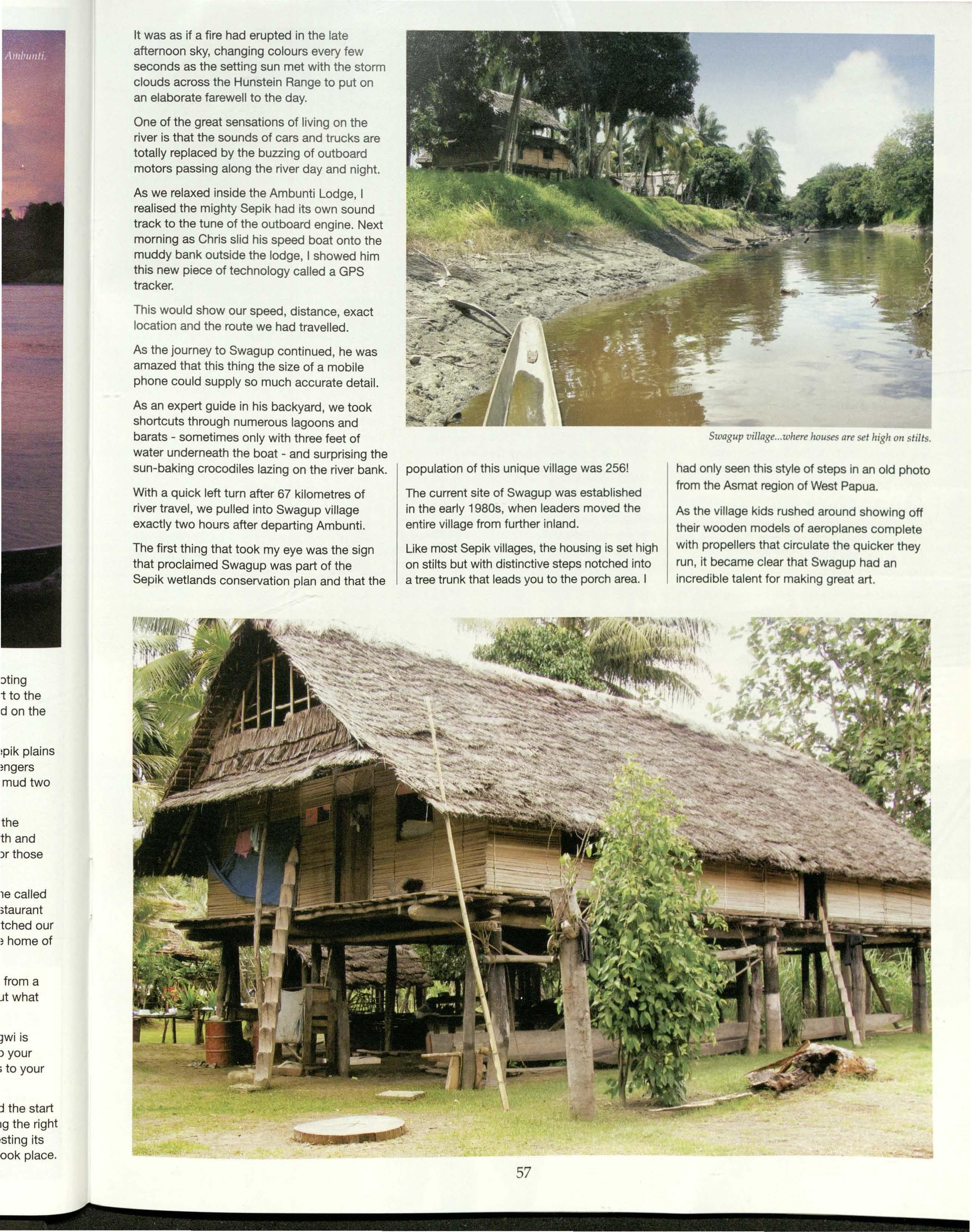
had only seen this style of steps in an old photo from the Asmat region of West Papua.
As the village kids rushed around showing off their wooden models of aeroplanes complete with propellers that circulate the quicker they run, it became clear that Swagup had an incredible talent for making great art.
Swagup'sHaus Tambaran.
The tag of the "insect cult" spreads itself when you start to notice that images of the praying mantis, dragonfly and sago grub are incorporated into most of the wooden artefacts and day-to-day items like seats, canoe prows and paddles.
As we wander back to the Haus Tambaran, the women are hard at work on the river bank producing "sak sak"(sago) from the palms that grow in abundance in the coastal regions of Papua New Guinea.
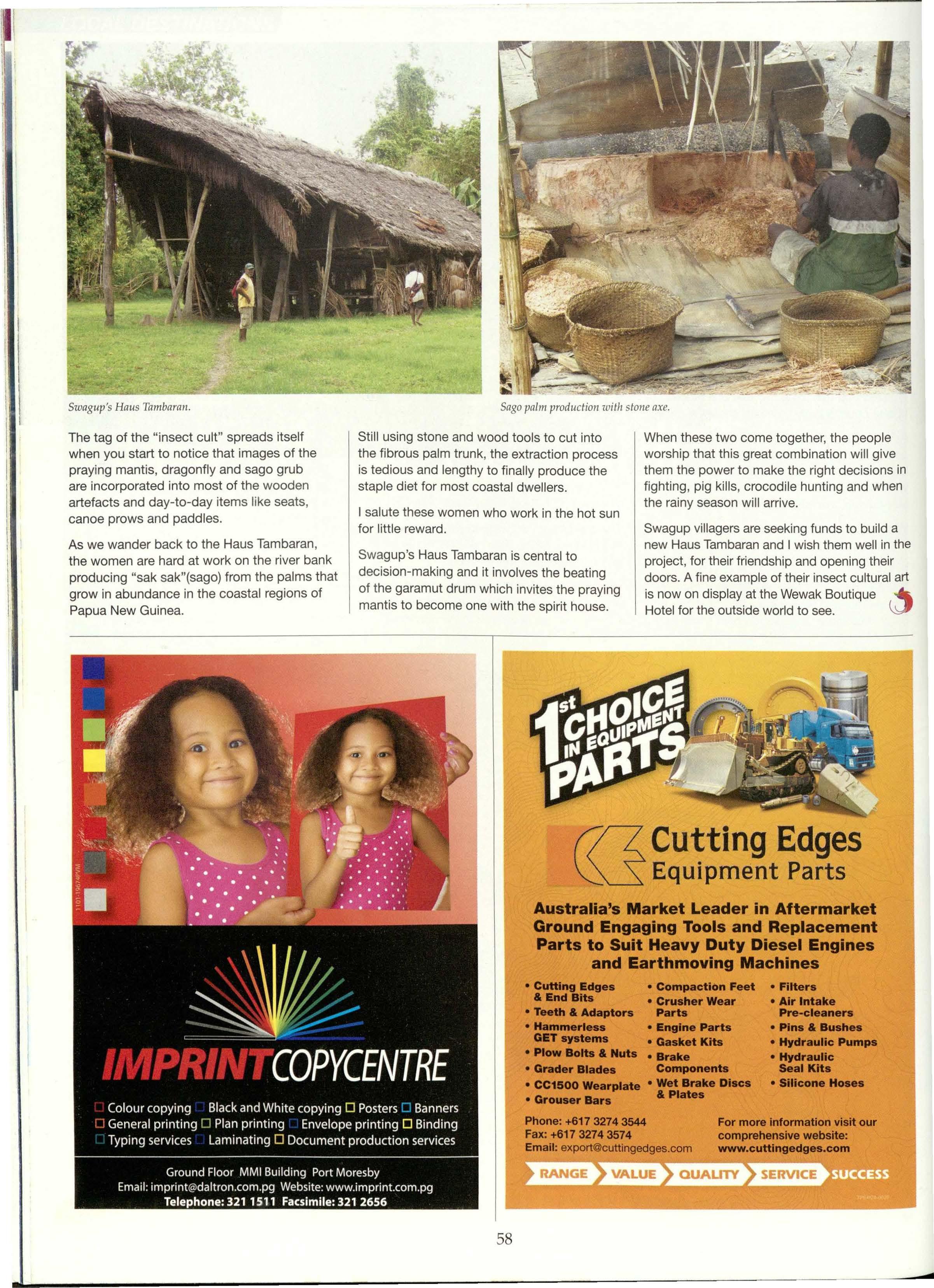
Sagopalmproductionwith stoneaxe.
Still using stone and wood tools to cut into the fibrous palm trunk, the extraction process is tedious and lengthy to finally produce the staple diet for most coastal dwellers.
I salute these women who work in the hot sun for little reward.
Swagup's Haus Tambaran is central to decision-making and it involves the beating of the garamut drum which invites the praying mantis to become one with the spirit house.
When these two come together, the people worship that this great combination will give them the power to make the right decisions in fighting, pig kills, crocodile hunting and when the rainy season will arrive.
Swagup villagers are seeking funds to build a new Haus Tambaran and I wish them well in the project, for their friendship and opening their doors. A fine example of their insect cultural art is now on display at the Wewak Boutique Hotel for the outside world to see.


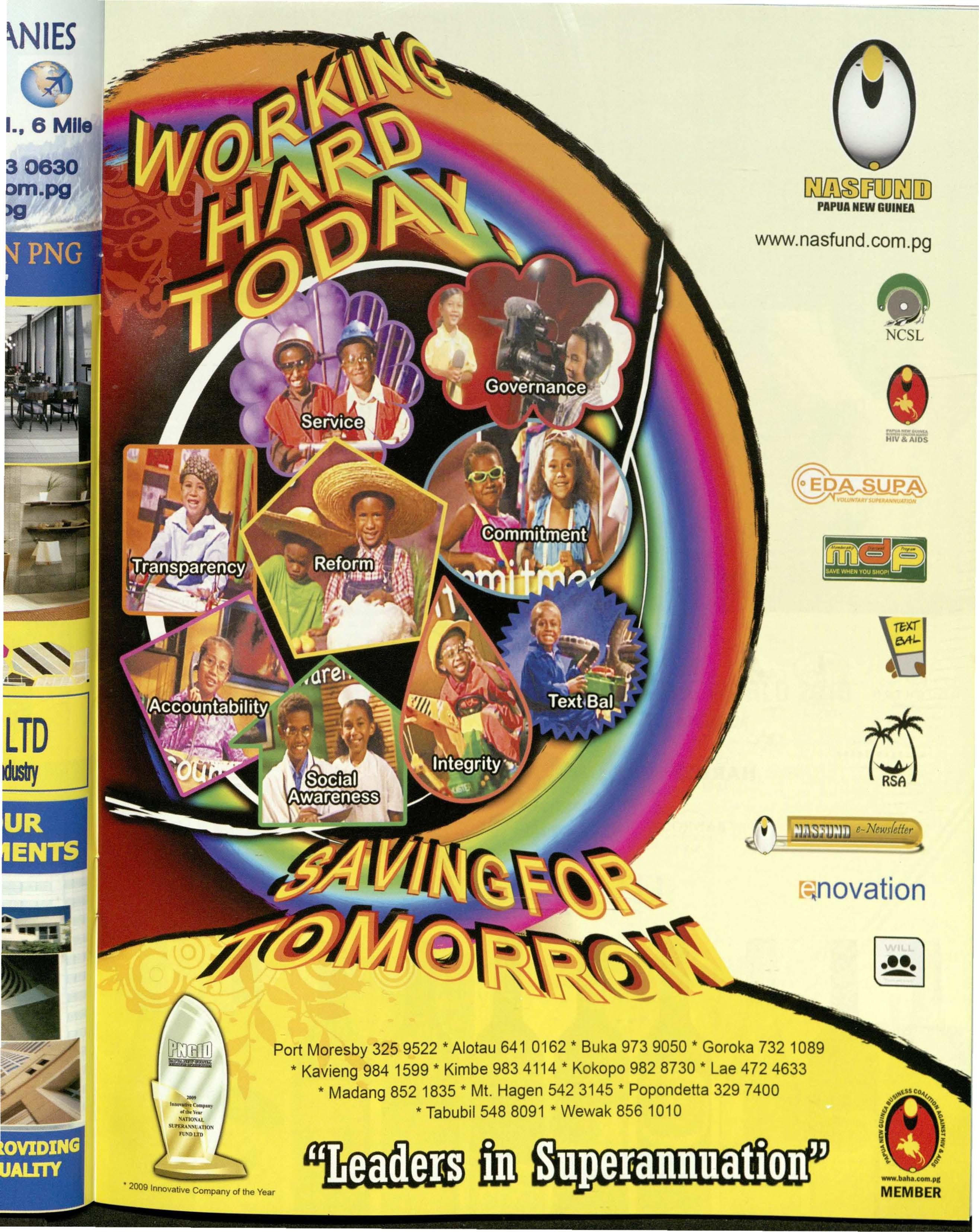

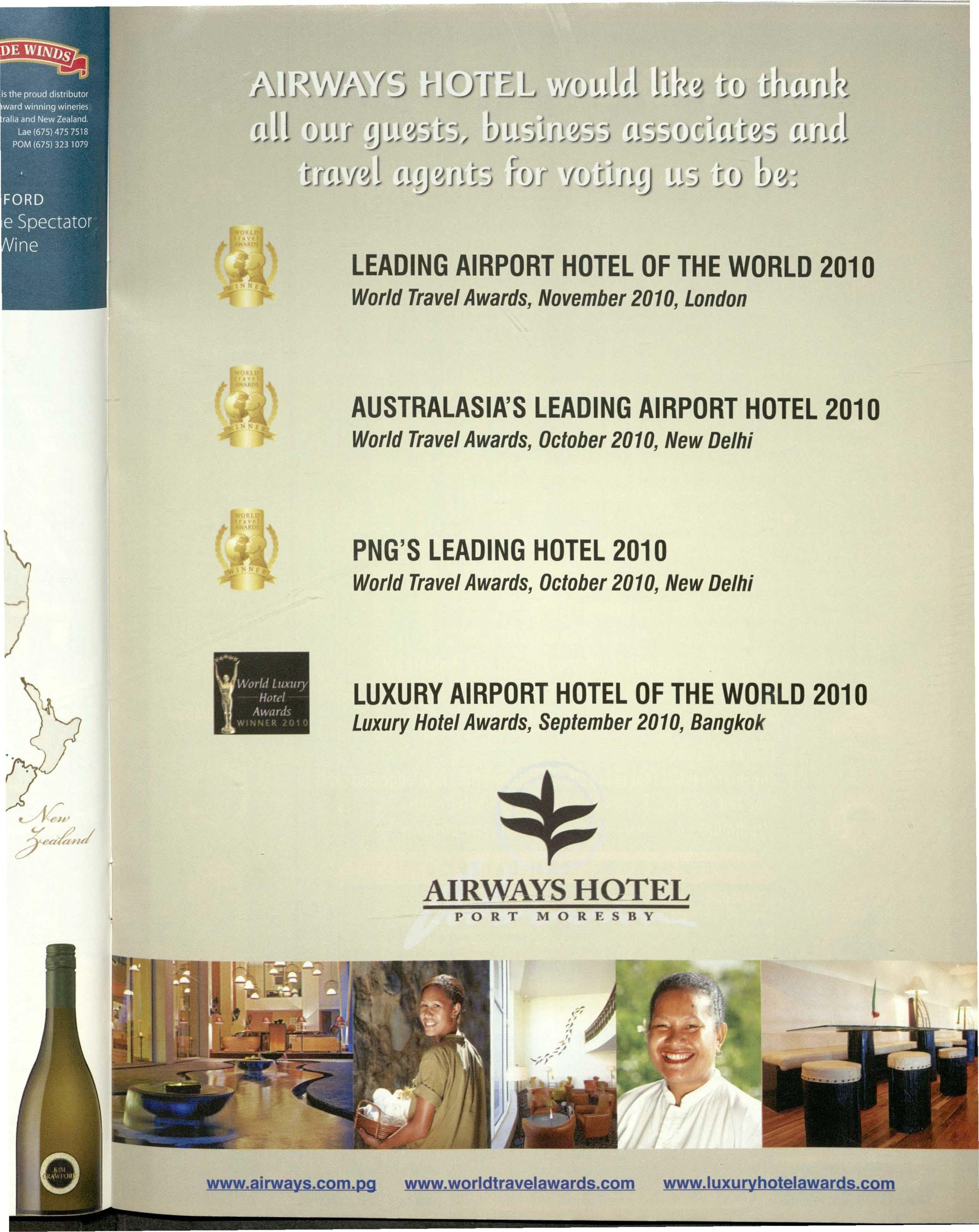
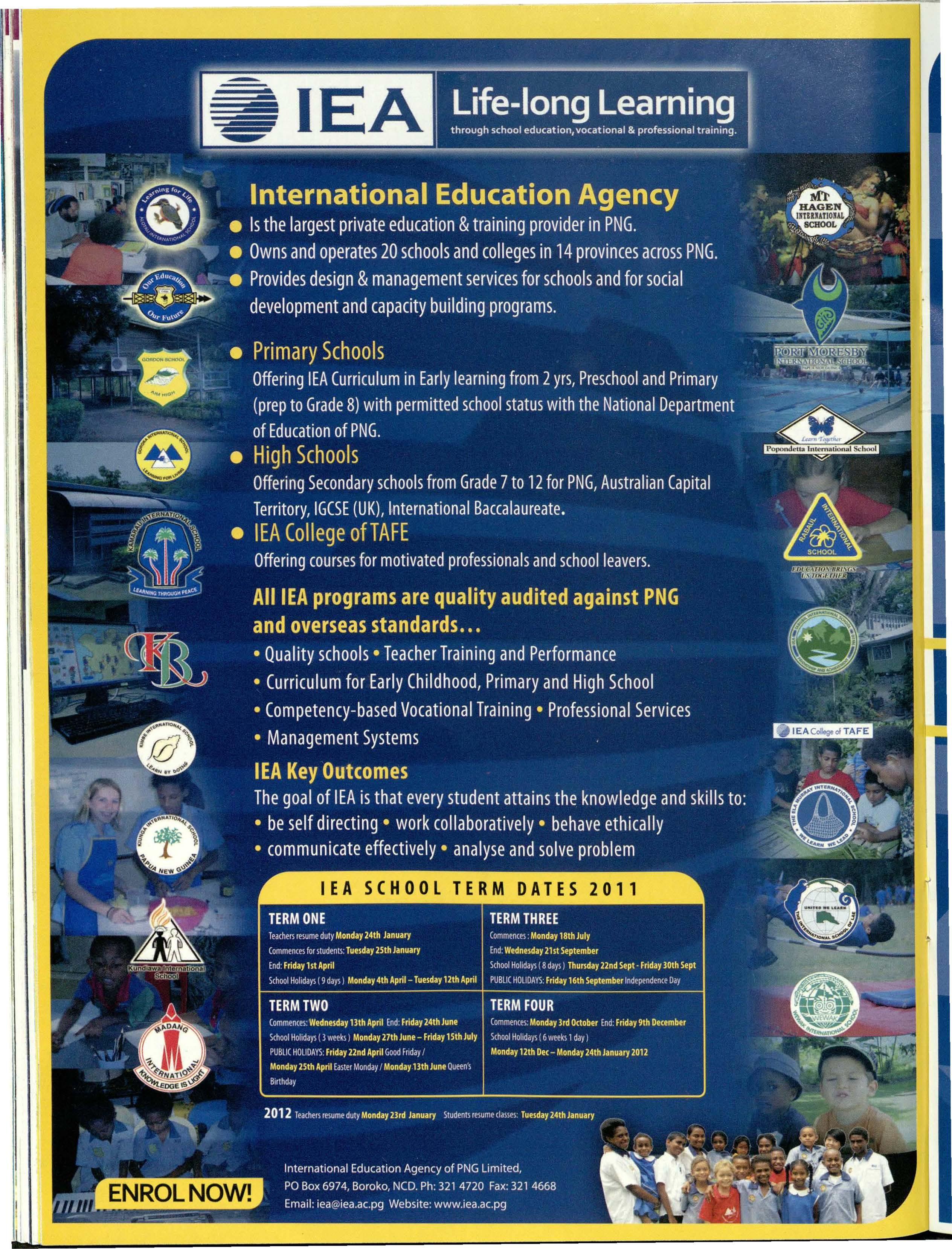
BusinessFinance & Accounting
Sports& Recreation
Hospitality& CommercialCookery
Children'sServices
Information& ComputerTechnology
LibraryInformationServices
Training& Assessment
FrontlineManagement
HRManagement
Language & Literacy
HIV& AIDSTraining(NHATU)
ForallProfessionalCoursescontact Phone:3214720ext244or206

EnquireatyourlocalIEACollegeofTAFEofficeand askforcourseinformationandregistrationforms. ElaBeach ph 3213022
CoronationCollege,Lae ph 4721011
Mt Hagen ph 5421964
Kimbe ph 9835078
Email:enquiry@tafe.iea.ac.pg

Lookingdown at Rabaul throughthe early morninghaze from the vantage point of the VolcanoObservatory,the town looksquiet and serene.
As you scan from left to right acrossthe near-perfect horseshoeof BlancheBay and the still,deep waters of SimpsonHarbour,ringed by coconut palms and frangipanis,only the smoking cone of Mt Tavurvurhintsat its more volatileand turbulent history.
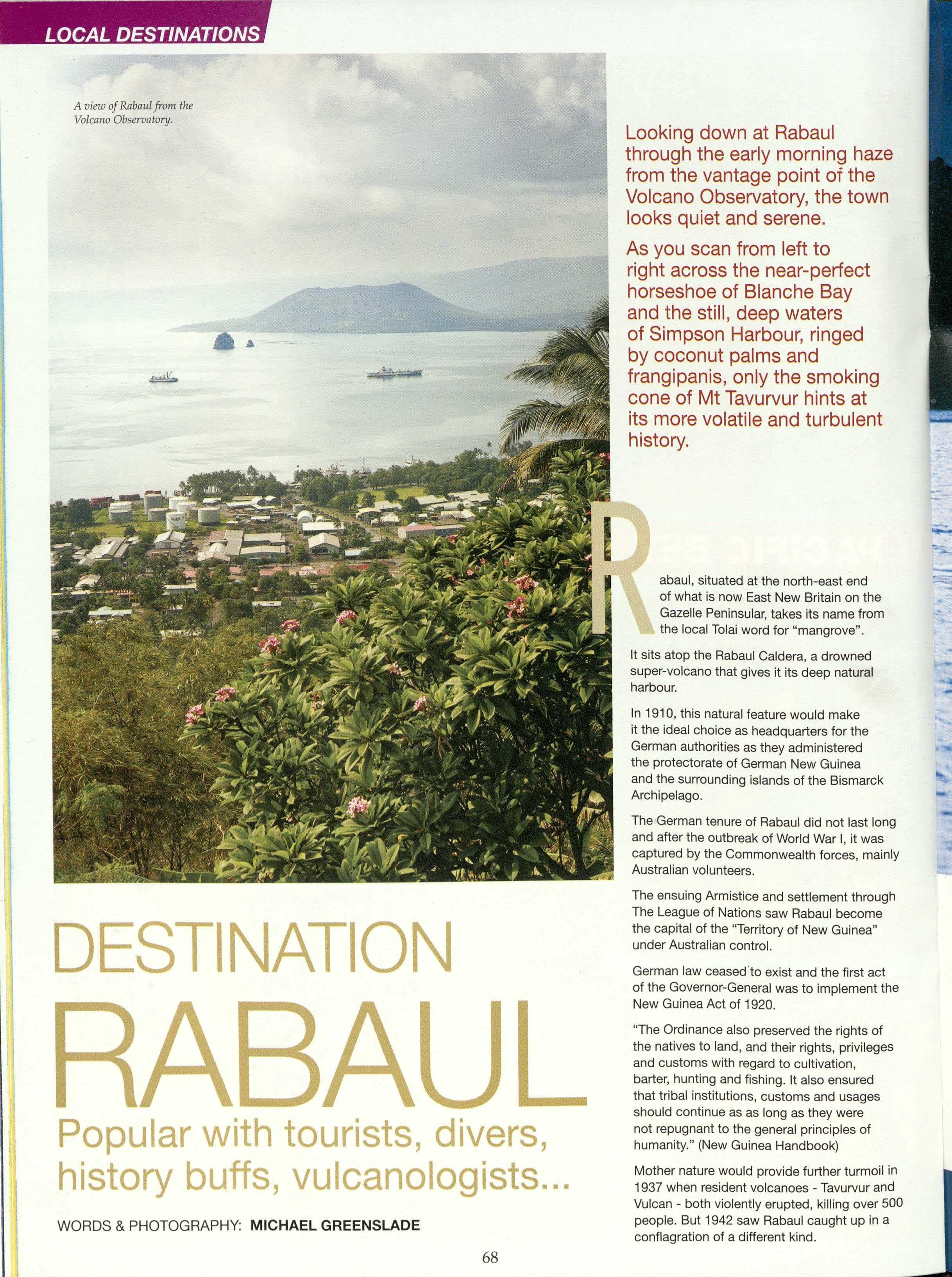
abaul, situated at the north-east end of what is now East New Britain on the Gazelle Peninsular, takes its name from the local Tolai word for "mangrove".
It sits atop the Rabaul Caldera, a drowned super-volcano that gives it its deep natural harbour.
In 1910, this natural feature would make it the ideal choice as headquarters for the German authorities as they administered the protectorate of German New Guinea and the surrounding islands of the Bismarck Archipelago.
The German tenure of Rabaul did not last long and after the outbreak of World War I, it was captured by the Commonwealth forces, mainly Australian volunteers.
The ensuing Armistice and settlement through The League of Nations saw Rabaul become the capital of the "Territory of New Guinea" under Australian control.
German law ceased'to exist and the first act of the Governor-General was to implement the New Guinea Act of 1920.
"The Ordinance also preserved the rights of the natives to land, and their rights, privileges and customs with regard to cultivation, barter, hunting and fishing. It also ensured that tribal institutions, customs and usages should continue as as long as they were not repugnant to the general principles of humanity." (New Guinea Handbook)
Mother nature would provide further turmoil in 1937 when resident volcanoes - Tavurvur and Vulcan - both violently erupted, killing over 500 people. But 1942 saw Rabaul caught up in a conflagration of a different kind.

Our strong team of specialists at QBE Papua New Guinea have been providing tailored insurance solutions based on unmatched local knowledge and regional expertise.
We understand the environment in which you operate and the specific risks you face. We are backed by the QBE regional network and global financial strength. Quick thinking, fast acting. That is why our skills can help you or your business get back to normal in the shortest possible time. For customised insurance solutions contact your insurance adviser or visit our website at www.qbepacific.com
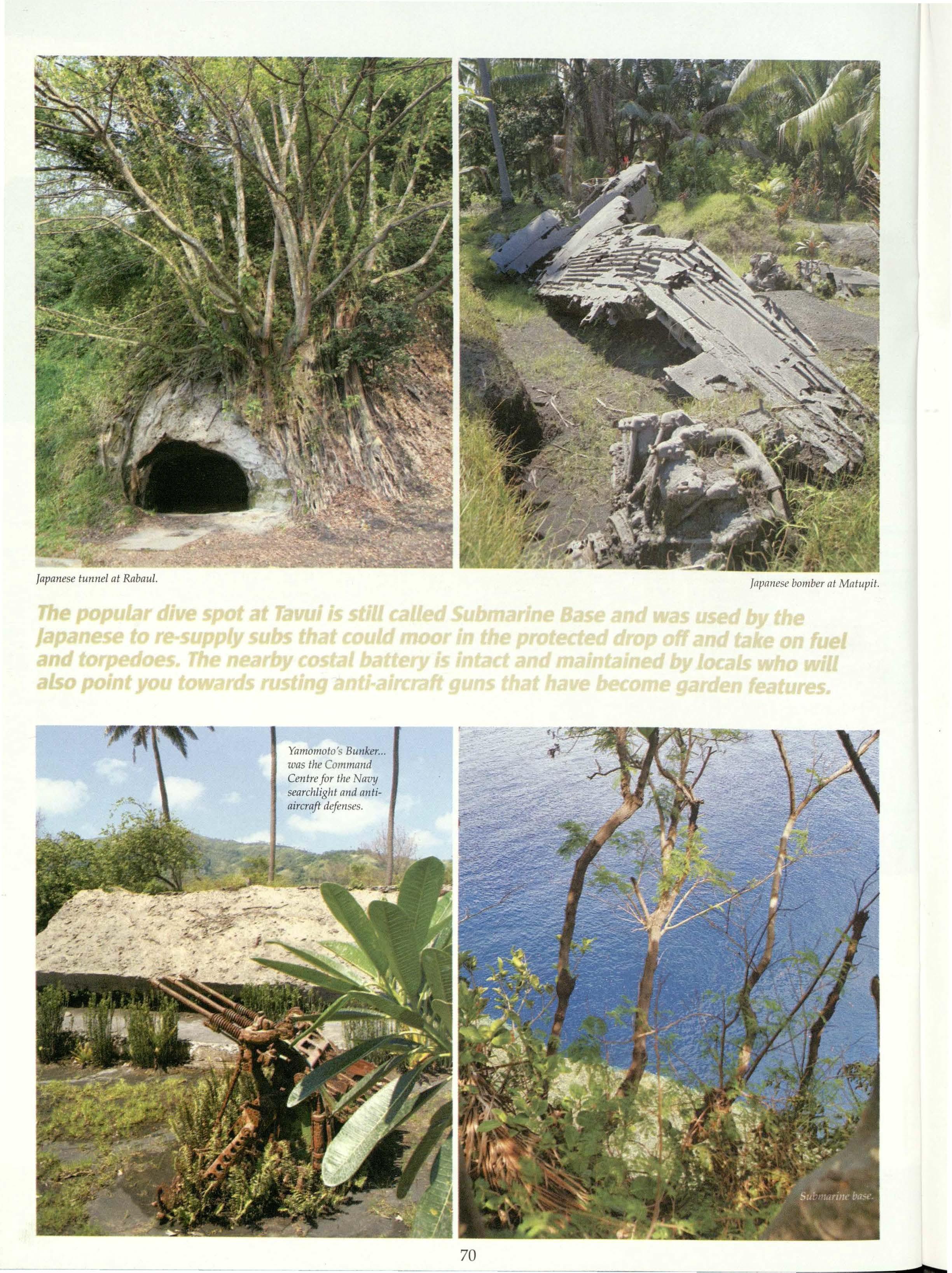
Yamomoto'sBunker was the Command Centrefor the Nam; searchlightand antiaircraftdefenses.
The attack on Pearl Harbour by Imperial Japanese Forces saw Japan enter the second World War and their forces swept rapidly down through the South Pacific.
January 4, 1942 marked the beginning of the Battle of Rabaul. The town was heavily bombed and many local casualties were caused when the Rapindik Native Hospital was hit.
The 1,400 strong Australian garrison was soon overpowered by an invasion force of some 20,000 crack Japanese troops.
Rabaul became a Japanese stronghold in the South Pacific. According to the US Strategic Bombing Survey, it was protected by 367 anti-aircraft guns, 43 Coastal guns and 20 searchlights, and many relics from this era are in evidence today.
Yamomoto's Bunker (also known as The Admiral's Bunker) was the command centre for the navy's searchlight and anti-aircraft defenses.
Its white plastered interior walls still show a contemporary map and some examples of Japanese graffiti. Outside, there is a wellpreserved 25mm triple anti-aircraft gun.
The popular dive spot at Tavui is still called Submarine Base and was used by the Japanese to re-supply subs that could moor in the protected dropoff and take on fuel and torpedoes.
The nearby costal battery is intact and maintained by the locals, who will also direct

you towards rusting anti-aircraft guns that have become garden features.
Rabaul more than tripled in size under Japanese occupation; there were five airstrips and many seaplane bases, upto 200,000 troops were based there and many of the region's major military actions such as the Battle of the Coral Sea, the Kokoda Track and Milne Bay were launched and supplied from
there. As a consequence, it became a target for heavy allied bombing, destroying many aircraft and sinking many ships in the harbour.
These sunken ships now provide some excellent wreck diving. The continued aerial assault literally drove the Japanese underground.
Using forced labour from the captured
Rabau/'slandscape.
garrison and the local populace, the Imperial Army dug a network of tunnels through the hard pumice rock of the surrounding hills.
Over 500 kilometres of these tunnels provided protection from the Allied onslaught and housed everything from hospitals to ammunition dumps and invasion barges.
Some well-preserved examples of the barges

can be seen in the tunnels at Karavia and on Matupit Island, one can find the wrecks of downed Japanese bombers.
The end of the war saw East New Britain become part of the newly formed Papua New Guinea under effective Australian control until independence in 1975.
Rabaul flourished as the provincial capital,
with Simpson Harbour being the main export route for cash crops of copra and cocoa grown in the local hills and surrounding islands.
On 19th September 1994, the peace of the capital was shattered once again by the eruption of both Mt Tavurvur and Vulcan.
Warning of the eruption meant there were
Tavurvurrer11ainsone of Papua New Guinea's most active volcanoes,most recently eruptingspectacularlyin October2006, shootingcolumn of ash 18 kilometresinto the air. Luckily,this time a favourable wind took the ash out to sea.
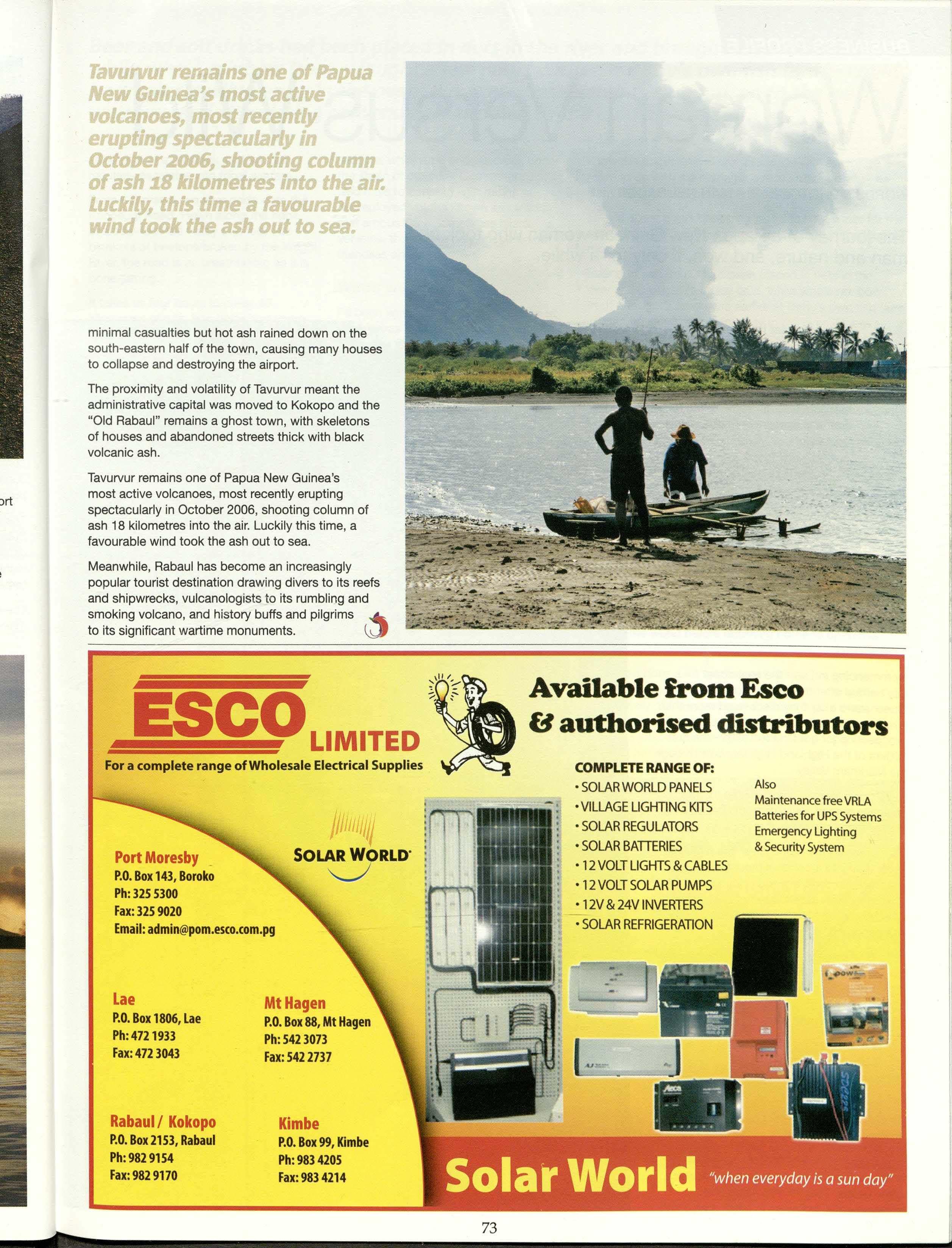
minimal casualties but hot ash rained down on the south-eastern half of the town, causing many houses to collapse and destroying the airport.
The proximity and volatility of Tavurvur meant the administrative capital was moved to Kokopo and the "Old Rabaul" remains a ghost town, with skeletons of houses and abandoned streets thick with black volcanic ash.
Tavurvur remains one of Papua New Guinea's most active volcanoes, most recently erupting spectacularly in October 2006, shooting column of ash 18 kilometres into the air. Luckily this time, a favourable wind took the ash out to sea.
Meanwhile, Rabaul has become an increasingly popular tourist destination drawing divers to its reefs and shipwrecks, vulcanologists to its rumbling and smoking volcano, and history buffs and pilgrims '6i. to its significant wartime monuments. U
For a complete range of Wholesale Electrical Supplies
PortMoresby
P.O.Box143,Boroko
Ph:3255300
Fax:3259020
Email:admin@pom.esco.com.pg
Lae
P.O.Box1806,Lae
Ph:4721933
Fax:4723043
Rabaul / Kokopo
P.O.Box2153,Rabaul
Ph:9829154
Fax:9829170
Mt Hagen
P.O.Box88,Mt Hagen
Ph:5423073 Fax:5422737
Kimbe P.O.Box99,Kimbe
Ph:9834205 Fax:9834214
COMPLETERANGEOF:
• SOLARWORLD PANELS Also • VILLAGE LIGHTING KITS
• SOLAR REGULATORS
• SOLAR BATTERIES
• 12 VOLT LIGHTS& CABLES
• 12 VOLT SOLAR PUMPS
• 12V & 24V INVERTERS
• SOLAR REFRIGERATION
Maintenancefree VRLA Batteriesfor UPSSystems EmergencyLighting & SecuritySystem

The journey of a Papua New Guinean woman who took on man and nature, and won, if only for a while.
ike many great travel stories, this one begins with a road. Not just any road but the Highlands Highway - a 700-km long patchwork of potholes, washouts and perilous hairpin turns that cuts through some of the most dramatic scenery in Papua New Guinea.
Our destination was Betty's Lodge, a small B & Bat the foothills of Mount Wilhelm, the country's highest peak. We weren't going there to scale the mountain but to meet the owner, Betty Higgins, recipient of PNG's Westpac Women in Business Award in 2009.
A former Air Niugini flight attendant who tore herself from the grip of poverty, she now runs a successful business in one of the most challenging environments in the world.
Commencing in Lae - the east coast city named after the Leahy Brothers of Queensland after they discovered more than a million people living in the Highlands while prospecting for gold in the 1930s - the first 160km of the Highland Highway cuts through the Markham Valley.
Hawks dive for roadkill as vehicles thunder down the tarmac, many of them fated to join the twisted metal carcasses that pockmark the road.
After crossing the Ramu River, the highway veers east into a colossal mountain range shadowed in dark, ominous clouds. Rhythmically, it ascends switchback after switchback the Markham and Ramu, melting into panoramic views.
At 1,500 metres above sea level, the highway crosses the Kassam Pass and enters the Highlands. The climate is instantly cooler as the jungle gives way to softly rolling hills carpeted in pine and wildflowers.
It climbs to 2,478 metres at the Daulo Pass before descending to Kundiawa, provincial capital of Simbu Province.
Despite its rugged and unforgiving terrain, Simbu is the second most densely populated province in the country.
Simbuans are ancient gardeners renown for the cultivation of yams, taro and Arabica coffee beans. They're also fierce and temperamental, believers in black magic and
Beerand soft drmkshad be n placedin nets in the river and broughtto us ice cold, while wholerainbowtrout - caughta few hoursearlier at Betty'sown fish farm - could be smelt cracklinga ay in the o n. But e en thesepaled ,n comparisonto the warm welcom and st,mulatng con ersat,onaffordedby the landladyherself.
adherents of a payback system that regularly escalates into tribal warfare.
From Kundiawa, we veer north onto the Kengsugl Road. Hewn along the ridge of a saw-toothed valley that falls into blankets of treetops broken by the Waghi River, the road is as breathtaking as it is bone-jarring.
It takes us four hours to cover 40 kilometres of ruts, bog holes and sharp slippery rocks that characterise this diabolical stretch of road.
Landslides have washed away huge

sections while rope bridges creak under the strain of our cars. Commuters also have to contend with gangs of unemployed youths known as raskols that ambush and sometimes hijack vehicles, though we only encountered friendlies on the road.
I'd been warned the accommodation at Betty's was less than luxurious: bunk beds with only one share bathroom.
But those who tend to stay in B & Bs
know the comfort level has less to do with amenities and more to do with the manager's care and creativity - as Betty and her staff proved in spades.
They'd spent hours chopping wood to heat water for the shower and to fuel the Mongolian fireplace in the lounge room.
Beer and soft drinks had been placed in nets in the river and brought to us icy cold, while whole rainbow trout - caught a few hours earlier at Betty's own fish farm - could be smelt crackling away in the oven. But even these paled in comparison to the warm welcome and stimulating conversation afforded by the landlady herself.
Standing just over five-feet high, Betty carries the aura of a giant among the heavyset Highlanders among whom she resides. At a recent village meeting, she lambasted the local member for failing to improve the Kengsugl Road ("Don't tell me to sit down! You have been in power for 15 years and not done a thing! You sit down!); and when a local bigman threatened to shoot her after she refused to be extorted, she promised her death would be avenged upon him and his business partners 100-fold.
"It's wonderful to meet someone as intelligent and innovative as Betty," said Colin Prince, an architect from Sydney who came to the Highlands to hunt rare species of butterflies.
"She's led a remarkable life - being kicked out of home by her father, putting herself through school and working around the world before returning home to open this place.
"She also does a lot for the community," he says. "Two days ago, we went to a ceremony marking the anniversary of the opening of the local high school, which she has been very supportive of. She also provides jobs and training for dozens of people here. Without her, they'd have nothing."
thEarly the next morning, Betty gives me a tour of her property. She came here in 2005 with her husband Ken, an Australian miner she met 20 years earlier while working for Air Niugini.
They built the guesthouse and a state-ofthe-art fish farm, using eggs imported from Tasmania. "I learned about fish farming from books," Betty says. "It has been a

trial and error. I am not an academic. I have no scientific knowledge."
And while finances were tight, life was good for a while. But in 2008, Ken passed away.
"It has been very difficult without him " she laments. "After he died, the villag~rs accused me of witchcraft and one night they came and destroyed a lot of my equipment. I thought about leaving but I
couldn't bear to leave the place Ken had built with his bare hands."
But the worse was still to come, when, in February last year, a landslide washed away the fish farm. "Watching it happen was very traumatic," Betty says. "It nearly killed me; I lost four year's of work and nearly 7,000 fish. I went away for four months, but now we are rebuilding."
Betty also created an organic hobby farm, where she grows specialty crops like strawberries, passionfruit-bananas and herbs for her guests. But she buys all her vegetables and meat from neighbours, thus providing their only source of income.
She's also set up a small hydro plant that generates 7,000kW of power and grows high-altitude orchids that have attracted collectors from as far as Holland and Japan.
But with a torrential rainy season that locks her in and visitors out for six months of every year, Betty's Lodge is struggling to survive, attracting no more than two visitors per week.
"My main income is from the trout but the government wants to focus on tourism, so maybe things will improve," she says. "There are huge opportunities here for hiking, biking, fly-fishing, birdwatching and all those kinds of things. It's a gold mine.
"I'm 52-years old now. In another 1O years I might be too old and I'll go and live in Western Australia with my daughter, so she can look after me. But for now, I am here at the foot of Mount Wilhelm. My husband was Australian and he loved this country, so _Iho~e all your friends will come to ._ v1s1tus 1nPapua New Guinea." V
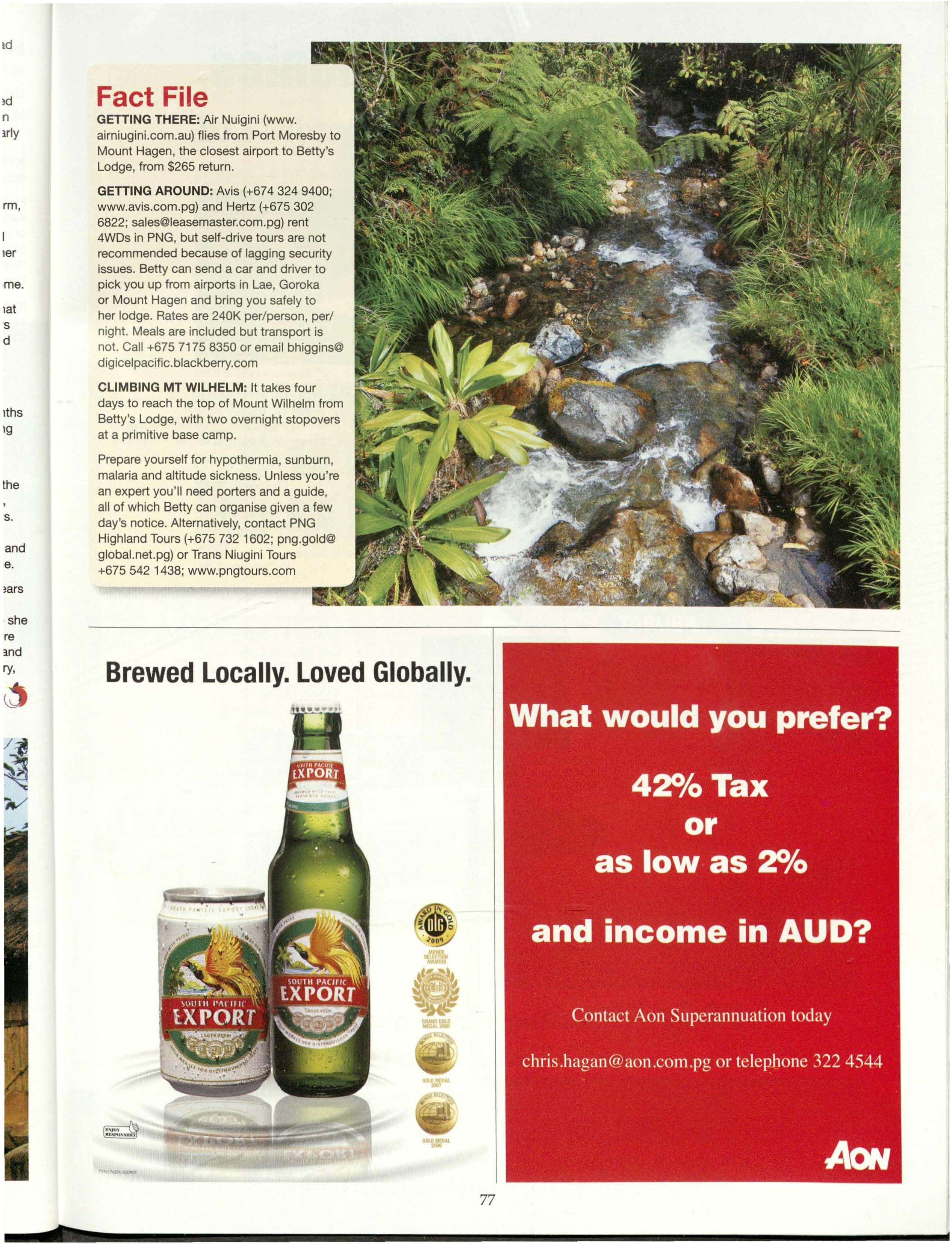
GETTING THERE: Air Nuigini (www. airniugini.com.au) flies from Port Moresby to Mount Hagen, the closest airport to Betty's Lodge, from $265 return.
GETTING AROUND: Avis (+674 324 9400; www.avis.com.pg) and Hertz (+675 302 6822; sales@leasemaster.com.pg) rent 4WDs in PNG, but self-drive tours are not recommended because of lagging security issues. Betty can send a car and driver to pick you up from airports in Lae, Goroka or Mount Hagen and bring you safely to her lodge. Rates are 240K per/person, per/ night. Meals are included but transport is not. Call +675 7175 8350 or email bhiggins@ digicelpacific.blackberry.com
CLIMBING MT WILHELM: It takes four days to reach the top of Mount Wilhelm from Betty's Lodge, with two overnight stopovers at a primitive base camp.
Prepare yourself for hypothermia, sunburn, malaria and altitude sickness. Unless you're an expert you'll need porters and a guide, all of which Betty can organise given a few day's notice. Alternatively, contact PNG Highland Tours (+675 732 1602; png.gold@ global.net.pg) or Trans Niugini Tours +675 542 1438; www.pngtours.com
Services:
• Construction Projects and Services • Industrial & Commercial Works • Residential& Civil Works
• Architectural
• Structural Steel
• Electrical & Air Conditioning
• Glass & Aluminium
• Joinery Manufacturers
• Plumbing & Gas
• Concrete Plant (80m3 per Hour)
Equipment Hire:
• Cranes from 20 to I !Otons
• Dozers
• Excavators
• Trucks
• Concrete Mixers
• Rollers
• Backhoes
• Boom-Lifts
• Generators
• Compressors
And many more items
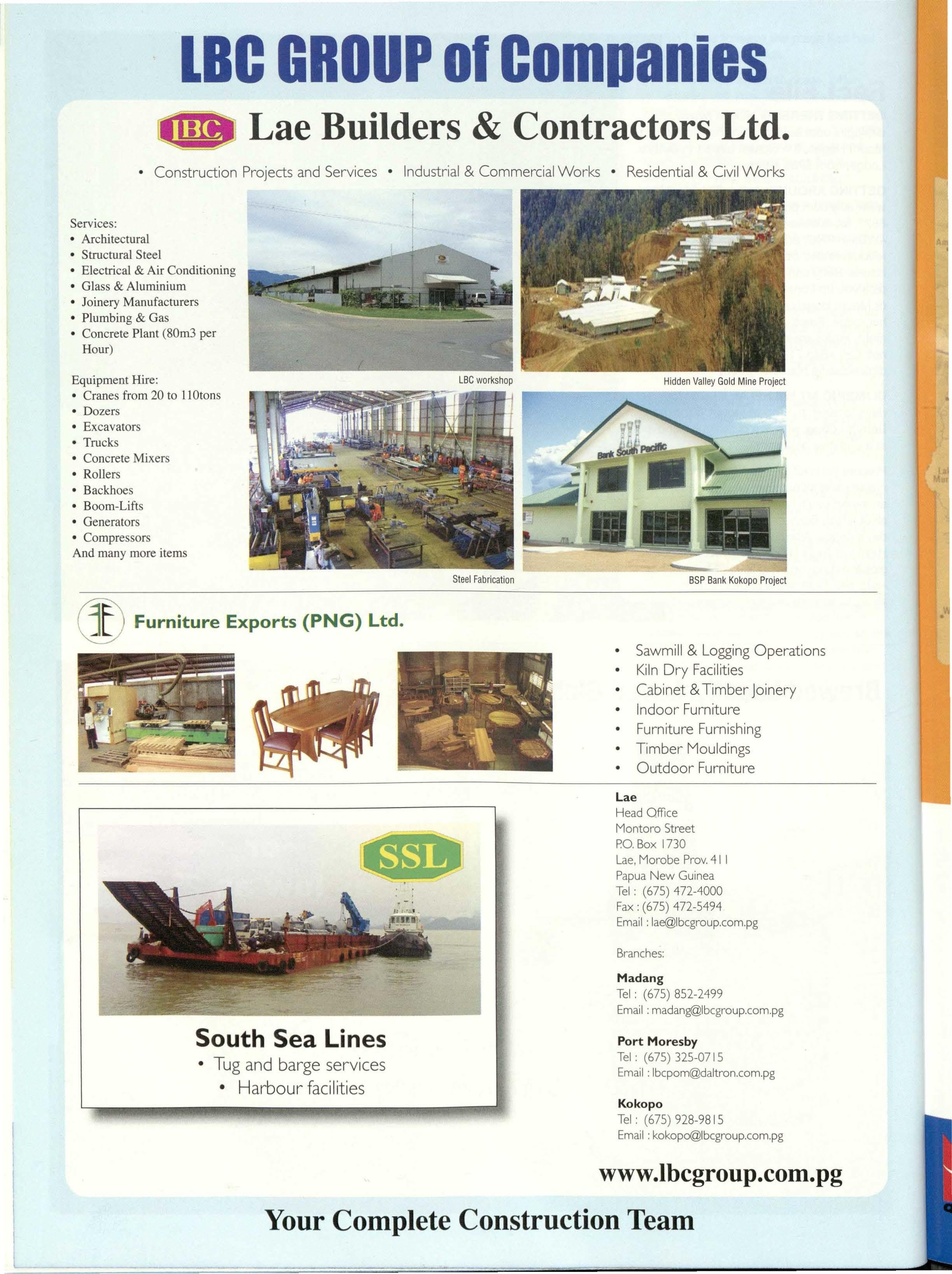
• Tug and barge services
• Harbour facilities
• Sawmill & Logging Operations
• Kiln Dry Facilities
• Cabinet & Timber joinery
• Indoor Furniture
• Furniture Furnishing
• Timber Mouldings
• Outdoor Furniture
Lae
Head Office
Montoro Street PO. Box 1730
Lae, Morobe Prov. 41 I
Papua New Guinea
Tel: (675) 472-4000
Fax: (675) 472-5494
Email : lae@lbcgroup.com.pg
Branches:
Madang
Tel: (675) 852-2499
Email : madang@lbcgroup.com.pg
Port Moresby
Tel : (675) 325-0715
Email : lbcpom@daltron.com.pg
Kokopo
Tel : (675) 928-9815
Email : kokopo@lbcgroup.com.pg

Bringing Budget International Standards to Papua New Guinea
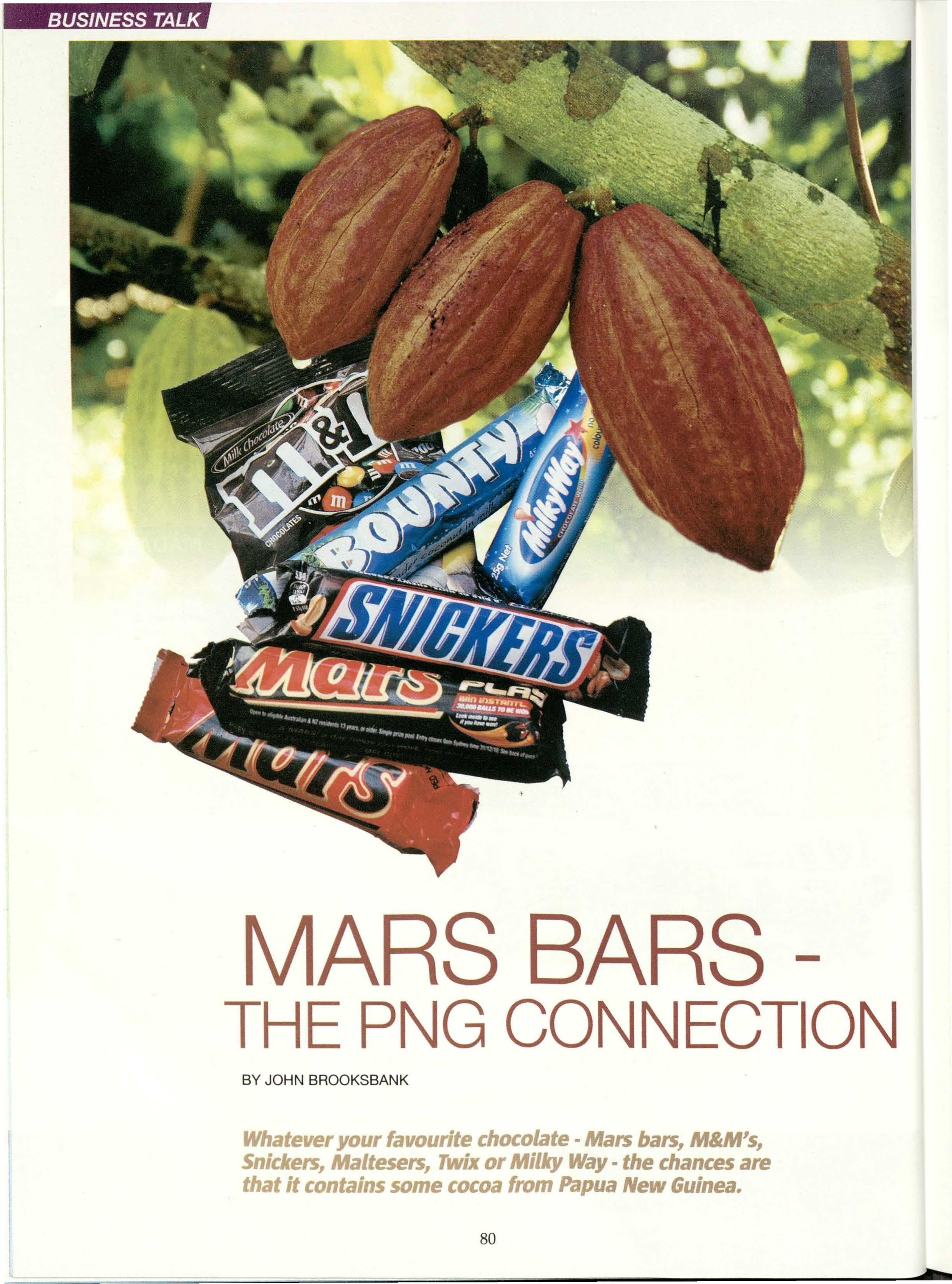
BY JOHN BROOKSBANK
Whateveryour favouritechocolate- Mars bars,M&M's, Snickers,Maltesers, Twixor Milky Way- the chancesare that it containssome cocoafrom PapuaNew Guinea.
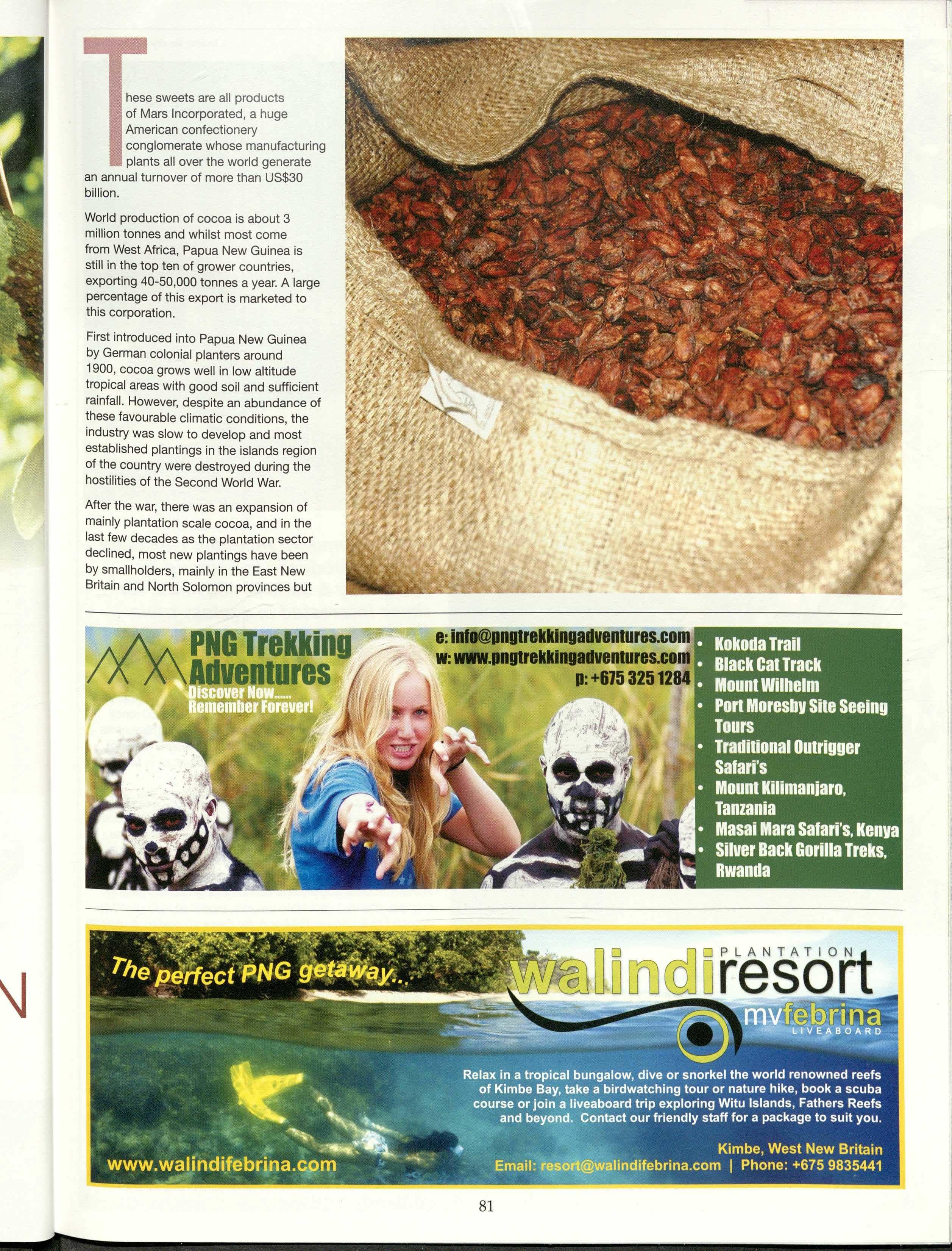
hese sweets are all products of Mars Incorporated, a huge American confectionery conglomerate whose manufacturing plants all over the world generate an annual turnover of more than US$30 billion.
World production of cocoa is about 3 million tonnes and whilst most come from West Africa, Papua New Guinea is still in the top ten of grower countries, exporting 40-50,000 tonnes a year. A large percentage of this export is marketed to this corporation.
First introduced into Papua New Guinea by German colonial planters around 1900, cocoa grows well in low altitude tropical areas with good soil and sufficient rainfall. However, despite an abundance of these favourable climatic conditions, the industry was slow to develop and most established plantings in the islands region of the country were destroyed during the hostilities of the Second World War.
After the war, there was an expansion of mainly plantation scale cocoa, and in the last few decades as the plantation sector declined, most new plantings have been by smallholders, mainly in the East New Britain and North Solomon provinces but
some elsewhere in the country. Cocoa beans are the seeds of an evergreen tree, Theobroma cacao, which originated in the rainforests of the Amazon and Orinoco river basins. It was first domesticated as a food crop by early civilisations in the northern part of South America, more than two thousand years ago.
Cocoa was known to the Maya, Olmec, Toltec and Aztec peoples, only ritually consumed by the more important members of these societies and used in certain religious

Thefirstmodernmouldedchocolate bar wasproducedin Englandby JosephFry& Sonsin l847 and, for thoseinterestedin uselesstri11iathe Snickersbar was 'invented'by FranklinMars in the UnitedStates.
ceremonies. The Mayan beverage was known as xocoatl and because of their value, the beans were used as a currency or medium of exchange. Scientifically speaking, Theobroma means 'food of the gods' whilst the word cacao is derived from its local place names - in Aztec cacahuatl or in Mayan, kakaw.
The Spanish colonisers of the Americas who discovered the plant being used by the peoples they subjugated, introduced cocoa and its derivative chocolate to Europe, where in the 1600s it soon became a popular drink in many countries.
In the following centuries, cocoa plantations were established in many tropical countries to service this demand. The first modern moulded chocolate bar was produced in England by Joseph Fry & Sons in 1847 and, for those interested in useless trivia - the Snickers bar was 'invented' by Franklin Mars in the United States.
In Papua New Guinea, cocoa production dropped in the 1990s due to civil unrest on Bougainville, volcanic eruptions and drought in the Gazelle Peninsula, rising production costs and the general decline of the plantation sector.
After recovering from these events, the main threat to the industry nowadays comes from a tiny bug that can hardly be seen by the naked eye - the cocoa pod borer.
This nasty and devious parasite mite bores into the cocoa pods while they are growing and there is no external evidence when they are infected. It is not until the pods are split to release the beans that the black growth inside is seen.
Infected pods are valueless since they contain no marketable

PacificMMIInsuranceis a nationalinsurancecompanyoperatingthroughoutPapuaNewGuineaandthe Pacificregion. Weprovidea rangeof personal,commercialandcorporateinsuranceproductsthroughselectedinsurancebrokers,businesspartners,anddirectto thepublic.
Ouruniquecombination of sizeandexpertiseallowsusto provideyouwithpeaceof mind,personalservice,secureinsuranceproducts, competitiveoptions,andlocalPapuaNewGuineanexpertise.
Wearecommittedto excellencein ourdailybusiness.Ourcontinuedgrowthandsuccessconfirmsour philosophyof a positiveand commerciallysensitiveapproachto yourneeds. If wecanassistyoufurther,pleasecontact:
Telephone:3214077 Level4, PacificMMIBuilding,POBox331PortMoresby,NCO,PapuaNewGuinea. Facsimile:3214837 Email:enquiries@pacificmmi.comWebsite:www.pacificmmi.com
seeds. Strangely, cocoa flowers and later pods grow directly on the trunk of the tree and in Papua New Guinea, there are two main varieties - in one, immature pods are green and ripen to a yellow colour; in the other, ripening turns pods from purple to red. Trees bear after 4-5 years and are fruitful for at least another ten years.
The cocoa fruit or pod has a rough thick, leathery rind and is filled with a sweet, sticky pulp enclosing 30 to 50 large pale coloured soft seeds, known as beans. They become violet or reddish brown during the drying process.
The ripe pods are harvested, cut open, the pulp and cocoa seeds removed and the rind discarded. The pulp and seeds, known as wet beans, are piled in heaps, placed in bins, or laid out on grates for several days to ferment. During this time, the seeds and pulp undergo "sweating", where the thick pulp liquefies as it ferments. The fermented pulp trickles away, leaving cocoa seeds behind to be collected. This is an essential stage in the processing of wet beans, which initially have a strong bitter taste. Fermentation is important for the flavour, aroma and quality of cocoa and chocolate products that are later manufactured.
However, from the point of view of cocoa growers in Papua New Guinea, it is the cash return that they receive that is of most interest and many village
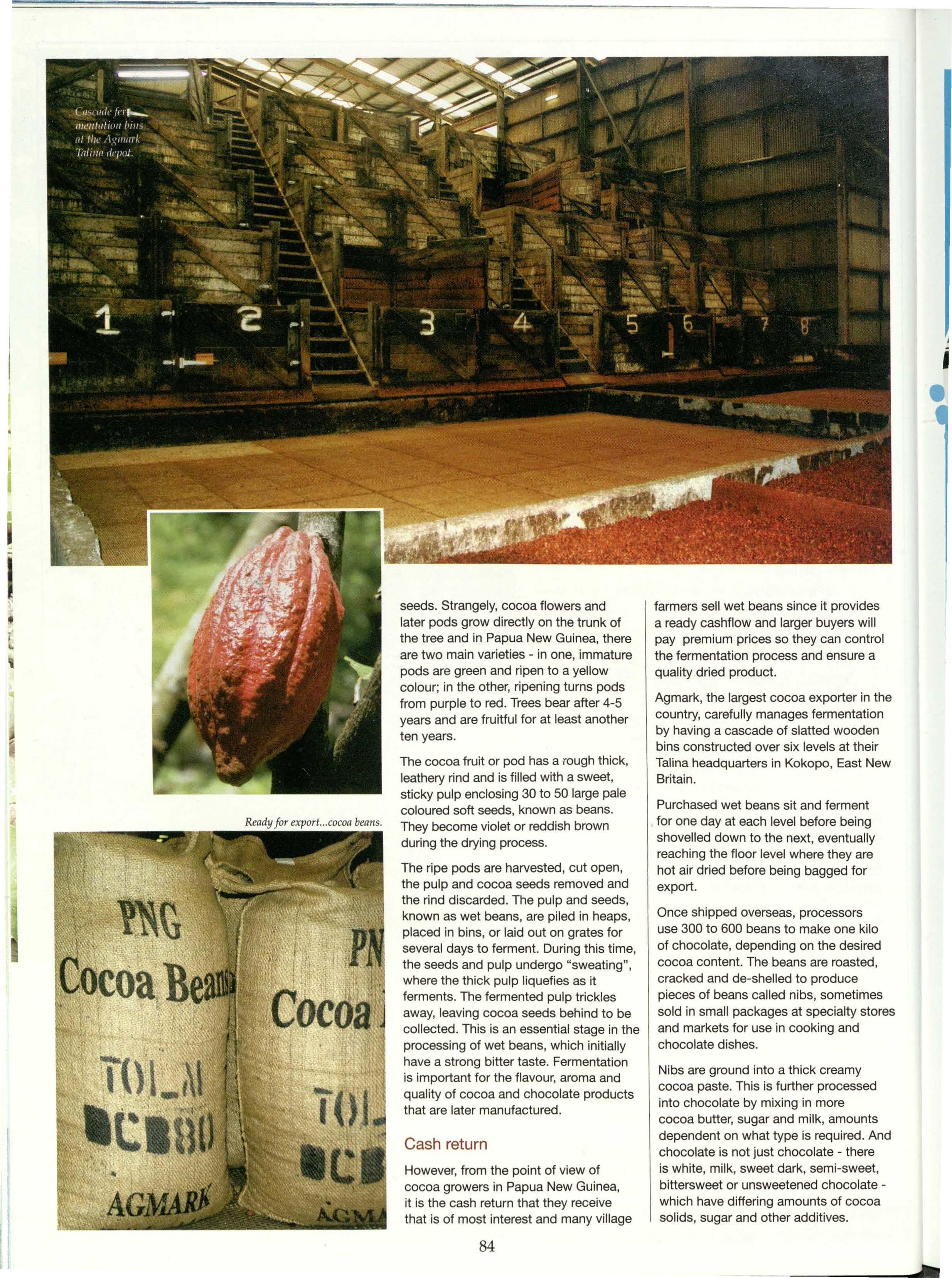
farmers sell wet beans since it provides a ready cashflow and larger buyers will pay premium prices so they can control the fermentation process and ensure a quality dried product.
Agmark, the largest cocoa exporter in the country, carefully manages fermentation by having a cascade of slatted wooden bins constructed over six levels at their Talina headquarters in Kokopo, East New Britain.
Purchased wet beans sit and ferment for one day at each level before being shovelled down to the next, eventually reaching the floor level where they are hot air dried before being bagged for export.
Once shipped overseas, processors use 300 to 600 beans to make one kilo of chocolate, depending on the desired cocoa content. The beans are roasted, cracked and de-shelled to produce pieces of beans called nibs, sometimes sold in small packages at specialty stores and markets for use in cooking and chocolate dishes.
Nibs are ground into a thick creamy cocoa paste. This is further processed into chocolate by mixing in more cocoa butter, sugar and milk, amounts dependent on what type is required. And chocolate is not just chocolate - there is white, milk, sweet dark, semi-sweet, bittersweet or unsweetened chocolatewhich have differing amounts of cocoa solids, sugar and other additives.

Chocolateand
cocoacontainhigh levels of polyphenolssimilarto thosefoundin red wine, knownas flavonoids,specifically epicatechinsand catechins,that have antioxidantproperties.
Alternatively, the cocoa paste can be pressed and separated into cocoa powder and cocoa butter, the latter used in chocolate bar manufacture, other confectionery, soaps and cosmetics.
Chocolate and cocoa contain high levels of polyphenols similar to those found in red wine, known as flavonoids, specifically epicatechins and catechins, that have antioxidant properties.
Prolonged intake of flavanolrich cocoa has been linked to cardiovascular health benefits though this usually refers to raw cocoa and to a lesser extent, dark chocolate, since flavonoids degrade during heating and production processes. The addition of whole milk to milk chocolate reduces the overall cocoa content while increasing saturated fat levels, possibly

negating some of the cocoa's heart-healthy benefits.
Studies suggest that 20 grams of dark chocolate every three days is the ideal dose for cardiovascular benefits and, sadly, consumption of more provides no greater benefits. So for those chocolate addicted health addicts - go for the dark type!
Foods rich in cocoa appear to reduce blood pressure, maybe part of the reason why the Aztecs revered it as a drink, although it didn't do them a lot of good in resisting the Spanish invasion of their lands.
So - no need to feel guilty the next time you bite into your favourite chocolate bar, you may also be helping a village cocoa grower somewhere in PNG ._ at the same time! U

BY ROB DUNLOP

eautiful scenes unfold as we speed across Milne Bay in a boat to East Cape, the most easterly point of mainland Papua New Guinea (PNG).
As we near the shore, villages are shrouded by enormous frangipani treesblossoming in yellow, pink and white - along with palms and shady mango trees. Gardens burst with fruit, vegetables and flowers such as red hibiscus and orchids.
On the water, firewood is being transported by dugout canoes. And on the shore, children stop to wave, smile and giggle at the passing "dim dims" - white folk.
Just offshore is the idyllic, uninhabited island of Boia Boia Waga, a perfect swimming and picnicking spot. Below the horizon of the turquoise and emerald waters, a flotilla of dugout canoes appear - fishermen paddling through their scenic workplace.
These are heavenly scenes. But our final destination still awaits, Nuakata Island - a paradise billed as the "Jewel of Milne Bay".
Milne Bay, of course, is PNG's luxury tropical destination and is the gateway to hundreds of islands, cays and atolls.
But Nuakata Island doesn't boast high-end accommodation, only an eco-bush camp, perfect for a South Pacific escape-away.
When we finally arrive, we are met by promised quintessential scenes. Local women greet us with song, dressed in costume and colourful head-gear made from flowers.
We have stepped on the white sands of Gudi Bay, which literally means 'good bay' in the local language. Village elder, Ambrose, welcomes us. He heads the eco-camp of two sweet, thatched cottages set under dappled trees on the edge of a sandy beach. Divine.
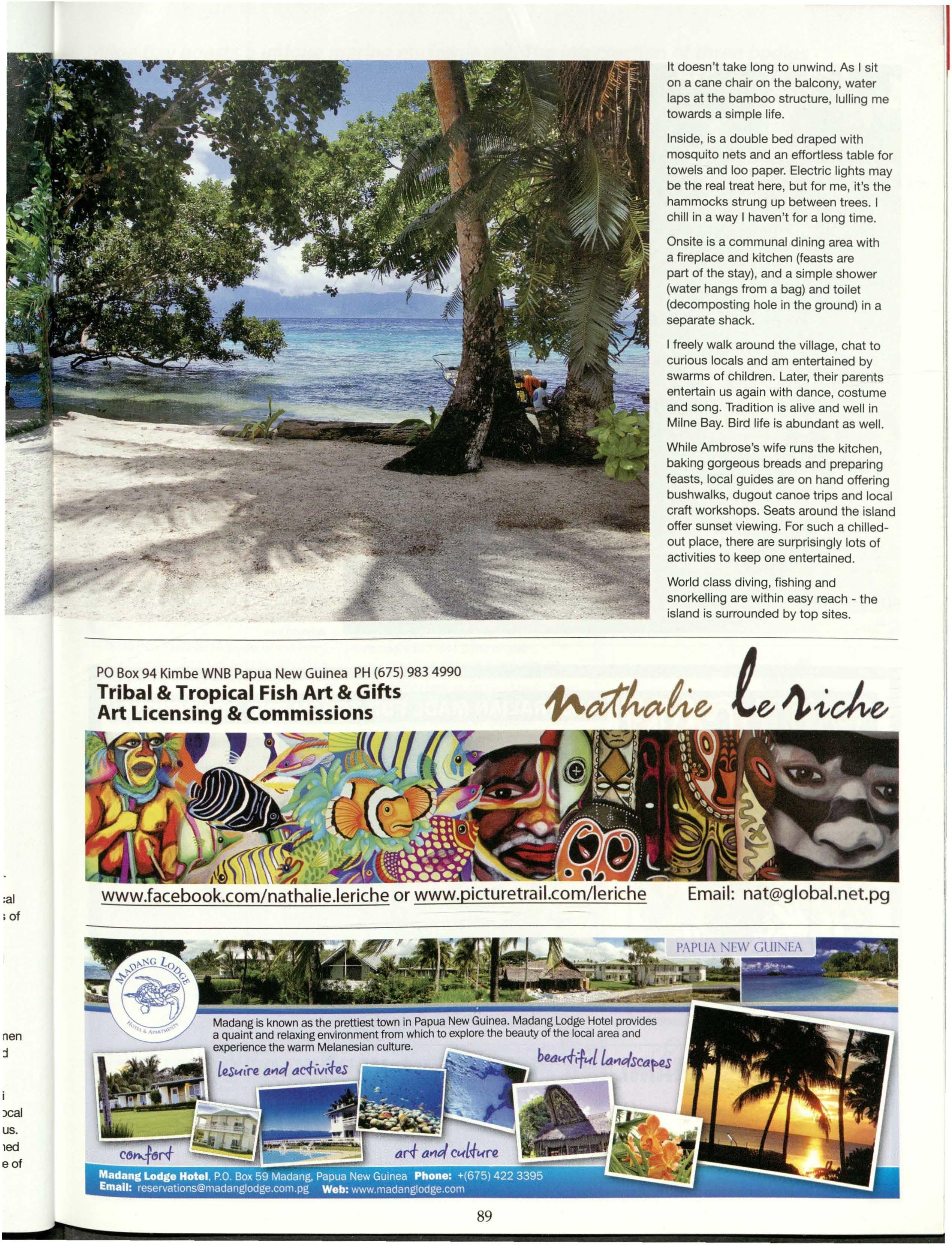
It doesn't take long to unwind. As I sit on a cane chair on the balcony, water laps at the bamboo structure, lulling me towards a simple life.
Inside, is a double bed draped with mosquito nets and an effortless table for towels and loo paper. Electric lights may be the real treat here, but for me, it's the hammocks strung up between trees. I chill in a way I haven't for a long time.
Onsite is a communal dining area with a fireplace and kitchen (feasts are part of the stay), and a simple shower (water hangs from a bag) and toilet (decomposting hole in the ground) in a separate shack.
I freely walk around the village, chat to curious locals and am entertained by swarms of children. Later, their parents entertain us again with dance, costume and song. Tradition is alive and well in Milne Bay. Bird life is abundant as well.
While Ambrose's wife runs the kitchen, baking gorgeous breads and preparing feasts, local guides are on hand offering bushwalks, dugout canoe trips and local craft workshops. Seats around the island offer sunset viewing. For such a chilledout place, there are surprisingly lots of activities to keep one entertained.
World class diving, fishing and snorkelling are within easy reach - the island is surrounded by top sites.
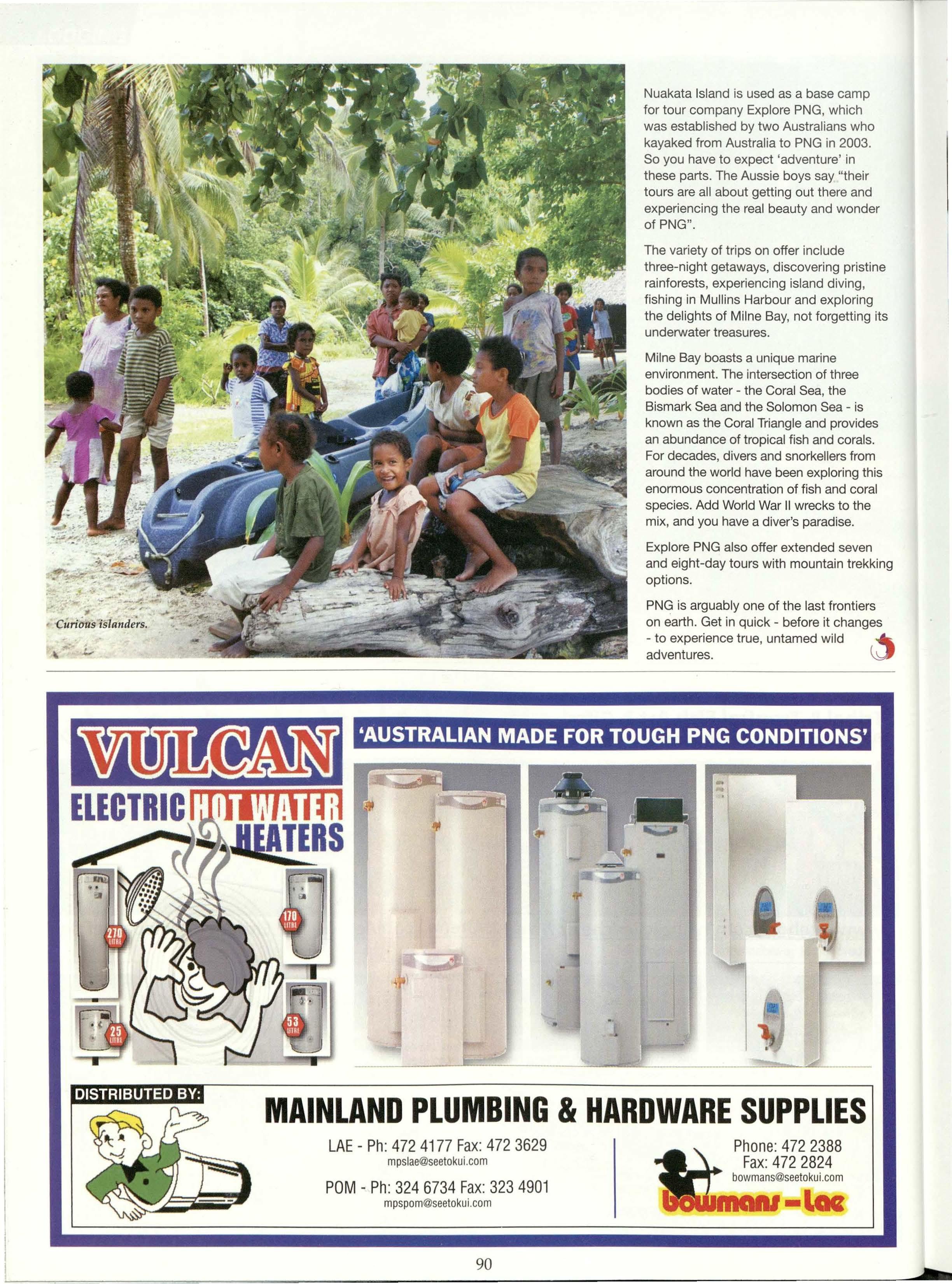
Nuakata Island is used as a base camp for tour company Explore PNG, which was established by two Australians who kayaked from Australia to PNG in 2003. So you have to expect 'adventure' in these parts. The Aussie boys say "their tours are all about getting out there and experiencing the real beauty and wonder of PNG".
The variety of trips on offer include three-night getaways, discovering pristine rainforests, experiencing island diving, fishing in Mullins Harbour and exploring the delights of Milne Bay, not forgetting its underwater treasures.
Milne Bay boasts a unique marine environment. The intersection of three bodies of water - the Coral Sea, the Bismark Sea and the Solomon Sea - is known as the Coral Triangle and provides an abundance of tropical fish and corals. For decades, divers and snorkellers from around the world have been exploring this enormous concentration of fish and coral species. Add World War II wrecks to the mix, and you have a diver's paradise.
Explore PNG also offer extended seven and eight-day tours with mountain trekking options.
PNG is arguably one of the last frontiers on earth. Get in quick - before it changes - to experience true, untamed wild ._ adventures.
Milne Bayboastsa uniquemarineenvironment.Theintersectionof threebodies of water- the CoralSea, the BismarkSeaand the SolomonSea- is knownas the CoralTriangleand providesan abundanceof tropicalfishand corals.

GETTING THERE: Air Niugini flies from Port Moresby to Gurney Airport (Milne Bay). Visit www.airniugini.com.pg
STAYING THERE: Nuakata Island ecobush camp offers two simple beachside cottages with shared facilities in a friendly village setting. Explore PNG uses Nuakata Island as a base camp for many of its tours.
- Visitwww.explorepng.com
On the mainland at Alotau, capital of Milne Bay Province, Alotau International Hotel is the base for Explore PNG, and acts as a convenient and comfortable gateway point. The hotel has 22 wellappointed rooms with balconies offering panoramic views of Milne Bay. Facilities include swimming pool, restaurant, bars,
coffee shop, internet access and dive shop. The waterfront hotel is minutes away by foot from the main street, port, and markets.
- Phone+ 675 641 0300 or visit www.alotauinternationalhotel.com.pg.
OTHER TOURS: Milne Bay Magic Tours provide tours of the Milne Bay area, including the islands of Samarai, Kwato and Doini. The Alotau Highlights is a fascinating half day tour that explores the town's cultural, natural and historical attributes, including its important role in WWII. The tour ends with a traditional lunch at Rabe village. Tours can also be arranged through Alotau International Hotel.
- Phone +675 641 0 711 or visit

• DrillingRigs
• HydraulicWorkoverRigs
• SnubbingUnits
• CampRentals
• ForkliftRentals
• CraneRentals
• StagingBaseEQuipmentRentals
Contact us to discuss your Equipment needs:
Phone: +61 4 4893 1182
Email: info@higharctic.com.au
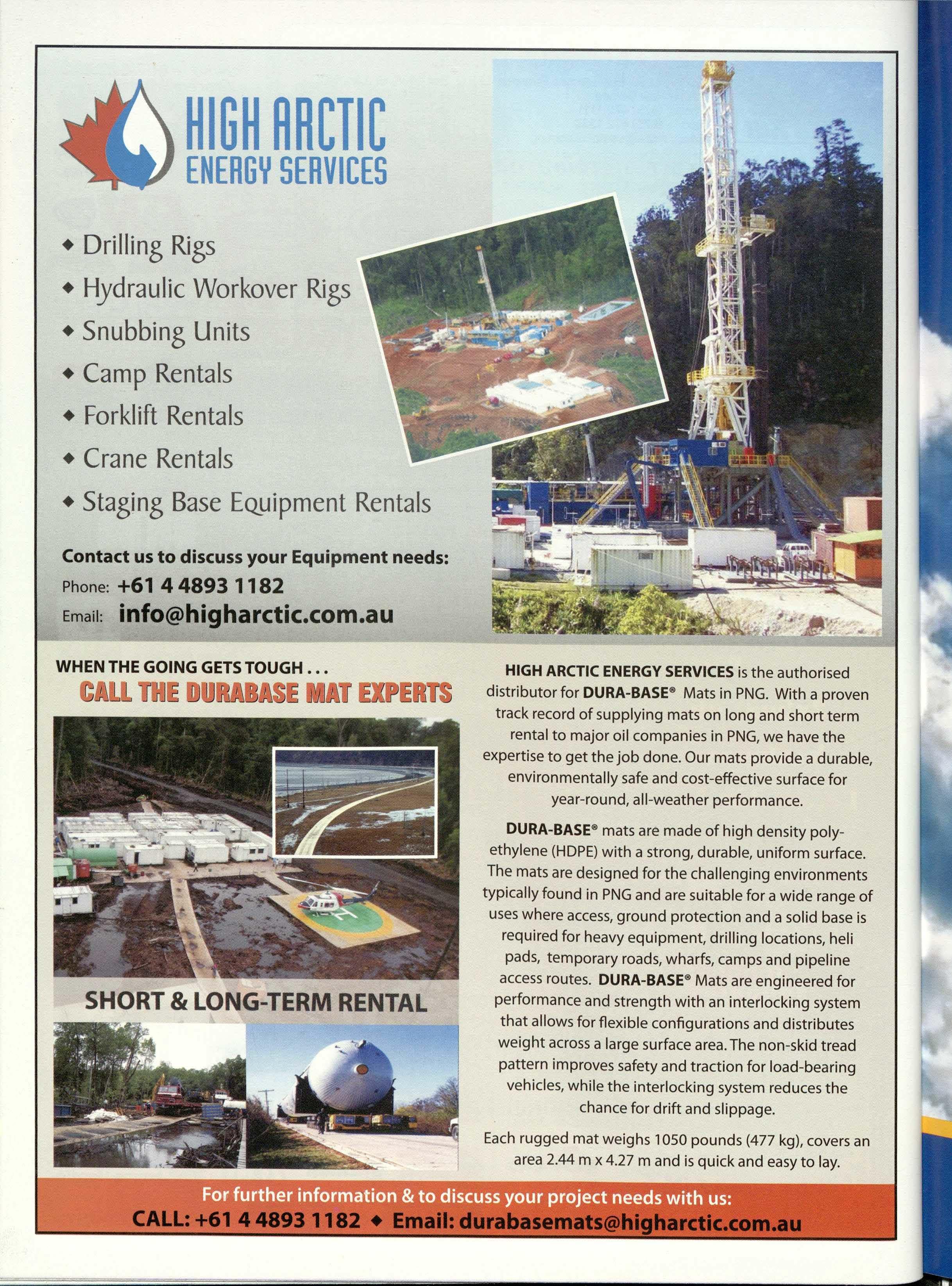
HIGH ARCTIC ENERGYSERVICESis the authorised distributor for DURA-BASE® Mats in PNG. With a proven track record of supplying mats on long and short term rental to major oil companies in PNG,we have the expertise to get the job done. Our mats provide a durable, environmentally safe and cost-effective surface for year-round, all-weather performance.
DURA-BASE®mats are made of high density polyethylene (HOPE)with a strong, durable, uniform surface. The mats are designed for the challenging environments typically found in PNG and are suitable for a wide range of uses where access,ground protection and a solid base is required for heavy equipment, drilling locations, heli pads, temporary roads, wharfs, camps and pipeline access routes. DURA-BASE®Mats are engineered for performance and strength with an interlocking system that allows for flexible configurations and distributes weight across a large surface area. The non-skid tread pattern improves safety and traction for load-bearing vehicles, while the interlocking system reduces the chance for drift and slippage.
Each rugged mat weighs 1050 pounds (477 kg), covers an area 2.44 m x 4.27 m and is quick and easy to lay.
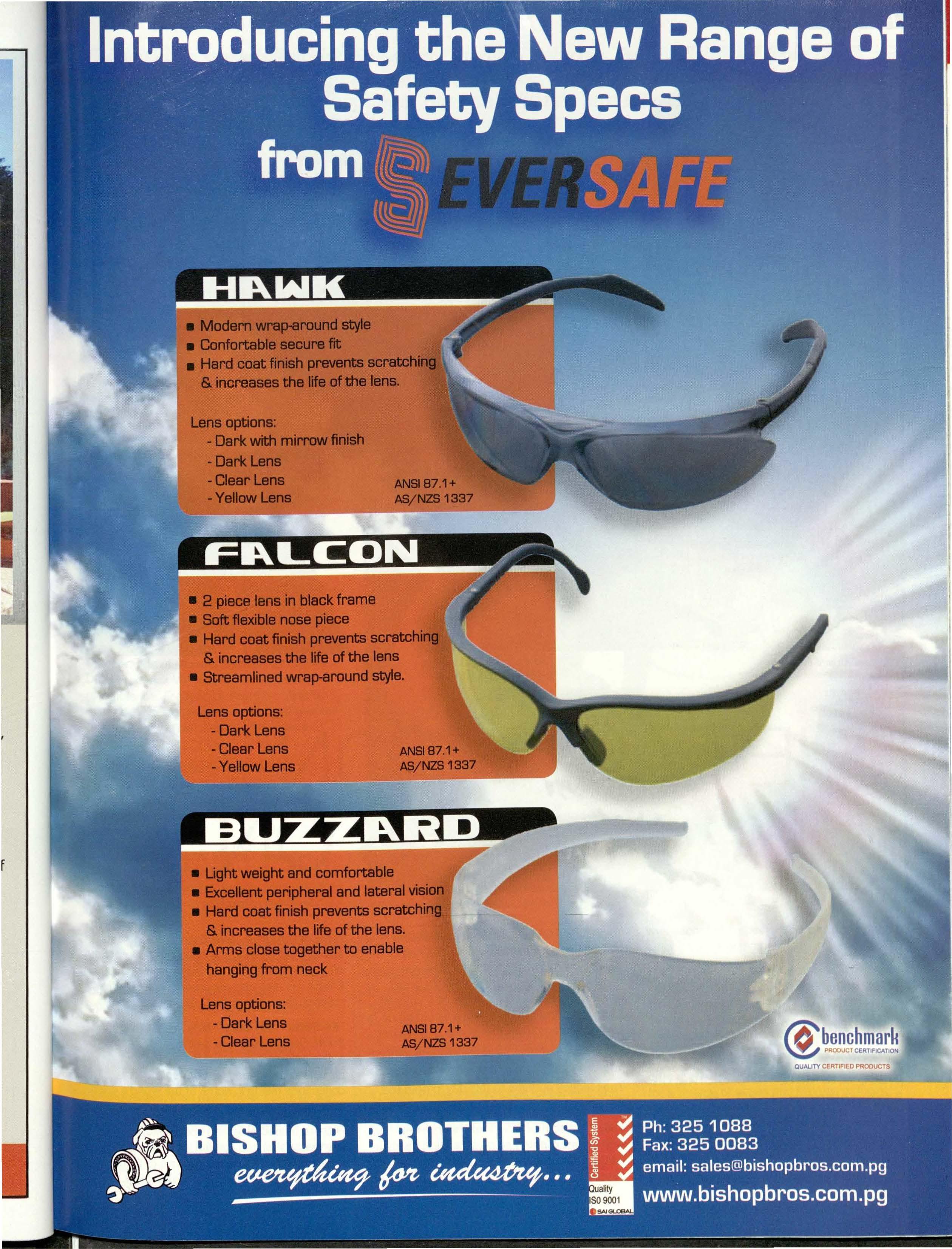
Lansoptlone: -DarkLans and comfortabl ~land
OC)atfinishpravantsSC thelife of the lens. s cloaat.ogethart.o enable Ingfrom neck
Lensoptions: -Oarkl.ans -Claarl.ans
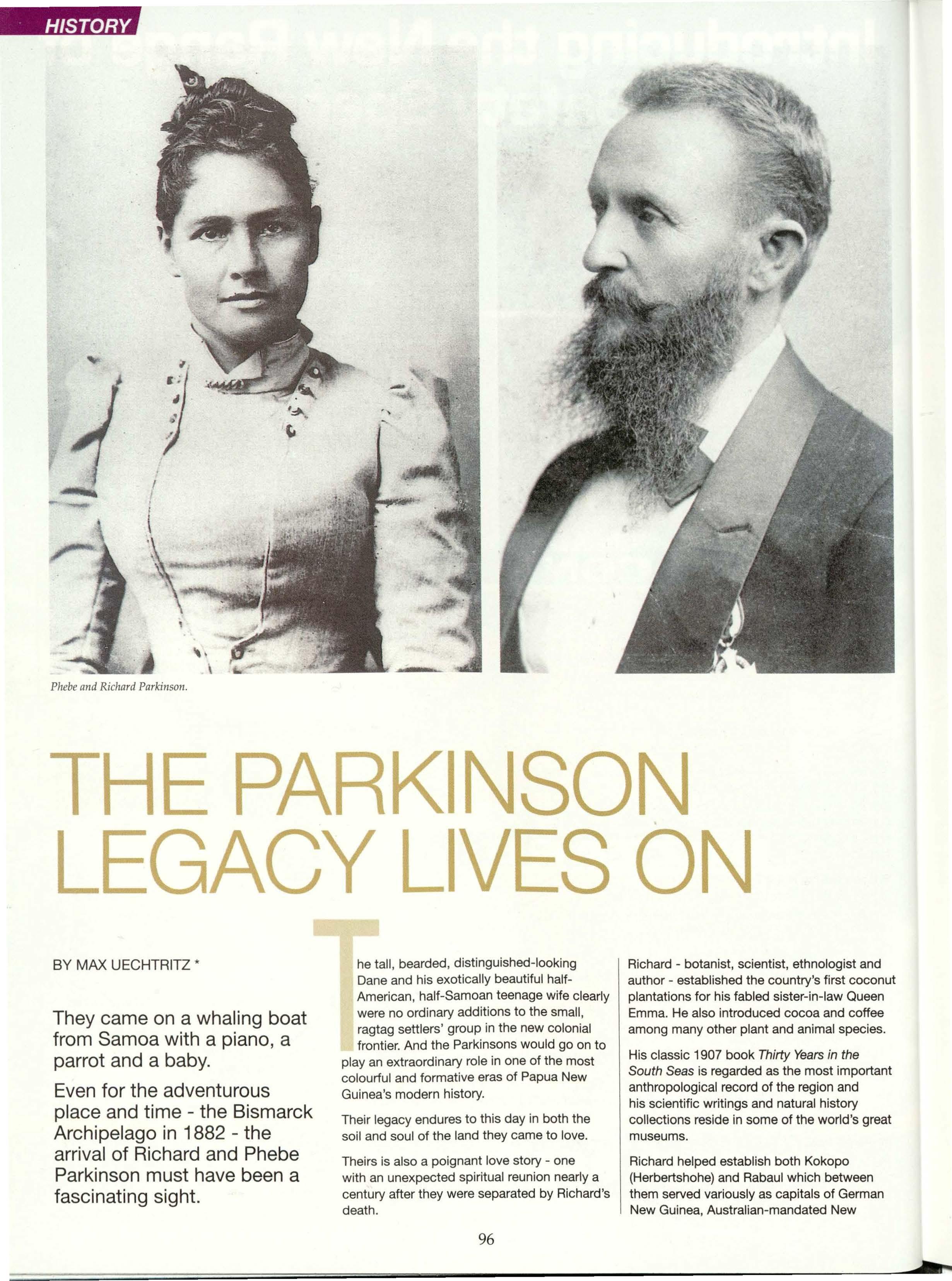
BY MAX UECHTRITZ *
They came on a whaling boat from Samoa with a piano, a parrot and a baby.
Even for the adventurous place and time - the Bismarck Archipelago in 1882 - the arrival of Richard and Phebe Parkinson must have been a fascinating sight.
he tall, bearded, distinguished-looking Dane and his exotically beautiful halfAmerican, half-Samoan teenage wife clearly were no ordinary additions to the small, ragtag settlers' group in the new colonial frontier. And the Parkinsons would go on to play an extraordinary role in one of the most colourful and formative eras of Papua New Guinea's modern history.
Their legacy endures to this day in both the soil and soul of the land they came to love.
Theirs is also a poignant love story - one with an unexpected spiritual reunion nearly a century after they were separated by Richard's death.
Richard - botanist, scientist, ethnologist and author - established the country's first coconut plantations for his fabled sister-in-law Queen Emma. He also introduced cocoa and coffee among many other plant and animal species.
His classic 1907 book Thirty Years in the South Seas is regarded as the most important anthropological record of the region and his scientific writings and natural history collections reside in some of the world's great museums.
Richard helped establish both Kokopo (Herbertshohe) and Rabaul which between them served variously as capitals of German New Guinea, Australian-mandated New
Phebewasa superblinguist.She spokeEnglish,Samoan,French(learnedfrom the nunswho educatedher) and Germanfluently.But, unlikeher husbandand sister,it was her masteringof the Tolailanguage,regionaldialeds and pidgin, whichmade her an indispensablebusinessand culturalconduit.
Guinea, and New Britain Rabaul recently celebrated the 100 years anniversary of its foundation under the Germans and the Parkinsons' contribution was highlighted.
Little wonder Queen Emma author R W Robson described Richard as "beyond question, New Guinea's most distinguished pioneer" and that he was tagged "the father of our commercial agriculture" by former PNG Prime Minister Sir Rabbie Namaliu.
[Incidental to all this and unknown to most, Richard was of Danish royal blood. He was the illegitimate son of Christian August II, Duke of Augustenberg, second in line to the Danish throne.
The Duke had a love affair with a lady-inwaiting to his wife, the Duchess. The woman became pregnant and five weeks before giving birth was "married off" to the Duke's horse trainer, an Englishman called Parkinson, who then was promptly dispatched back to England and never seen again.
The Duke had young Richard educated in Augustenberg Castle, alongside his half brothers and sisters - with the consent of the Duchess. He built a fine house nearby for the boy and his mother. This house is now restored and heritage protected.
Photographs of Richard and his half brother, Duke Frederick VIII, show a remarkable resemblance. Frederick's daughter Viktoria married Kaiser Wilhelm II, so Richard was the half uncle of the last German Empress and Queen of Prussia.
But Phebe undoubtedly was the woman behind the success of both her husband and her famous sister immortalised in books and a feature film starring American actress Barbara Carrera.
Phebe - like her sister Emma - was born in Apia, Samoa. Their father was American Consul Jonas Coe and mother Johana Le'utu, a princess of the royal Malietoa family of
WifePhebetranslatesfor husbandRichard(standing).Phebewas a superblinguist. Samoa.
Emma with her then de facto husband Thomas Farrell began trading on the Duke of York Islands in 1879 but it wasn't until the arrival of the Parkinsons three years later that the commercial empire that gave her riches and 'royalty' began to take shape on New Britain.
Richard surveyed and planted Ralum Plantation - with its famous bungalow Gunantambu - as Queen Emma's headquarters, then many other coconut and mixed plantations for her. Phebe, crucially, recruited the labour to work them.
Later, when Richard went to work for the German New Guinea Company, Phebe also took over managing Emma's burgeoning

plantations as well as the Parkinsons' own at Kuradui.
Phebe was a superb linguist. She spoke English, Samoan, French (learned from the nuns who educated her) and German fluently. But, unlike her husband and sister, it was her mastering of the Tolai language, regional dialects and pidgin, which made her an indispensable business and cultural conduit. If not for Phebe's translations for her husband, Thirty Yearsin the South Seas and his other works could never have been written.
Because of her empathy and innate understanding of them and her willingness to learn their languages and customs, Phebe
was accorded a special affection and status among the local people.
They called her "Miti" or Mother and turned to her to settle disputes and medicate their sick. She periodically saved children from the notorious 'blackbirders' plaguing the coast and placed them with missions.
She would "buy" with shell money other orphans captured in local wars and destined for a lifetime of abuse and slavery and send them off to the sisters. She even took in and raised some orphans at Kuradui where she and Richard were bringing up 12 of their own children.
British author Lillian Overell in her 1921 book A
WhenQueenEmmasold her empm ,n 1911 and mo d to lux ry Sydneyharbours, mansion,she imploredPheb to I01nher. But Phebecouldnot bear to leave "her p ople11 and Ne Britaindespitet ter losingKurad ·n the tougheconomicclimes broughton by WorldWarI.
Woman's Impression of German New Guinea wrote quaintly about Phebe: "The (Raluana) people came running out of the villages as they heard the carriage. Everywhere Miti was recognised and glad cries of "Miti, Miti" resounded.
"Mothers held up their children that they might see her, withered old women got as near to her as they could, and the luluais shook hands gravely. Miti knew everybody, inquired after their families and circumstances, sympathised with their griefs and smiled benevolently on them all."
Richard died in 1909. Before his death from a lingering illness, he had laid out the Parkinson family cemetery or mat mat on a headland at Kuradui. He and Phebe made a pact that eventually she would be laid to rest there beside him.
When Queen Emma sold her empire in 1911 and moved to a luxury Sydney harbourside mansion, she implored Phebe to join her. But Phebe could not bear to leave "her people" and New Britain despite later losing Kuradui in the tough economic climes brought on by World War I.
Though close, the sisters could not have been more different. One saw New Guinea as an opportunity, the other as home.
One died fabulously wealthy in Europe's playground in Monte Carlo and her ashes lie in a prestigious plot in Vaucluse, Sydney, within two metres of the resting place of Australia's commercial 'royalty', the Packers.
The other lived out her senior years in poverty in the villages of the people she loved and starved to death in a Japanese
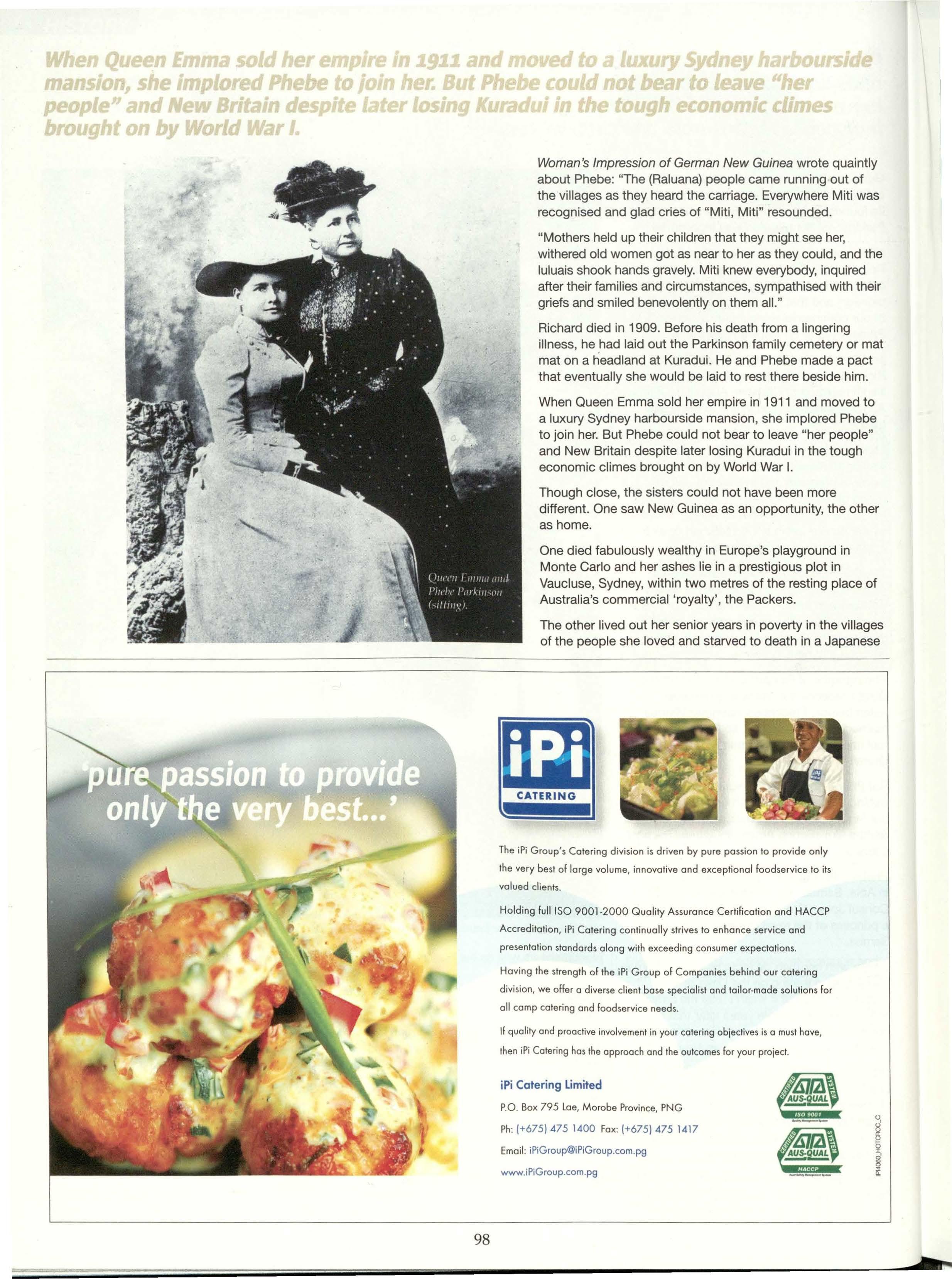
The iPi Group's Catering division is driven by pure passion to provide only the very best of lorge volume, innovative and exceptional foodservice to its valued clients.
Holding full ISO 9001-2000 Quality Assurance Certification and HACCP Accreditation, iPi Catering continually strives to enhance service and presentation standards along with exceeding consumer expectations.
Having the strength of the iPi Group of Companies behind our catering division, we offer a diverse client base specialist and toilor•mode solutions for oil camp catering and Foodservice needs.
If quality and proactive involvementin your catering objectives is a musthove, then iPi Catering hos the opprooch and the outcomesfor your project.
iPi Catering Limited
P.O. Box 795 Loe, Morobe Province, PNG
Ph: (+675) 475 1400 Fox: (+675) 475 1417
Email: iPiGroup@iPiGroup.com.pg www.iPiGroup.com.pg
"Mothersheld up their childrenthat they might see her, witheredold womengot as near to her as they could,and the luluaisshookhandsgravely.Miti knew everybody, inquiredafter their familiesand circumstances,sympathisedwith their griefsand smiledbenevolentlyon them all. i
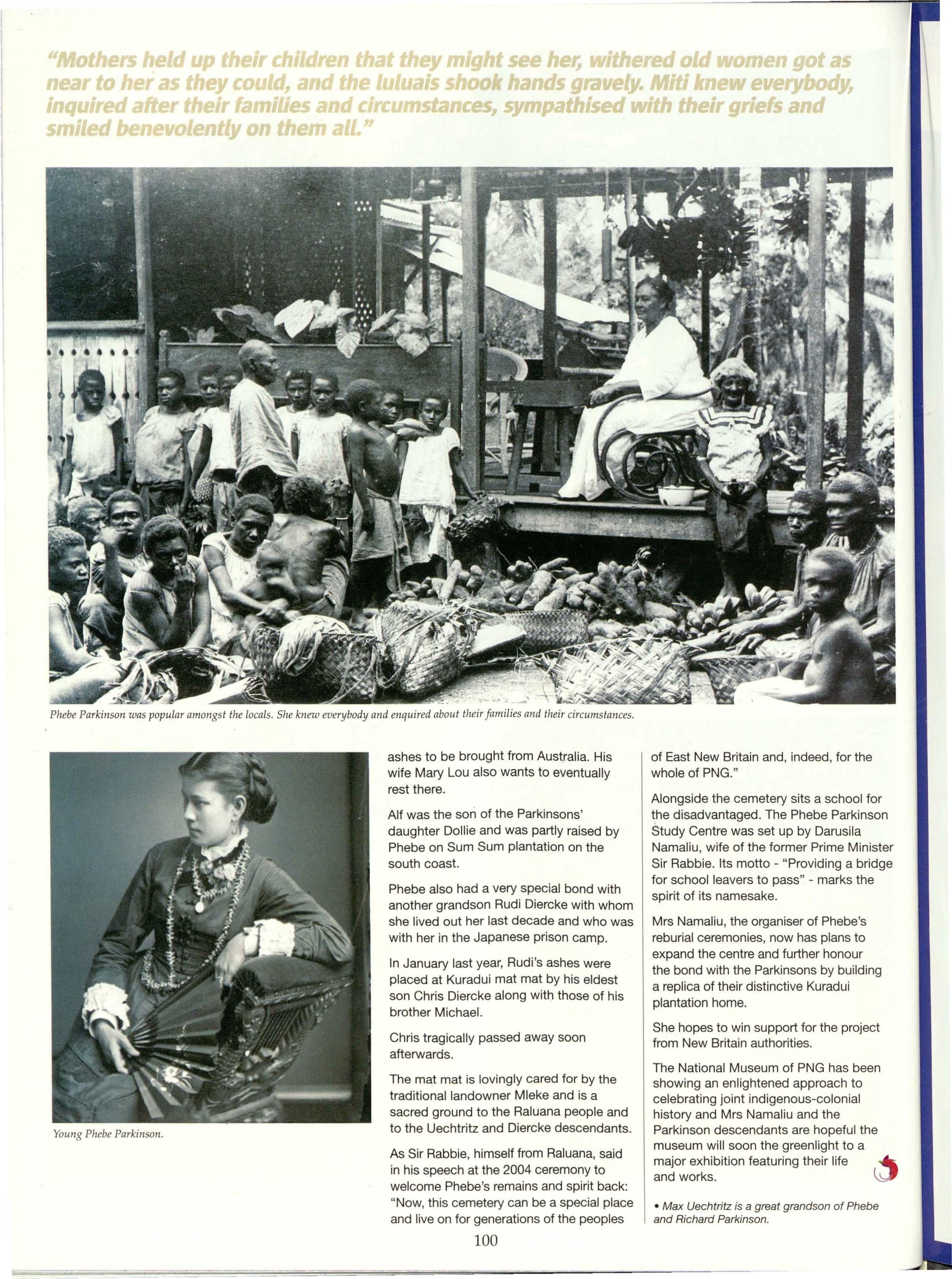
circumstances.
ashes to be brought from Australia. His wife Mary Lou also wants to eventually rest there.
Alf was the son of the Parkinsons' daughter Dollie and was partly raised by Phebe on Sum Sum plantation on the south coast.
Phebe also had a very special bond with another grandson Rudi Diercke with whom she lived out her last decade and who was with her in the Japanese prison camp.
In January last year, Audi's ashes were placed at Kuradui mat mat by his eldest son Chris Diercke along with those of his brother Michael.
Chris tragically passed away soon afterwards.
The mat mat is lovingly cared for by the traditional landowner Mleke and is a sacred ground to the Raluana people and to the Uechtritz and Diercke descendants.
As Sir Rabbie, himself from Raluana, said in his speech at the 2004 ceremony to welcome Phebe's remains and spirit back: "Now, this cemetery can be a special place and live on for generations of the peoples
of East New Britain and, indeed, for the whole of PNG."
Alongside the cemetery sits a school for the disadvantaged. The Phebe Parkinson Study Centre was set up by Darusila Namaliu, wife of the former Prime Minister Sir Rabbie. Its motto - "Providing a bridge for school leavers to pass" - marks the spirit of its namesake.
Mrs Namaliu, the organiser of Phebe's reburial ceremonies, now has plans to expand the centre and further honour the bond with the Parkinsons by building a replica of their distinctive Kuradui plantation home.
She hopes to win support for the project from New Britain authorities.
The National Museum of PNG has been showing an enlightened approach to celebrating joint indigenous-colonial history and Mrs Namaliu and the Parkinson descendants are hopeful the museum will soon the greenlight to a major exhibition featuring their life and works.
• Max Uechtritz is a great grandson of Phebe and Richard Parkinson.
Servicing Papua New Guinea since 1945
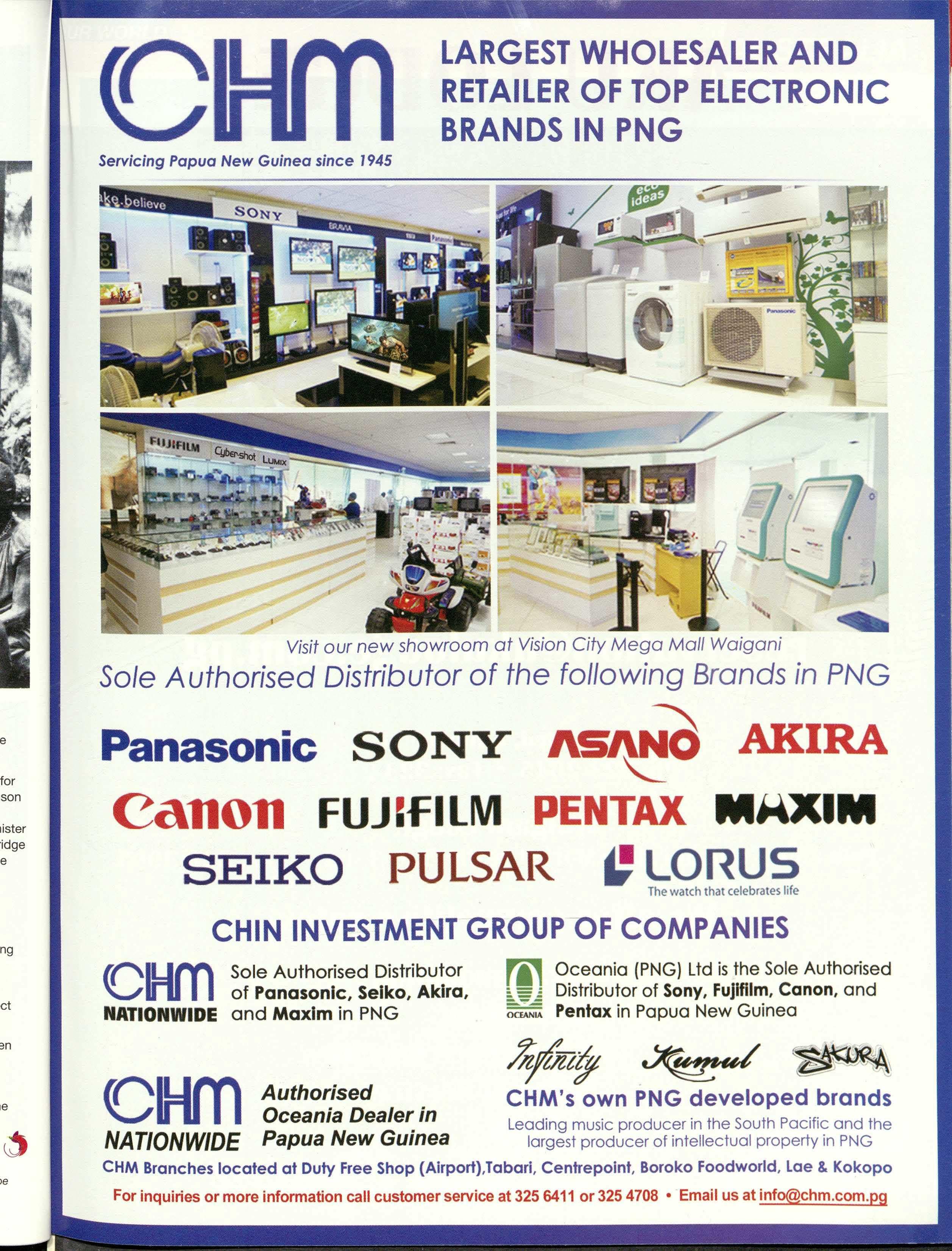
/4j'tkt!ft
CHM's
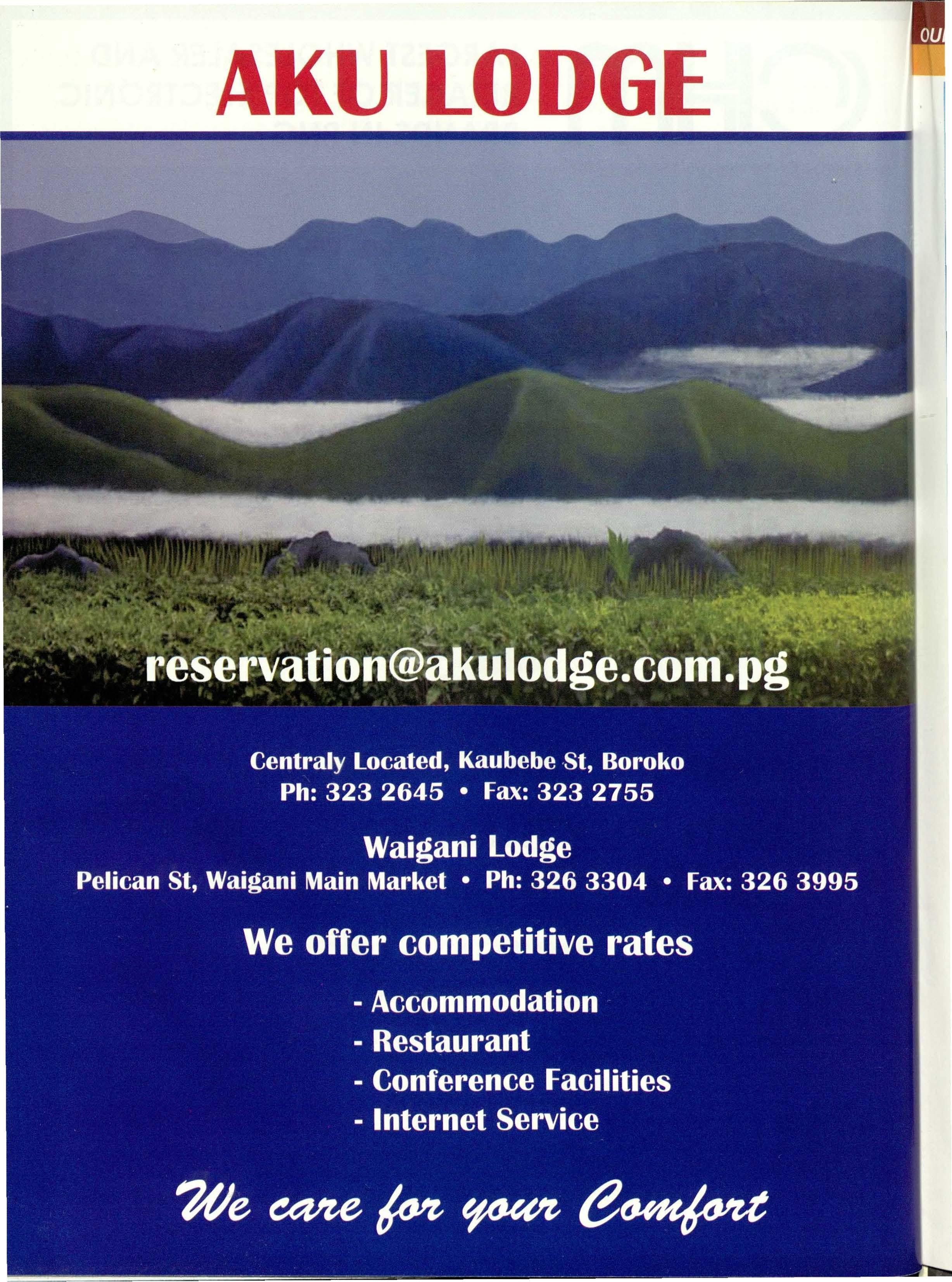
BY ANDY PHILLIPS

'm not trying to boast or anything like that, but the first night I visited Orpheus Island, I ate more courses than there were people in the restaurant.
And that's not including the shot glass of pineapple sorbet brought out between the fifth and sixth courses. They're palettefresheners, apparently.
In fact, had there not been another two guests dining by candlelight down on the jetty, the island shielding them from the winds of the Pacific Ocean, I would have eaten more courses than there were guests in the entire resort. Then again, so would my wife.
But finding a restaurant in a National Park which is in the middle of the Great Barrier Reef is the sort of feat which helps build an appetite.
It also helps when the courses are part of a degustation menu, each delicate dish expertly prepared to stimulate every taste bud without making the diner feel like they have grown several belt sizes in one sitting.
Among the seven-course feast were seared Moreton Bay bugs with a tian of lime and avocado, and chargrilled kangaroo fillet with basil pesto, caramelised butternut pumpkin, oyster mushrooms and confit of garlic.
Dbtoncefrorn81i!lbune to Town,villo: 1457km (903 mi)
Degustation dining is usually only to be found in big cities, which adds to the unique qualities of this spectacular island resort.
Among the past guests are Elton John and Phil Collins, while Hugo Weaving - Agent Smith from The Matrix - dropped in to the wine and cheese tasting night when he stayed.
The open-sided dining room is also regularly visited by bandicoots, who have become used to gaining a titbit or two off the plates of the well-to-do.
Resort manager Aaron Murphy told us that two of the long-nosed, pointy-eared creatures had been relocated to a distant part of the island after their visits became too frequent.
One of the bandicoots had become unwell after a particularly fascinated guest ate just one course of her dinner, and fed him the remaining six.
Yet the lure of fine dining is not the only attraction on Orpheus - nor the only surprise.
Reaching the island had taken just 25 minutes by seaplane from Townsville, yet it felt a world away from the city we had left behind.

The flight over the clear blue waters of the Great Barrier Reef was an experience worth turning up for on its own.
The spectacular views of the north Queensland coast were followed by even more sumptuous vistas of islands and shallow reefs.
We landed smoothly on the water and taxied up to a floating pontoon no bigger than half a squash court. A sign at one end read 'Welcome to Orpheus Island International Airport'.
A small boat ferried us up to the shore, with the colonial chic of the restaurant, its paddle fans swishing the air, the first thing we saw.
A short stroll through the tropical gardens, our room was smart but not extravagant, with tiled floors and a comfy lounge area, plus a covered outdoor patio.
It didn't take long to explore the rest of the resort: the pool with swim-up bar, spa nestled between palms, a second pool in nautical style, plus gym and tennis court to the rear of the main building.
We hooked a small lizard out of the pool and he stayed on our warm hands for a few minutes before we gingerly placed him on the edge of a glass coffee table.
We sat on sunloungers overlooking the empty beach.
It became clear that apart from the food,

visitors to Orpheus Island were paying for nothing: no roads, no cars, no children, no noise.
The only sounds were the occasional squawk of sulphur-crested cockatoos and the jangling of the flag pole at the end of the jetty.
At 6pm, the entire guest roster turned up for
the sunset cruise - all six of us. As the boat puttered away from the shore, we sipped sparkling Australian wine while the sun sparkled on the water.
The boat skirted the green edges of the island and then turned around as the sun slipped slowly behind the silhouette of the mainland, turning the sky a burnished pink.
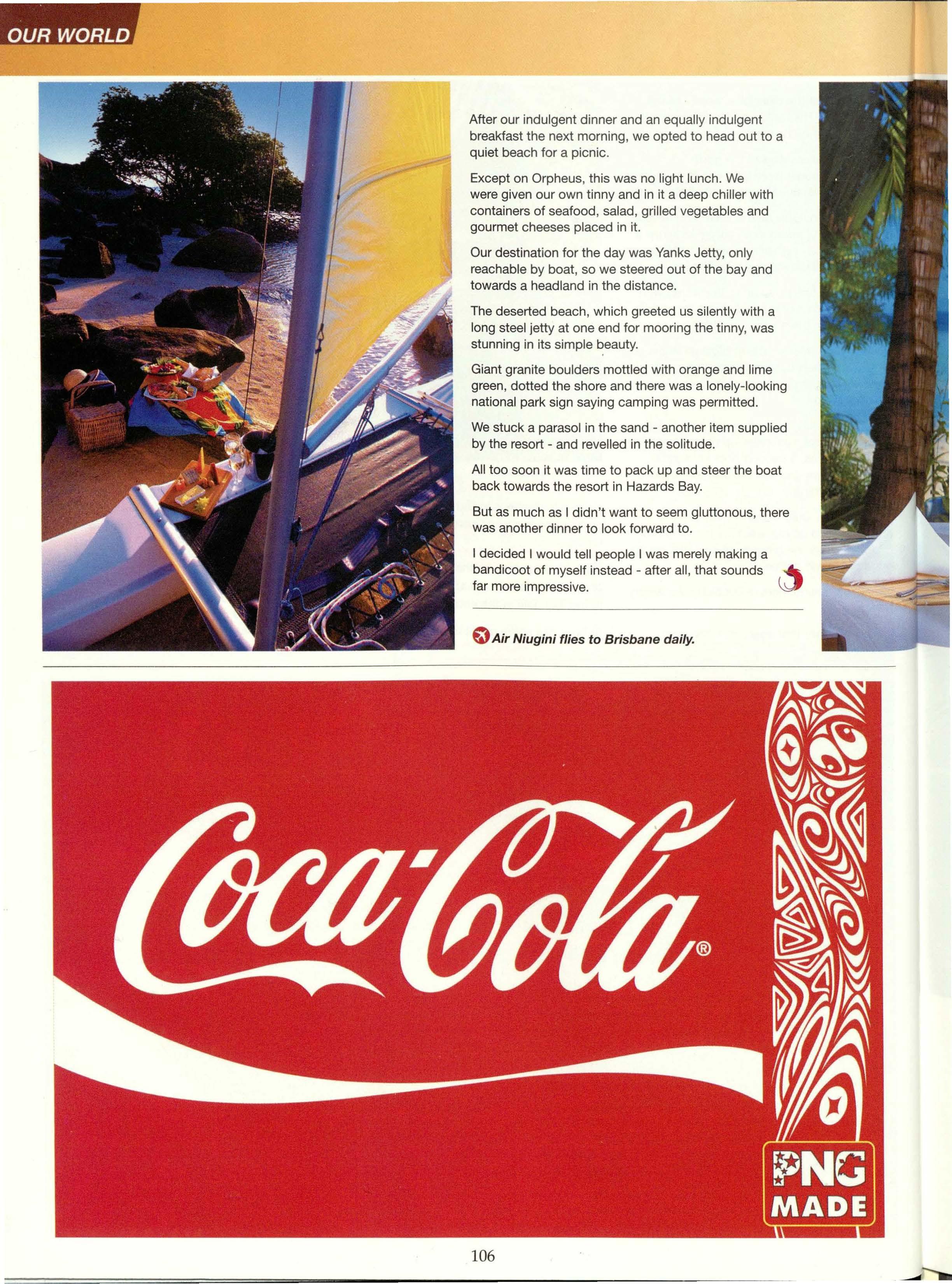
After our indulgent dinner and an equally indulgent breakfast the next morning, we opted to head out to a quiet beach for a picnic.
Except on Orpheus, this was no light lunch. We were given our own tinny and in it a deep chiller with containers of seafood, salad, grilled vegetables and gourmet cheeses placed in it.
Our destination for the day was Yanks Jetty, only reachable by boat, so we steered out of the bay and towards a headland in the distance.
The deserted beach, which greeted us silently with a long steel jetty at one end for mooring the tinny, was stunning in its simple beauty.
Giant granite boulders mottled with orange and lime green, dotted the shore and there was a lonely-looking national park sign saying camping was permitted.
We stuck a parasol in the sand - another item supplied by the resort - and revelled in the solitude.
All too soon it was time to pack up and steer the boat back towards the resort in Hazards Bay.
But as much as I didn't want to seem gluttonous, there was another dinner to look forward to.
I decided I would tell people I was merely making a bandicoot of myself instead - after all, that sounds far more impressive.
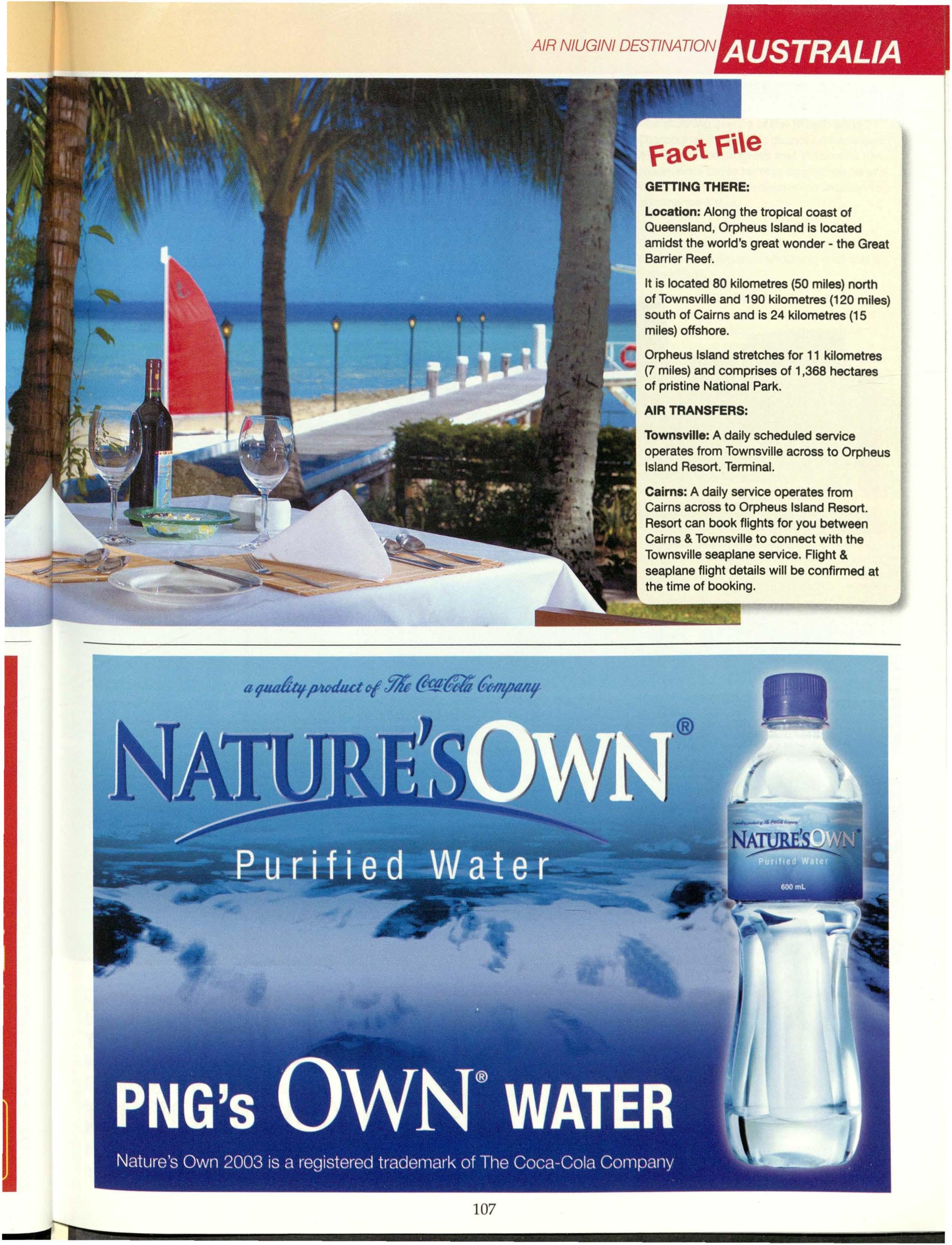
Location:Along the tropical coast of Queensland, Orpheus Island is located amidst the world's great wonder - the Great Barrier Reef.
It is located 80 kilometres (50 miles) north of Townsville and 190 kilometres (120 miles) south of Cairns and is 24 kilometres (15 miles) offshore.
Orpheus Island stretches for 11 kilometres (7 miles) and comprises of 1 ,368 hectares of pristine National Park.
Townsville:A daily scheduled service operates from Townsville across to Orpheus Island Resort. Terminal.
Cairns:A daily service operates from Cairns across to Orpheus Island Resort. Resort can book flights for you between Cairns & Townsville to connect with the Townsville seaplane service. Flight & seaplane flight details will be confirmed at the time of booking.
On the twenty-minute train journey from Tokyo to Yokohama, one barely notices Wherethe capital ends and its flashy kid brother begins. But upon arrival, the atmosphere becomes distinctly more relaxed and cosmopolitan.
ith a population of 3.6 million people, the breezy port city of Yokohama is far from small, yet its mustsee attractions are conveniently clustered near the seafront and easily accessible on foot or public transport.
Just over 150 years ag, Yokohama was a tiny fishing village before United States Commodore Matthew Perry's Black Ships famously arrived nearby and demanded the opening of ports to foreign trade.
Yokohama was selected and the port was opened on June 2, 1859, with silk being a major commodity especially for trade with Great Britain.
The area soon became a vanguard for foreign influence and was soon to boast Japan's first railway, photo studio, daily newspaper, beer brewery, bakery and cinema.
Architecturally and culturally the influence of the foreign communities - both Western and Asian - remains strong and helps to create a diverse, thriving and attractive city.
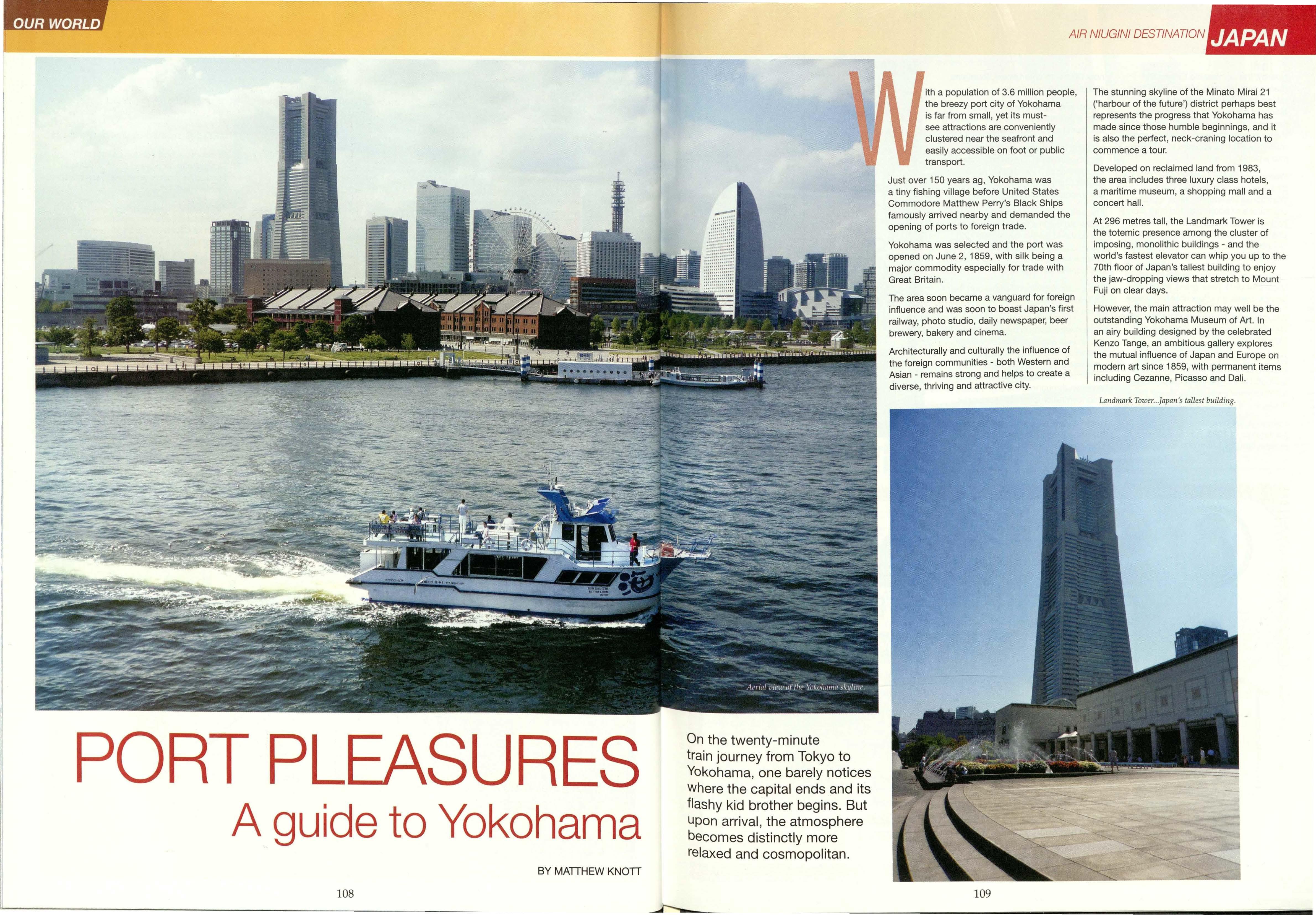
The stunning skyline of the Minato Mirai 21 {'harbour of the future') district perhaps best represents the progress that Yokohama has made since those humble beginnings, and it is also the perfect, neck-craning location to commence a tour.
Developed on reclaimed land from 1983, the area includes three luxury class hotels, a maritime museum, a shopping mall and a concert hall.
At 296 metres tall, the Landmark Tower is the totemic presence among the cluster of imposing, monolithic buildings - and the world's fastest elevator can whip you up to the 70th floor of Japan's tallest building to enjoy the jaw-dropping views that stretch to Mount Fuji on clear days.
However, the main attraction may well be the outstanding Yokohama Museum of Art. In an airy building designed by the celebrated Kenzo Tange, an ambitious gallery explores the mutual influence of Japan and Europe on modern art since 1859, with permanent items including Cezanne, Picasso and Dali.
Nearby, the unmissable Cosmo 21 theme park prevents Minato Mirai from taking itself too seriously and adds plenty of colour (and screams) to the proceedings, with a gigantic ferris wheel that was once the world's tallest, and a roller coaster that appears to disappear into a pond!
Walking along the seafront from Cosmo 21 takes you past the Red Brick Warehouse (Akaranga Soko), a quirky collections of boutiques and craft stores housed within the original fa9ade of the British-style dockside warehouse, and Osanbashi Pier, a creatively-designed international ferry terminal.
Shaped like the many massive ocean liners that dock here, grass and floor boards create an effect of rolling waves. It is a popular place for a stroll that offers unparalled views of the iconic Minato Mirai skyline.
Continuing onwards, Yamashita Park is a similarly loved spot for a waterside walk and is at least partly responsible for Yokohama's seemingly slower pace of life.
Following the devastating Great Kanto earthquake of 1923, rubble was used to reclaim land for parks and Yamashita is
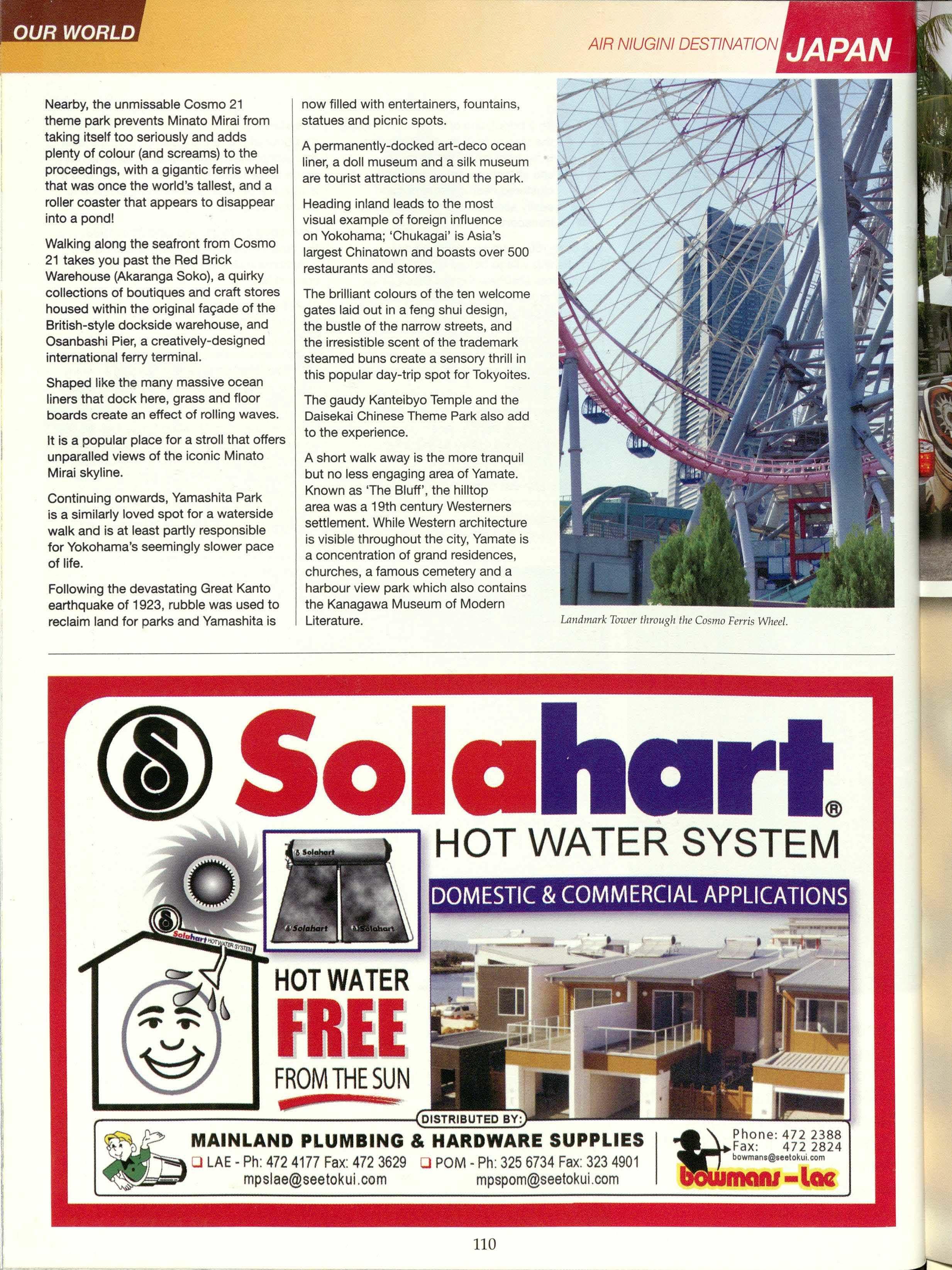
now filled with entertainers, fountains, statues and picnic spots.
A permanently-docked art-deco ocean liner, a doll museum and a silk museum are tourist attractions around the park.
Heading inland leads to the most visual example of foreign influence on Yokohama; 'Chukagai' is Asia's largest Chinatown and boasts over 500 restaurants and stores.
The brilliant colours of the ten welcome gates laid out in a feng shui design, the bustle of the narrow streets, and the irresistible scent of the trademark steamed buns create a sensory thrill in this popular day-trip spot for Tokyoites.
The gaudy Kanteibyo Temple and the Daisekai Chinese Theme Park also add to the experience.
A short walk away is the more tranquil but no less engaging area of Yamate. Known as 'The Bluff', the hilltop area was a 19th century Westerners settlement. While Western architecture is visible throughout the city, Yamate is a concentration of grand residences, churches, a famous cemetery and a harbour view park which also contains the Kanagawa Museum of Modern Literature.
Located within easy walking distance of Cairns Base Hospital and private hospitals and medical centres, Cairns City with its wonderful rerestaurants, the marina, the Esplanade and just 10 mins from Cairns International Airport. Tropical Heritage Cairns offers 45 studio apartments, spa deluxe, standard and disabled rooms, all with large LCDTV, free movie channels, coffee/tea making facilities and some with kitchenette which are ideal for longer stays.
Best of all we offer a distinctive PNG style and hospitality that is unique in Cairns. Our tour desk staff can arrange sightseeing, rental cars and a variety of other activities that are available throughout tropical north Queensland and further afield in Papua New Guinea.

Tropical Heritage Cairns
8 Minnie Street, Cairns, 4870
T:0740511211 F:0740511380
E: info@heritagecairns.com.au
www.cairnsheritage.com.au
T:
F: +675 422 3543
E: info@mtspng.com
Bustling Chinatown.

At the foot of the hill, the Motomachi shopping district prospered from its affluent neighbours, but today thrives as a trendsetting shopping destination, especially for clothes, shoes and original goods.
Beyond this simple route, Yokohama offers countless more attractions, museums and curiosities.
Sankeien Garden is an outstanding example of a traditional Japanese garden, its beauty enhanced by a 500-year-old pagoda and villa transported from Kyoto. Sports
lovers can take in top level baseball and soccer matches, and the Nissan Stadium hosted the 2002 FIFA World Cup Final. The ShinYokohama Ramen Museum is a 9-restaurant loving tribute to the popular noodle dish.
Yokohama's easy access and location make a simple day-trip from Tokyo, but its considerable charms, nightlife and the outstanding night views of ._ Minato Mirai warrant a longer stay. U
0 Air Niugini flies to Japan twice a week.

LOCATION: 29km south of Tokyo in Kanagawa Prefecture
ACCESS: Yokohama can be accessed from Tokyo via the frequent-service Toyoko Line (http://www.tokyu.co.jp/global/index.html), while the MinatoMirai subway line (http:// www.ri1m21railway.co.jp/global/english/ index.html) connects the major tourist areas.
CLIMATE: Hot and humid summers. Relatively mild winters, rarely below freezing.
TOURIST INFO: The official Yokohama city website is at http://www.city.yokohama. lg.jp/en/, while http://www.jnto.go.jp/eng/ is Japan's official tourism site.
Singapore has long been a melting pot of cultures. From the original Peranakan settlerswealthy Chinese who intermarried with the indigenous Malay people - to immigrants from the Middle East, India and Europe, the island's cultural mix is as heady as the fragrance of frangipani blossoms after rain.
So diverse are Singapore's different ethnic precincts that you sometimes forget which country you're in. "Little India", for example, brings together so many different Indian communities that could serve as a mini-India theme park - with plenty of room to spare for other nationalities, too.
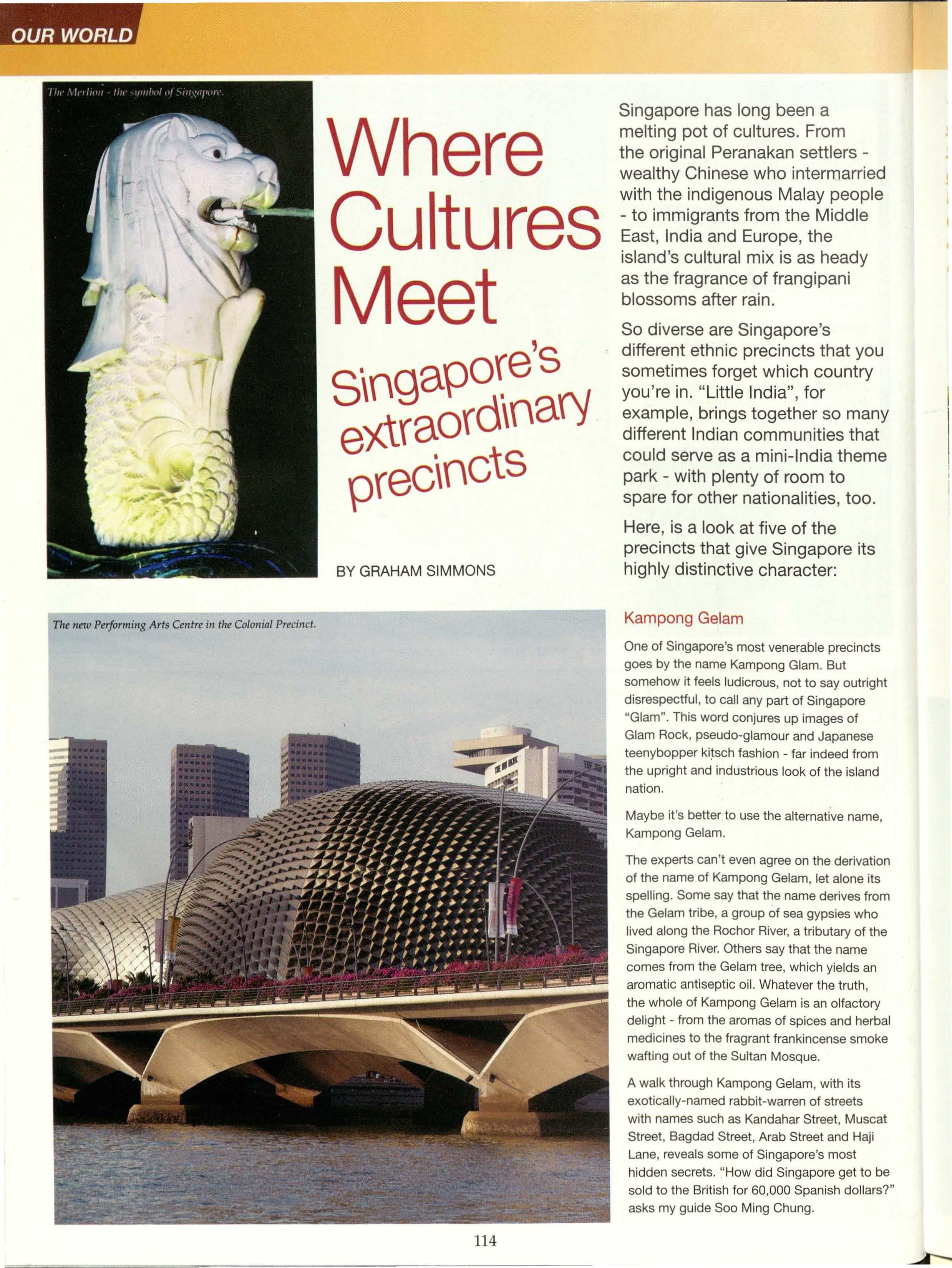
BY GRAHAM SIMMONS
Here, is a look at five of the precincts that give Singapore its highly distinctive character:
One of Singapore's most venerable precincts goes by the name Kampong Glam. But somehow it feels ludicrous, not to say outright disrespectful, to call any part of Singapore "Glam". This word conjures up images of Glam Rock, pseudo-glamour and Japanese teenybopper ki~sch fashion - far indeed from the upright and industrious look of the island nation.
Maybe it's better to use the alternative name, Kampong Gelam.
The experts can't even agree on the derivation of the name of Kampong Gelam, let alone its spelling. Some say that the name derives from the Gelam tribe, a group of sea gypsies who lived along the Rochor River, a tributary of the Singapore River. Others say that the name comes from the Gelam tree, which yields an aromatic antiseptic oil. Whatever the truth, the whole of Kampong Gelam is an olfactory delight - from the aromas of spices and herbal medicines to the fragrant frankincense smoke wafting out of the Sultan Mosque.
A walk through Kampong Gelam, with its exotically-named rabbit-warren of streets with names such as Kandahar Street, Muscat Street, Bagdad Street, Arab Street and Haji Lane, reveals some of Singapore's most hidden secrets. "How did Singapore get to be sold to the British for 60,000 Spanish dollars?" asks my guide Soo Ming Chung.
"Howdid Singaporeget to be soldto the Britishfor 60,ooo Spanishdollars?"asksmy guideSooMing Chung."If you tag along with me for a couple of hours,you'll learn the truth aboutthe sale - and much morebesides!"
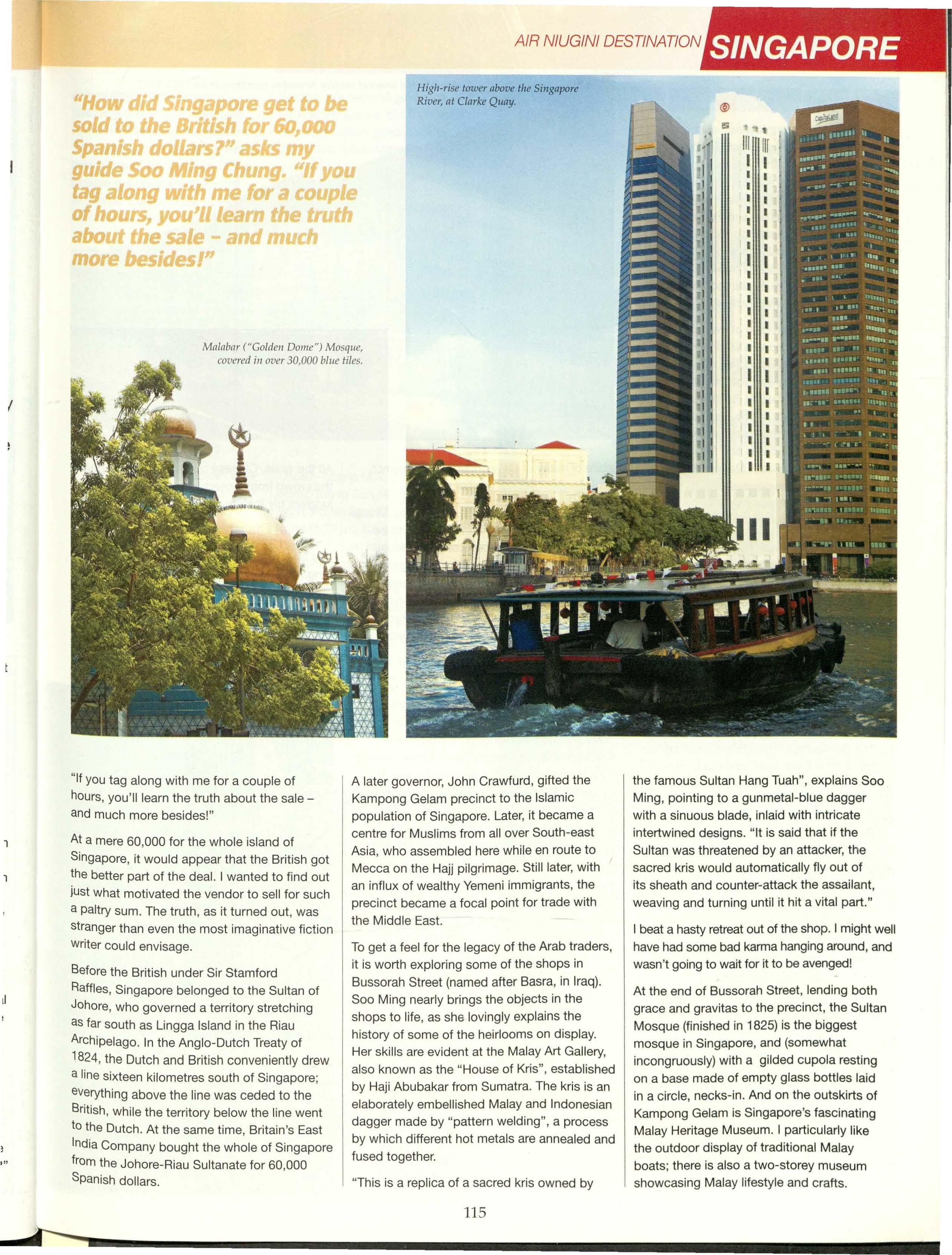
Mnlnbnr ("Golde11Dome") Mosque, coveredi11over 30,000 blue tiles.
"If you tag along with me for a couple of hours, you'll learn the truth about the saleand much more besides!"
At a mere 60,000 for the whole island of Singapore, it would appear that the British got the better part of the deal. I wanted to find out iust what motivated the vendor to sell for such a paltry sum. The truth, as it turned out, was stranger than even the most imaginative fiction Writer could envisage.
Before the British under Sir Stamford Rattles, Singapore belonged to the Sultan of Johore, who governed a territory stretching as far south as Lingga Island in the Riau Archipelago. In the Anglo-Dutch Treaty of 1824, the Dutch and British conveniently drew a line sixteen kilometres south of Singapore; everything above the line was ceded to the British, while the territory below the line went to the Dutch. At the same time, Britain's East India Company bought the whole of Singapore from the Johore-Riau Sultanate for 60,000 Spanish dollars.
A later governor, John Crawfurd, gifted the Kampong Gelam precinct to the Islamic population of Singapore. Later, it became a centre for Muslims from all over South-east Asia, who assembled here while en route to Mecca on the Hajj pilgrimage. Still later, with an influx of wealthy Yemeni immigrants, the precinct became a focal point for trade with the Middle East.
To get a feel for the legacy of the Arab traders, it is worth exploring some of the shops in Bussorah Street (named after Basra, in Iraq). Soo Ming nearly brings the objects in the shops to life, as she lovingly explains the history of some of the heirlooms on display. Her skills are evident at the Malay Art Gallery, also known as the "House of Kris", established by Haji Abubakar from Sumatra. The kris is an elaborately embellished Malay and Indonesian dagger made by "pattern welding", a process by which different hot metals are annealed and fused together.
"This is a replica of a sacred kris owned by
the famous Sultan Hang Tuah", explains Soo Ming, pointing to a gunmetal-blue dagger with a sinuous blade, inlaid with intricate intertwined designs. "It is said that if the Sultan was threatened by an attacker, the sacred kris would automatically fly out of its sheath and counter-attack the assailant, weaving and turning until it hit a vital part."
I beat a hasty retreat out of the shop. I might well have had some bad karma hanging around, and wasn't going to wait for it to be avenged!
At the end of Bussorah Street, lending both grace and gravitas to the precinct, the Sultan Mosque (finished in 1825) is the biggest mosque in Singapore, and (somewhat incongruously) with a gilded cupola resting on a base made of empty glass bottles laid in a circle, necks-in. And on the outskirts of Kampong Gelam is Singapore's fascinating Malay Heritage Museum. I particularly like the outdoor display of traditional Malay boats; there is also a two-storey museum showcasing Malay lifestyle and crafts.
The less-known Katong district, centred around Joo Chiat Street, is not far from Changi International Airport. This was originally home to the first Peranakan settlers, who arrived from China from the 17th Century onwards. They married local Malays and Portuguese immigrants, with the resulting racial mix being one of the most intriguing in all of Asia. The Peranakans favoured Malay styles of dress and food, and their colourfully painted houses are some of Singapore's most attractive dwellings.
To see the finest examples of Peranakan housing, it's worth taking a stroll along Katong's Koon Seng Road, just off the main thoroughfare. Facing each other between Joo Chiat Road and Tembeling Road are two sets of two-storey pre-war shops, each a riot of contrasting colours and now used for housing. The wooden fascia boards and fretwork of these houses comes from Malay sources, while the fa<;:adesare decorated with designs made of plasterwork and tiles - influences derived from Portugal and China.
In Joo Chiat Road, I was treated to one of Katong's finest "inventions", the original Katong Laksa - a simple dish based around cockles and prawns. The depth of flavour is extraordinary. The usual accompaniment is otah, made of rice with fish paste, then rolled up in a banana leaf and grilled.
But the finest Peranakan cuisine is to be found, not in Katong, but on the rim of Little India. Here, Blue Ginger restaurant offers a sixcourse "Peranakan sampler" menu, including sour fish curry, Ngo Heang Peranakan spring rolls and, from Java, beef rendang (a slowcooked dry curry that melts even before it gets to your mouth).
After a fine meal at Blue Ginger, it's time for a stroll around "Little India". Sadly, some of this formerly rough-'n-raw precinct has recently been spruced up, with new arcades offering a more "canned India" experience. But the atmosphere of total India is still here, with the sights, sounds and aromas of India pervading everything.
The easiest access to "Little India" is via the new Little India MRT (subway) station, on the NE line. Outside the station, Tekka Market supplies fresh fish, meats and vegetables to shoppers from all over Singapore, which a cluster of excellent hawker-food stalls opposite. But for the real atmosphere of India, ventured into Campbell Lane, where flowergarland makers ply their trade. Jasmine, marigolds and roses are used in making the garlands, which grace the already graceful
attire of many of the women of the precinct, and are also used as temple offerings.
Just behind Campbell Lane, Little India Arcade can't quite make up its mind whether to be a modern shopping arcade or a traditional Indian bazaar, and the resulting strange amalgam seems less than totally authentic. Still, it's a great place to shop for incense, clothing, spices, henna, and a whole range of Indian movie CDs, DVDs and other items.
Chinatown
It seems a little weird that a city over 75% Chinese should boast a Chinatown - it's a bit like referring to the "English quarter" of London. And surprisingly, the entrance to Chinatown is not Chinese at all, but is marked by a Hindu temple - Singapore's largest, the colourful Sri Mariamman. At the time of one of my visits, the temple was over-run by Chinese school kids - once again an example of Singapore's extraordinary multiracial tolerance and mutual curiosity.
The Chinese Heritage Centre, in Pagoda Street, provides a great introduction to Chinatown, not neglecting the "four pillars" of the early Chinese settlers - opium, gambling, prostitution and the Kongsi, or secret societies. For a more upmarket take on today's Chinatown, venture into Ann Siang Road, with its lavishly refurbished old shophouses, and home to many of the historic Hui Guan clan associations (which are decidedly more respectable than the Kongsi).
But it's at night-time that Chinatown really comes alive. The corner of Smith Street and Trengganu Road becomes a giant outdoor restaurant, with tables and chairs spilling off the footpaths. Feast on such delicacies as Stingray with chilli, a specialty of the precinct.
a complete refurbishment to welcome the 3,500+ delegates to the IMF meeting in Singapore five years ago (in 2006). Other landmarks of the Colonial District include the poignant memorial to Lim Bo Seng, leader of the resistance against the Japanese during World War II, who was captured, tortured and executed by the Japanese occupiers.
Fortunately, it's just a short walk from the Colonial District to THE grand new playground of Singapore, Clarke Quay. This redevelopment along the banks of the formerly-polluted Singapore River commemorates
Singapore's second governor, Sir Andrew Clarke, but the river's recorded history goes back to the 1300s, when Malay rajahs ruled and piracy was a highly respected occupation. Following the rehabilitation of the river, the old warehouses have now been converted into quayside restaurants and clubs, with a string of cafes and pubs right on the riverbank. Come sunset, there could be no better place in Singapore to relax and unwind.
QAir Niugini flies to Singapore twice a week.
All the while, Chinese opera singers serenade the crowd from a nearby stage, while platejugglers ply their craft in the foreground.
Colonial District
The stomping ground of Sir Stamford Raffles, Singapore's Colonial District has undergone a major facelift. Center of the precinct is the vast Padang, a cricket field surrounded by Empress Place Building, the original Parliament Buildings and the Singapore Cricket Club. The giant Historical Museum underwent
The "Sultans of Spice" walk (through Kampong Gelam) is conducted every Thursday from 9:30-12:30. Other walks include "Dhobis, Saris and a Spot of Curry" (Little India) and "Secrets of the Red Lantern" (a Chinatown night walk}. The cost of each walk is $S30 for adults; $S15 for children. For full details, tel (+65) 6325 1631 , or see http://www.journeys.com. sg/singaporewalks/index.asp
85 Sultan Gate, Singapore 198501, tel (65) 63910450, currently undergoing refurbishment.
Usually opens Mon (1pm to 6pm); Tue to Sun 10am to 6pm; Admission: $S3 per adult, child (7-12yrs) $2, child (below 7yrs) free. See: http://www. malayheritage.org.sg
Top attractions are Indochina Restaurant, in a free-standing period mansion; Quayside Seafood (on the waterfront); and The Ministry of Sound, one of the world's largest nightclubs, with over 12,000 square metres of space on two levels.
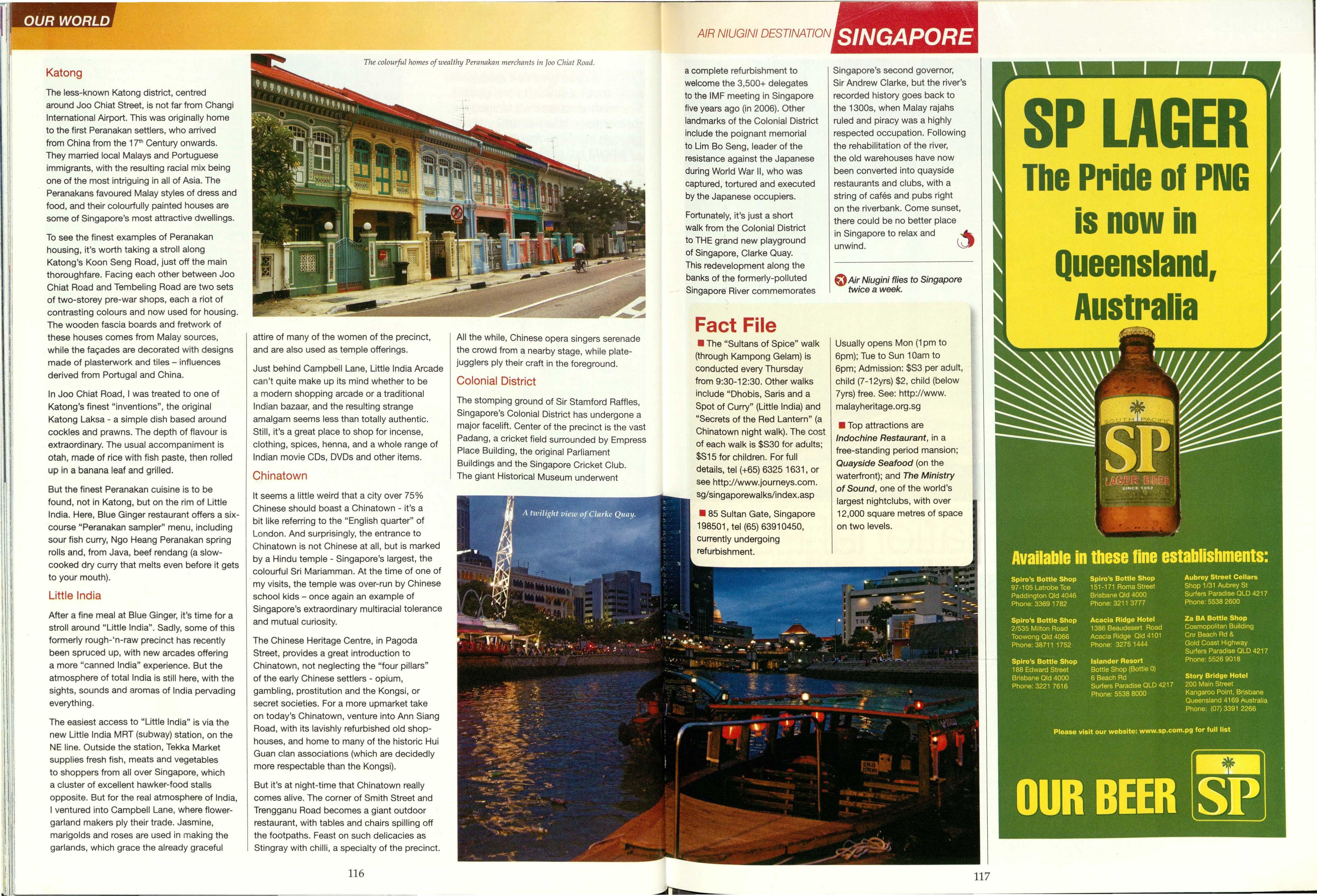
BY MARIE BARBIERI
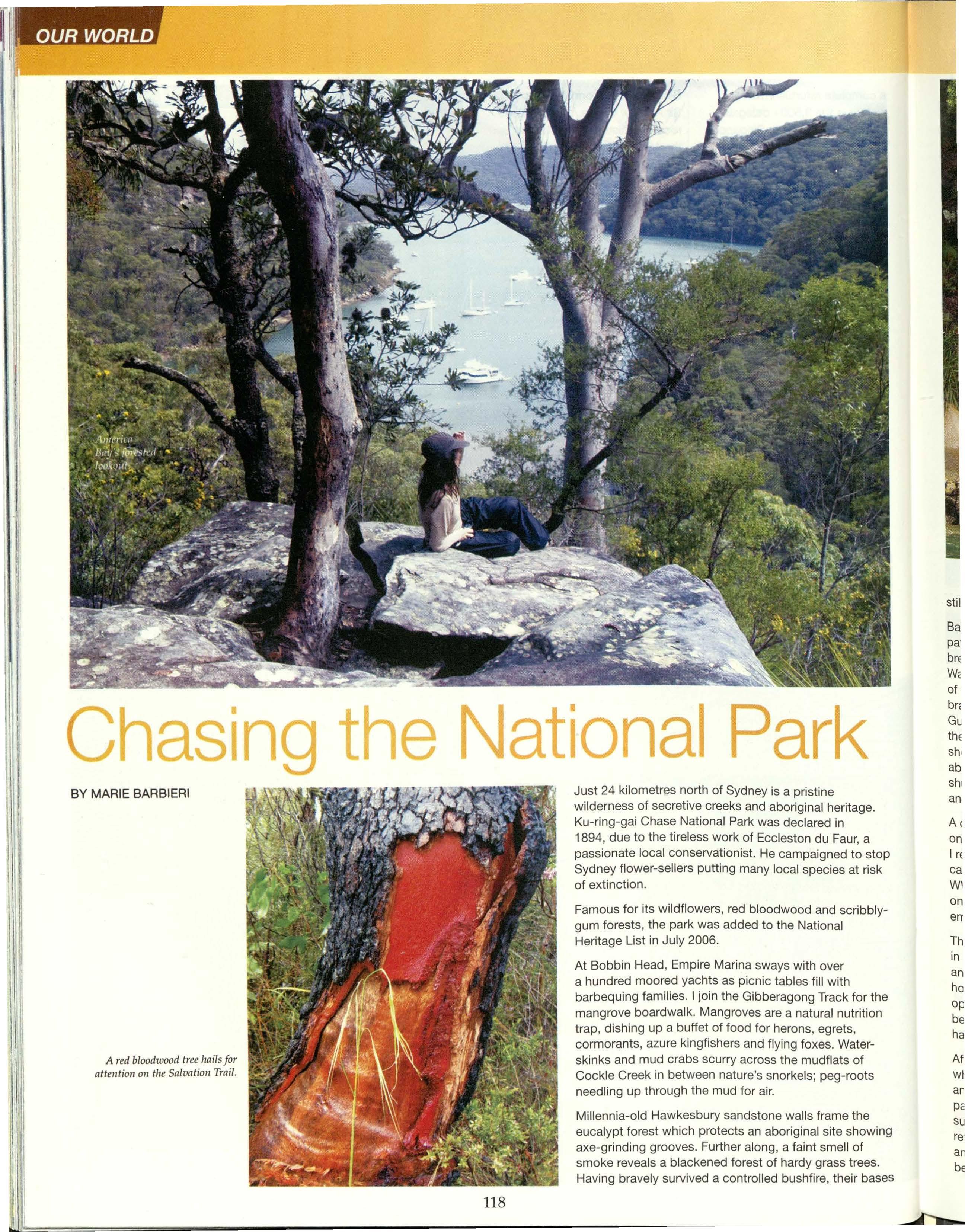
Just 24 kilometres north of Sydney is a pristine wilderness of secretive creeks and aboriginal heritage. Ku-ring-gai Chase National Park was declared in 1894, due to the tireless work of Eccleston du Faur, a passionate local conservationist. He campaigned to stop Sydney flower-sellers putting many local species at risk of extinction.
Famous for its wildflowers, red bloodwood and scribblygum forests, the park was added to the National Heritage List in July 2006.
At Bobbin Head, Empire Marina sways with over a hundred moored yachts as picnic tables fill with barbequing families. I join the Gibberagong Track for the mangrove boardwalk. Mangroves are a natural nutrition trap, dishing up a buffet of food for herons, egrets, cormorants, azure kingfishers and flying foxes. Waterskinks and mud crabs scurry across the mudflats of Cockle Creek in between nature's snorkels; peg-roots needling up through the mud for air.
Millennia-old Hawkesbury sandstone walls frame the eucalypt forest which protects an aboriginal site showing axe-grinding grooves. Further along, a faint smell of smoke reveals a blackened forest of hardy grass trees. Having bravely survived a controlled bushfire, their bases
still smoulder like Rotoruan mud pools.
Back at Bobbin Head where fishermen patiently await their shrimp, squid, snapper, bream and flathead, I take the creek-side Warrimoo Track. The landscape is a tangle of forest and wading mangroves, with lush bracken-fern, widely consumed by the Guringai people, peeping out from behind the rocks. The trail cuts through aboriginal shell middens, which, in practice, were the aboriginal 'kitchens' where shellfish were shucked and fish filleted; the discarded shells and bones solidifying into midden heaps.
A couple of hours later, my thighs-on-fire take on the final 1km-ascent on the Sphinx Track. I reach the majestic Sphinx War Memorial, carved from local sandstone by the returning WWI soldier, Private William Shirley. Looking on are vibrant-red waratah flowers; the floral emblem of NSW.
The next morning I head up to West Head in search of the famous Red Hands Cave, an important aboriginal site hidden in a honeycombed rock overhang. Inside this open-air gallery, indigenous artists have left behind eye-catching ochre stencils of red hands, believed to be around 2000 years old.
After lunch, I follow the Salvation Loop Trail, Wherewildflowers around this hanging swamp and grassy woodland glow like an artist's Palette. Honeyeaters busily seize generous supplies of banksia to a chorus of croaks from refusing-to-be-seen frogs. But it's the boronia and spider flowers that hail for most attention between the bloodiest of red bloodwood trees.

Further north, I join the America Bay Track, journeying through scribbly-gum woodlands, bush pea, grevillea and mountain devil flowers that line the path. A shower rains down over moss-covered steps and sand-covered tree roots. I reach a stream, stained in all shades of iron oxide-red, but I tell the child in me that it's too slippery to play stepping-tones today.
The increasing sound of a thunderous waterfall beckons until the mangled trees part to reveal a splendid yacht-dotted lookout. Rock ledges and platforms pockmarked with mini rockpools appear to my right, hurling orange-hued waters down the 30 metre-high assault into
America Bay. Acoustic paradise!
Today, begins with a classic cruising experience, plying the park's arterial waterways on the MV Reliance. This 91-yearold polished-timber ferry is as handsome as its skipper. Mark Farrell cruises her along Cowan Creek, and up close to the swirling oranges of sandstone rocks that paint the banks, with 600-year-old grass trees sprouting from them. Their stalks were used by aboriginals for spear-hunting and fire-starting. Their leaves were eaten and their bases produced a glue-like substance used for canoe-making.
With LionIsland lying to our left, the BouddlNational Parkon the CentralCoastbeyond,and Ba"enjoey Head before us, this must surelybe the mostjaw-dropping 11lewlnNSW.
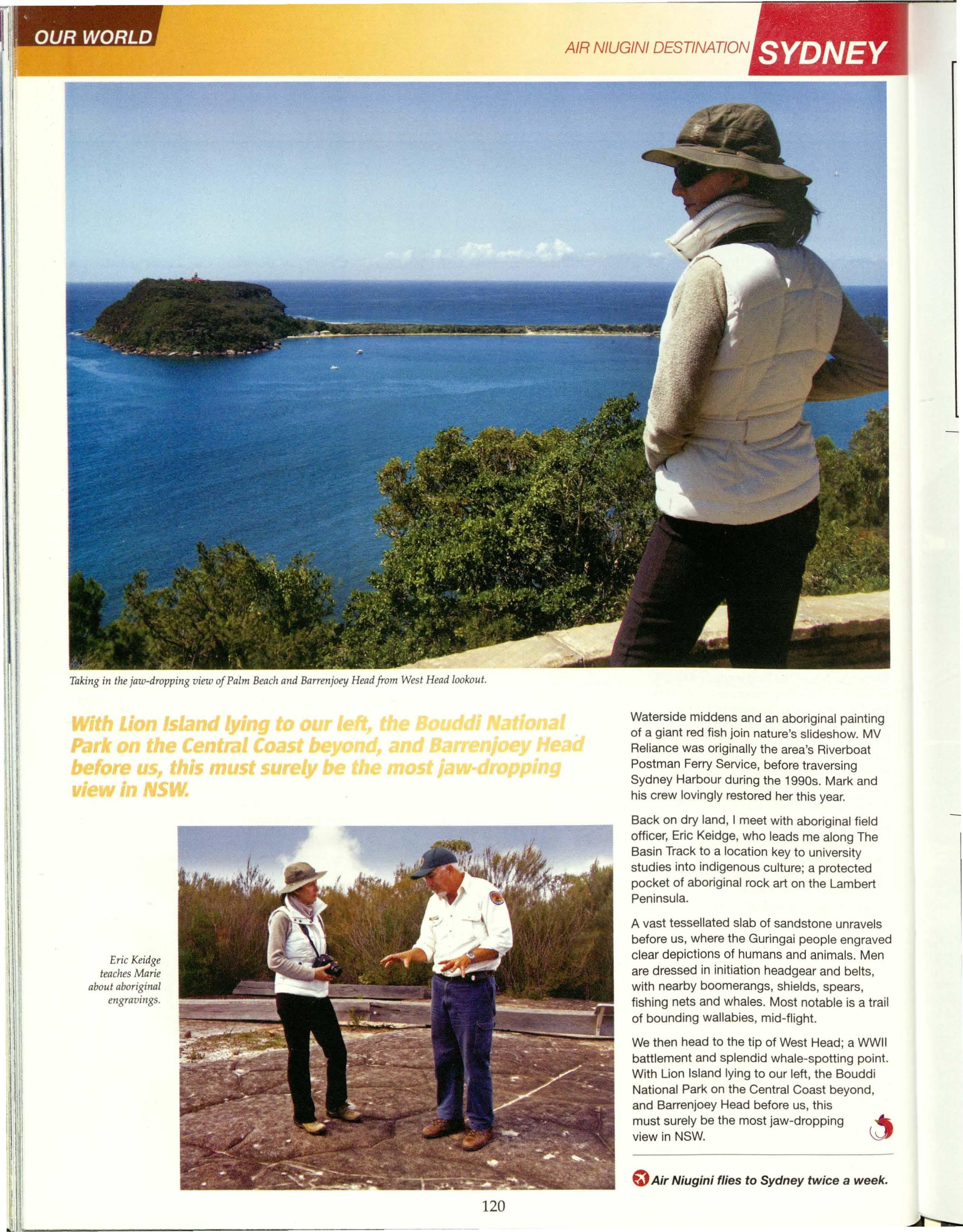
Eric Keidge teachesMarie aboutaboriginal engravings.
Waterside middens and an aboriginal painting of a giant red fish join nature's slideshow. MV Reliance was originally the area's Riverboat Postman Ferry Service, before traversing Sydney Harbour during the 1990s. Mark and his crew lovingly restored her this year.
Back on dry land, I meet with aboriginal field officer, Eric Keidge, who leads me along The Basin Track to a location key to university studies into indigenous culture; a protected pocket of aboriginal rock art on the Lambert Peninsula.
A vast tessellated slab of sandstone unravels before us, where the Guringai people engraved clear depictions of humans and animals. Men are dressed in initiation headgear and belts, with nearby boomerangs, shields, spears, fishing nets and whales. Most notable is a trail of bounding wallabies, mid-flight.
We then head to the tip of West Head; a WWII battlement and splendid whale-spotting point. With Lion Island lying to our left, the Bouddi National Park on the Central Coast beyond, and Barrenjoey Head before us, this must surely be the most jaw-dropping • view in NSW.
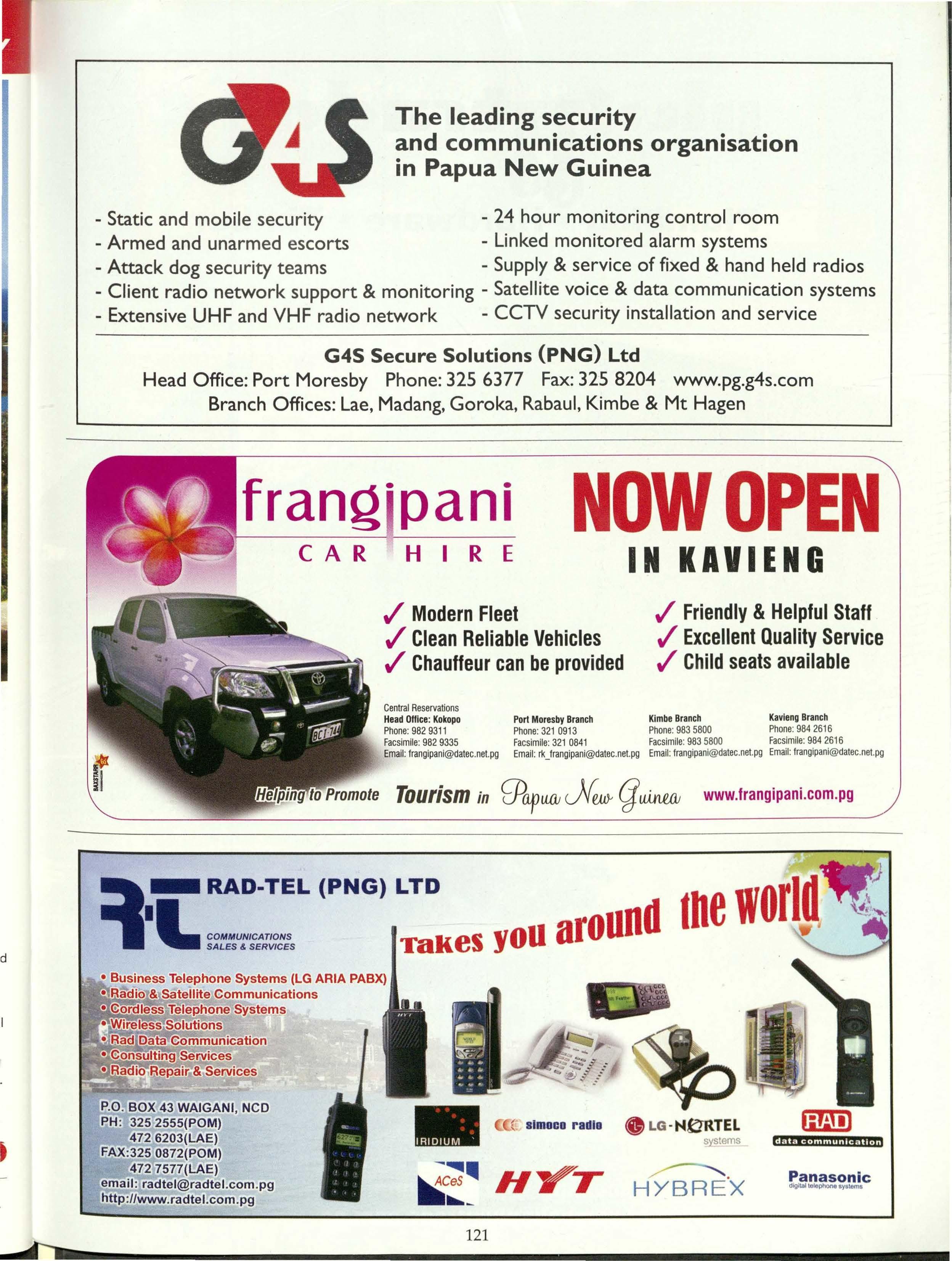
The leading security and communications organisation in Papua New Guinea
- Static and mobile security - 24 hour monitoring control room
- Armed and unarmed escorts - Linked monitored alarm systems
- Attack dog security teams - Supply & service of fixed & hand held radios
- Client radio network support & monitoring - Satellite voice & data communication systems
- Extensive UHF and VHF radio network - CCTV security installation and service
G4S Secure Solutions (PNG) Ltd
Head Office: Port Moresby Phone: 325 6377 Fax: 325 8204 www.pg.g4s.com
Branch Offices: Lae, Madang, Goroka, Rabaul, Kimbe & Mt Hagen
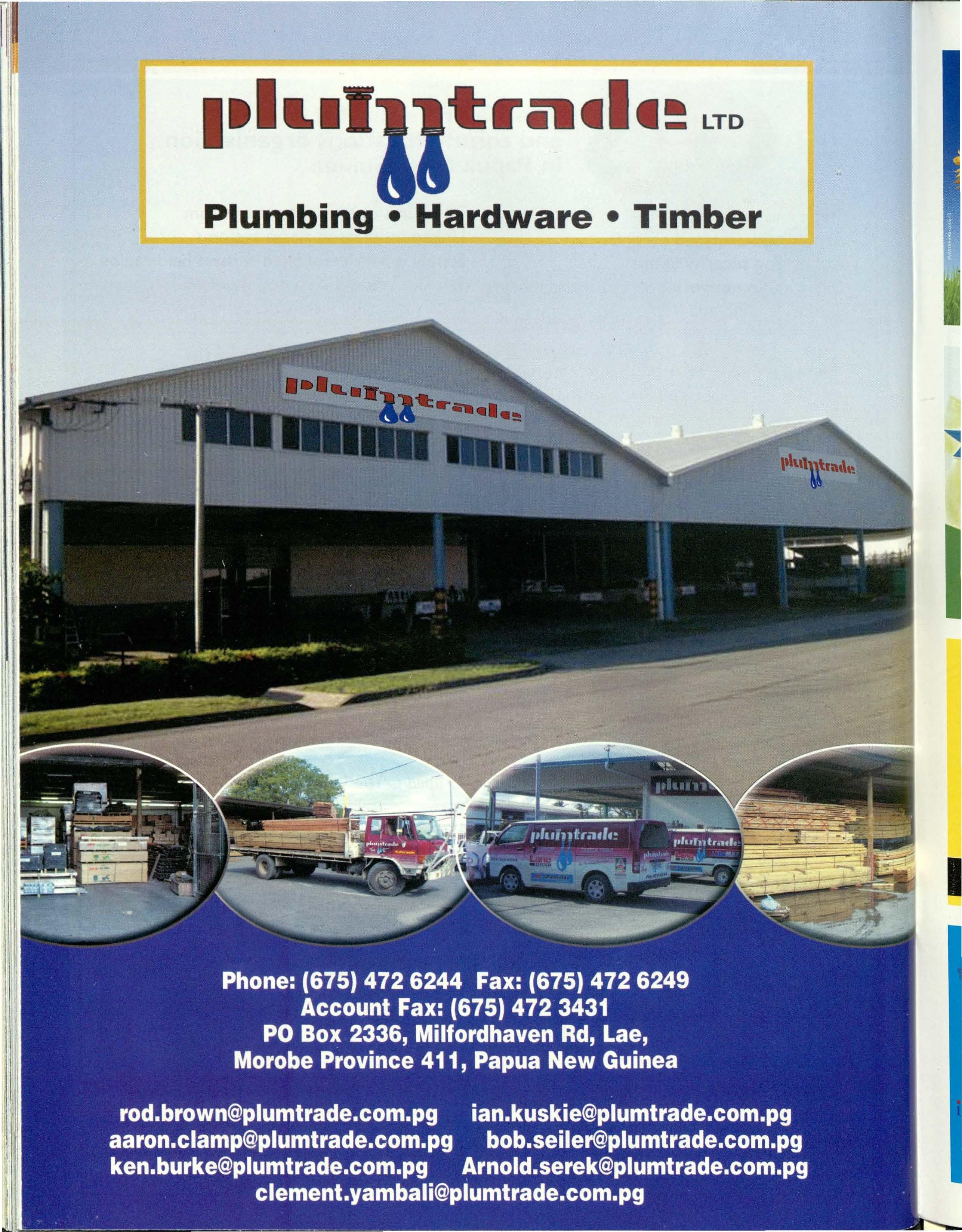
• Flat Racks
• Open Tops
• ISO Tanks

• General Purpose
• Pottable Buildings
• Refrigerated
Andyouneedit...
Whatis it? Information - that'swhat.It'sverysimplereally.Tomaketheproperchoicesin yourbusiness youneedinformation.Thesortof in-depth,accurate,professionally-writteninformationonthePacificthat youneedto makeaninformeddecision. Andthat'sour business.
YouseeIslandsBusinessis the premiermonthlynews,currentaffairsandbusinessmagazineof the Fiji IslandsBusinessis for Fiji.It notonlygivesyouthe informationyouwant- it givesyouinformationyou needandjustas importantly,informationyoucanrelyon. Andyoucanonlygetit from us.Sonowthatyouhavetwothings- thatyouneedthisinformationandthat we'vegot it - makeyourfirst informeddecisionandsubscribeto IslandsBusiness. Becauseyouneedto knowexactlywhat'sgoingon.
Tosubscribe,completethe form belowandreturnit to IslandsBusinessInternational,46 GordonStreet, POBox 12718,Suva,Fiji Islands,SouthPacific.Fax:(679)3301423.E-mail:subs@ibi.com.fj
Pleaseprint in blockcapitals
Name _________________
Address-----------------------------Country
MethodofPayment:
O Cheque O Bank Draft
O American Express
Account Number
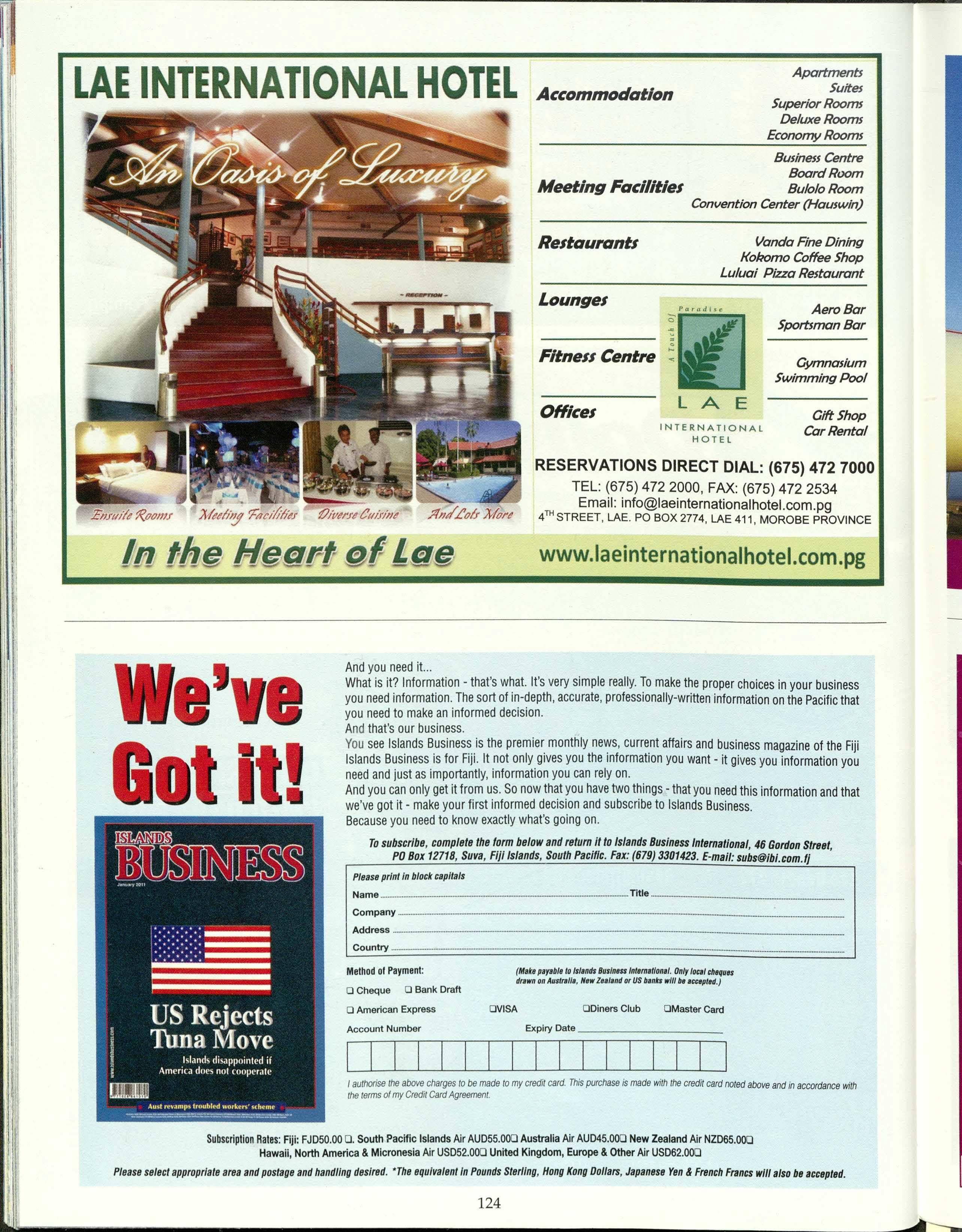
(Makepayablsto/sfandtBusinesslntsrn1tlon1/.Onlylocalcheques drawnan Austral/a,NswZealandor USbankswll/ bt acnptad.)
Club Card
Expiry Date
f authorisetheabovechargesto be madeto mycreditcard.Thispurchaseis madewiththecreditcardnotedaboveandin accordancewith thetermsof myCreditCardAgreement.
For those passengers who require to transfer to an Air Niugini domestic flight, firstly clear customs and then call at our transfer counter in the Concourse area, alongside the international check-in counters. Our courteous staff will check in
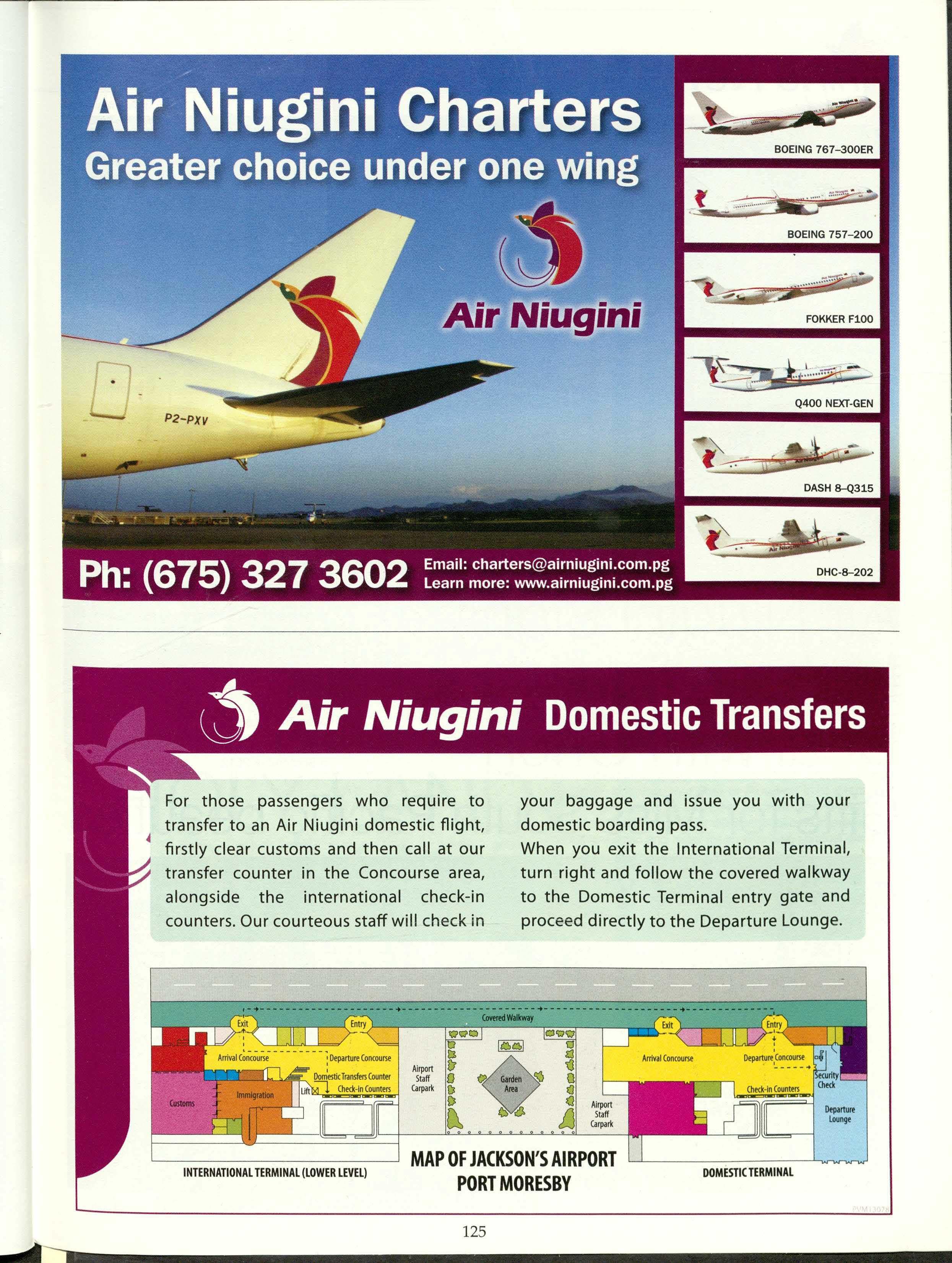
your baggage and issue you with your domestic boarding pass.
When you exit the International Terminal, turn right and follow the covered walkway to the Domestic Terminal entry gate and proceed directly to the Departure Lounge.

ir Niugini and Orion Project Services have signed a multi-million kina deal which will see the establishment of a Travel Unit at Orion's head officl'! in Port Moresby. Orion Project Services is involved in the recruitment of personnel for major contracts connected with the LNG Project.
The setting up of the Travel Unit provides a comprehensive 24 hours a day, 7 days a week service for Orion's clients on request of their travel needs.
The agreement also allows Air Niugini to provide ongoing technical support and familiarisation training to Orion staff. The airline will install the Gabriel Reservation System which allows Orion staff to have access to Air Niugini flights, fares on the airline's direct services and fares with partner airlines.
Orion staff can make, retrieve, change and cancel bookings and issue tickets on Air Niugini and partner airlines on a first come, first served basis.
Air Niugini will provide the system software for the Travel Unit with ongoing technical support and all the necessary accountable documents to allow Orion to issue airline tickets. All access and functions in using the system will be overseen by a sales co-ordinator, located at the Port Moresby Travel Centre.
Air Niugini operates a ticketing and IT Help Desk to support the sales environment and these services will be available to assist the Orion Travel Unit.
The two-year agreement will be reviewed in September 2012.
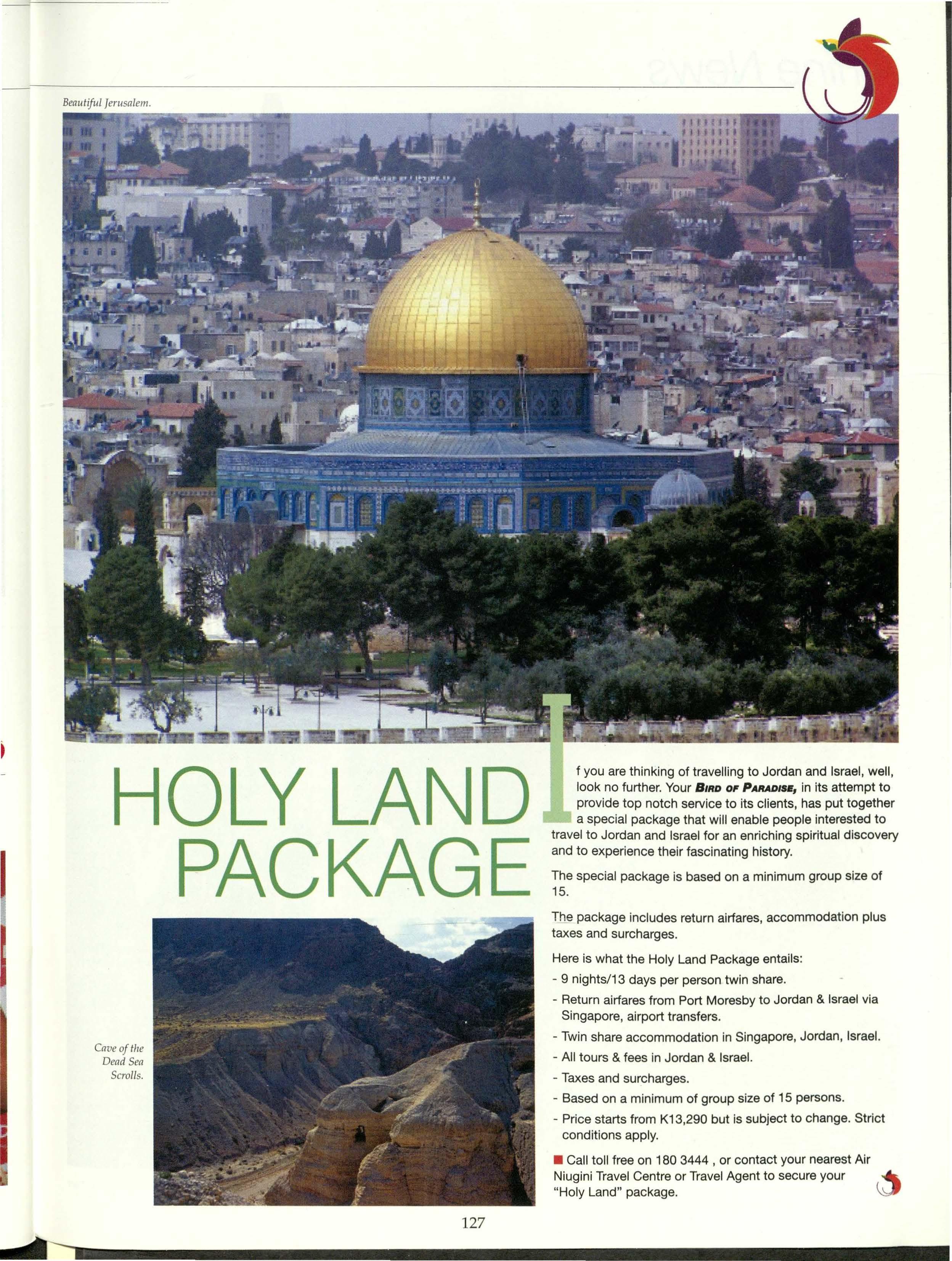
f you are thinking of travelling to Jordan and Israel, well, look no further. Your BIRDo, PARAD1s. 1 in its attempt to provide top notch service to its clients, has put together a special package that will enable people interested to travel to Jordan and Israel for an enriching spiritual discovery and to experience their fascinating history.
The special package is based on a minimum group size of 15.
The package includes return airfares, accommodation plus taxes and surcharges.
Here is what the Holy Land Package entails:
- 9 nights/13 days per person twin share.
- Return airfares from Port Moresby to Jordan & Israel via Singapore, airport transfers.
- Twin share accommodation in Singapore, Jordan, Israel.
- All tours & fees in Jordan & Israel.
- Taxes and surcharges.
- Based on a minimum of group size of 15 persons.
- Price starts from K13,290 but is subject to change. Strict conditions apply.
Call toll free on 180 3444 , or contact your nearest Air Niugini Travel Centre or Travel Agent to secure your ...._ "Holy Land" package.
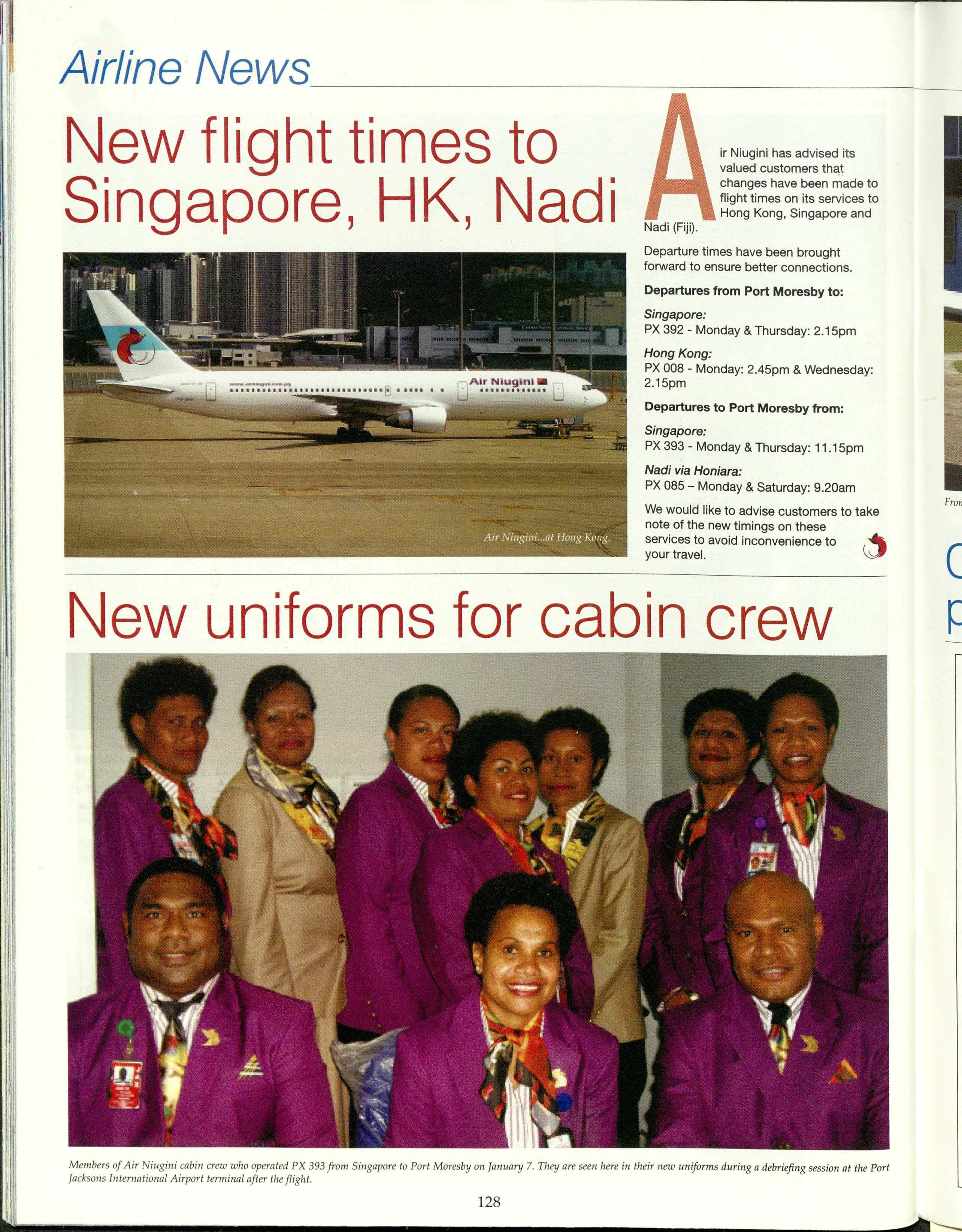
ir Niugini has advised its valued customers that changes have been made to flight times on its services to Hong Kong, Singapore and
Nadi (Fiji).
Departure times have been brought forward to ensure better connections.
Departures from Port Moresby to:
Singapore: PX 392 - Monday & Thursday: 2.15pm
Hong Kong: PX 008 - Monday: 2.45pm & Wednesday: 2.15pm
Departures to Port Moresby from:
Singapore: PX 393 - Monday & Thursday: 11.15pm
Nadi via Honiara: PX 085 - Monday & Saturday: 9.20am
We would like to advise customers to take note of the new timings on these services to avoid inconvenience to your travel.
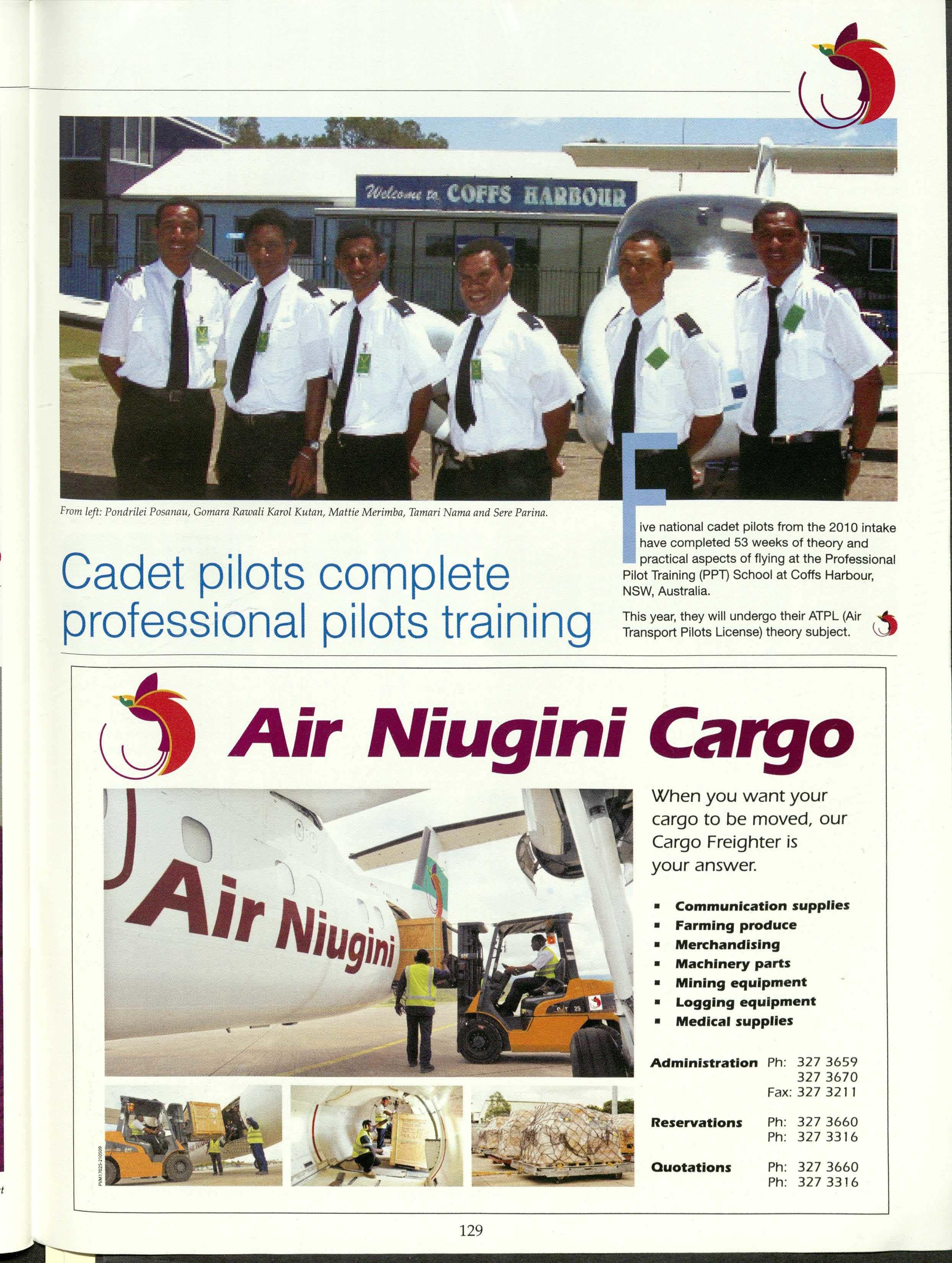
ive national cadet pilots from the 201 O intake have completed 53 weeks of theory and practical aspects of flying at the Professional Pilot Training (PP1) School at Coffs Harbour, NSW, Australia.
This year, they will undergo their ATPL (Air Transport Pilots License) theory subject.
When you want your cargo to be moved, our Cargo Freighter is your answer.
Lying entirely within the tropics, barely south of the Equator and just north of the Australian continent is Papua New Guinea, the second largest island in the world. With a total land mass of 473.189sq.km it is the last of a string of Islands spilling down from South East Asia into the Pacific.
Apart from the mainland, Papua New Guinea comprises a remarkable collection of islands, atolls and coral reefs scattered around its coastline. The mainland is divided by the Owen Stanley Range-a rugged central spine with peaks over 4,000 metres high. Great rivers begin their journey to the sea from these mountains-among them, Fly and Sepik waterways. Below the mountain chain, fertile coastal plains, flooded delta regions and mangrove swamps exist alongside broad sandy beaches, sheltered bays and dense rain forests.
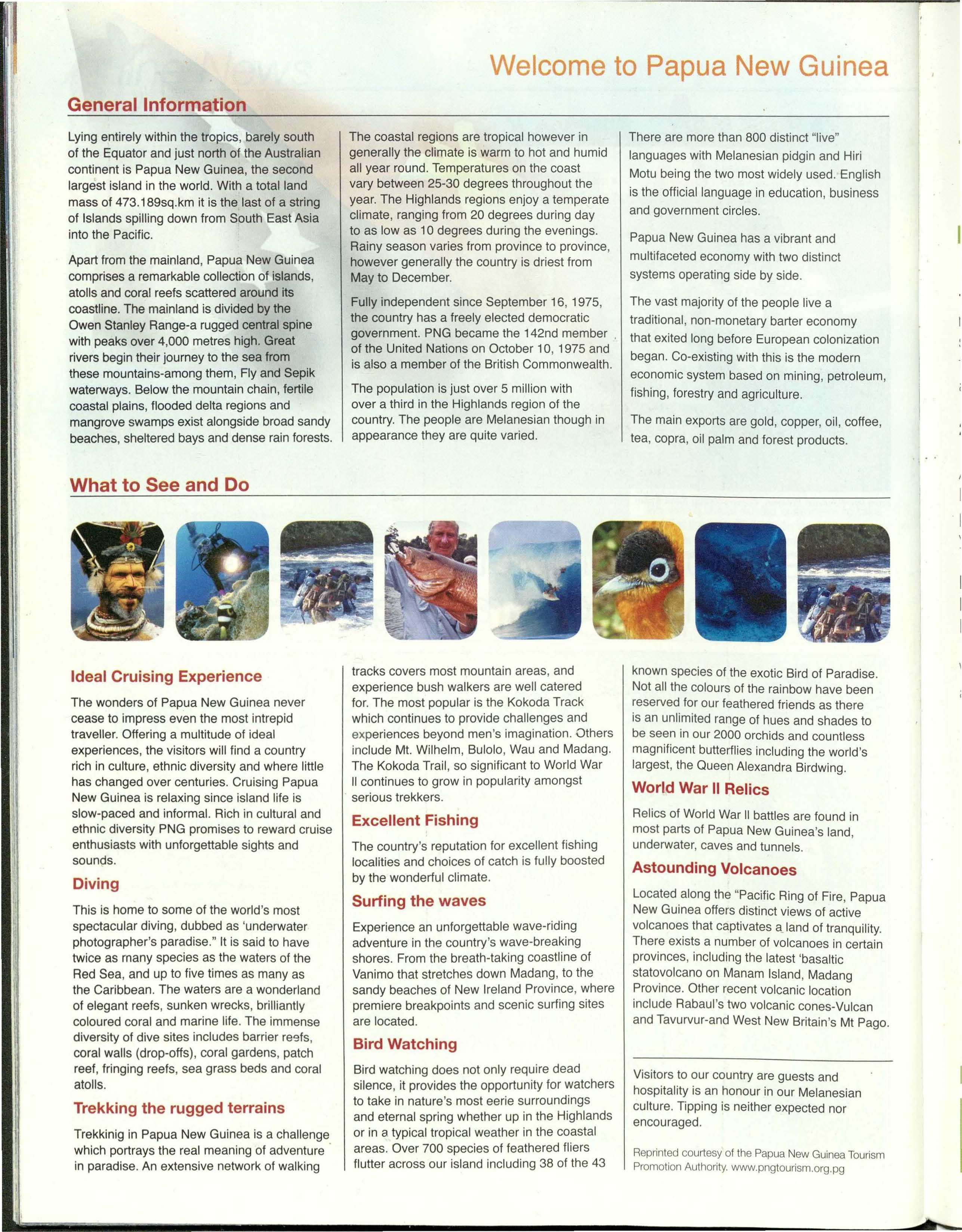
The wonders of Papua New Guinea never cease to impress even the most intrepid traveller. Offering a multitude of ideal experiences, the visitors will find a country rich in culture, ethnic diversity and where little has changed over centuries. Cruising Papua New Guinea is relaxing since island life is slow-paced and informal. Rich in cultural and ethnic diversity PNG promises to reward cruise enthusiasts with unforgettable sights and sounds.
This is home to some of the world's most spectacular diving, dubbed as 'underwater photographer's paradise." It is said to have twice as many species as the waters of the Red Sea, and up to five times as many as the Caribbean. The waters are a wonderland of elegant reefs, sunken wrecks, brilliantly coloured coral and marine life. The immense diversity of dive sites includes barrier rests, coral walls (drop-offs), coral gardens, patch reef, fringing reefs, sea grass beds and coral atolls.
Trekkinig in Papua New Guinea is a challenge which portrays the real meaning of adventure • in paradise. An extensive network of walking
The coastal regions are tropical however in generally the climate is warm to hot and humid all year round. Temperatures on the coast vary between 25-30 degrees throughout the year. The Highlands regions enjoy a temperate climate, ranging from 20 degrees during day to as low as 1O degrees during the evenings. Rainy season varies from province to province, however generally the country is driest from May to December.
Fully independent since September 16, 1975, the country has a freely elected democratic government. PNG became the 142nd member of the United Nations on October 10, 1975 and is also a member of the British Commonwealth.
The population is just over 5 million with over a third in the Highlands region of the country. The people are Melanesian though in appearance they are quite varied.
There are more than 800 distinct "live" languages with Melanesian pidgin and Hiri Motu being the two most widely used. English is the official language in education, business and government circles.
Papua New Guinea has a vibrant and multifaceted economy with two distinct systems operating side by side.
The vast majority of the people live a traditional, non-monetary barter economy that exited long before European colonization began. Co-existing with this is the modern economic system based on mining, petroleum, fishing, forestry and agriculture.
The main exports are gold, copper, oil, coffee, tea, copra, oil palm and forest products.
tracks covers most mountain areas, and experience bush walkers are well catered for. The most popular is the Kokoda Track which continues to provide challenges and experiences beyond men's imagination. Others include Mt. Wilhelm, Bulolo, Wau and Madang. The Kokoda Trail, so significant to World War II continues to grow in popularity amongst serious trekkers.
The country's reputation for excellent fishing localities and choices of catch is fully boosted by the wonderful climate.
Experience an unforgettable wave-riding adventure in the country's wave-breaking shores. From the breath-taking coastline of Vanimo that stretches down Madang, to the sandy beaches of New Ireland Province, where premiere breakpoints and scenic surfing sites are located.
Bird watching does not only require dead silence, it provides the opportunity for watchers to take in nature's most eerie surroundings and eternal spring whether up in the Highlands or in a typical tropical weather in the coastal areas. Over 700 species of feathered fliers flutter across our island including 38 of the 43
known species of the exotic Bird of Paradise. Not all the colours of the rainbow have been reserved for our feathered friends as there is an unlimited range of hues and shades to be seen in our 2000 orchids and countless magnificent butterflies including the world's largest, the Queen Alexandra Birdwing.
Relics of World War II battles are found in most parts of Papua New Guinea's land underwater, caves and tunnels. '
Located along the "Pacific Ring of Fire, Papua New Guinea offers distinct views of active volcanoes that captivates a_land of tranquility. There exists a number of volcanoes in certain provinces, including the latest 'basaltic statovolcano on Manam Island, Madang Province. Other recent volcanic location include Rabaul's two volcanic cones-Vulcan and Tavurvur-and West New Britain's Mt Pago.
Visitors to our country are guests and hospitality is an honour in our Melanesian culture. Tipping is neither expected nor encouraged.
Reprinted courtesy of

1. Obtain"AWelcomeGuideto PortMoresby"- the most comprehensiveand up-to-date information source containingeverythingyou need to know to be successful in PNG, and how to manage and enjoy your business and private life.
2. Talkto BSP today.
A new environmentis a challenge to work and livein. It can be difficultto know which bank can provide you the security and banking services you'll need.
BSP can help you make the most out of your PNGexperience.Bank with confidencewith the largest bank in Papua New Guinea.
With more knowledge of the PNG environment and global expertise,we are your bank.

Toyota Motor Vehicles
Yamaha Marine & Power Products
Hino & Renault Trucks
Massey Ferguson Tractors
Genuine Parts & Quality Service
Panel Beating & Spray Painting
Tyres, Batteries & TJM Accessories
16 Branches Nationwide